





|  |
 |
|
 |
 | |
| |
Posters
4th World Congress of Veterinary Dermatology Antimicrobial Activity in vitro of Shampoos Containing Chlorhexidine and Miconazole Combined, and Chlorhexidine Alone (Lloyd, D.H. and Lampert, A.T) more...
| | | | |
Pneumothorax in cats with `feline asthma`
5 out of 421 cats with `feline asthma` presented to the Veterinary Hospital of the University of Pennsylvania from 1990 to 2000 showed concurrent pneumothorax. Diagnosis and therapy are discussed in this report.
Of 421 cases of feline asthma, 5 cats fulfilled the inclusion criteria (1.2%). All 5 had respiratory distress at presentation. One cat was panting, and the other 4 cats had respiratory rates of 28, 52, 58 and 120 breaths per minute (bpm), respectively (mean RR 65±39 bpm). Historical findings included untreated chronic cough (n=3), previously treated asthma (n=1), and no previous illness (n=1). Thoracocentesis was performed in 4/5 cats, and 3 of those cats required thoracostomy tubes. Four cats required immediate oxygen supplementation, and 1 of those cats required ventilation. All 5 cats had evidence of pneumothorax on initial radiographs. Follow-up radiographs revealed partial or complete resolution of pneumothorax in 4 cats which were discharged alive with total hospitalization of 2-7 days, but were then lost to follow-up. One cat was euthanized because it could not be weaned off mechanical ventilation, and necropsy confirmed end-stage feline asthma and emphysema.
Conclusion: Small airway obstruction can predispose asthma patients to increased alveolar pressure, emphysema, and spontaneous pneumothorax, which can lead to dyspnea in affected cats. The short-term outcome in these cats was good despite the severity of dyspnea at presentation.
Source: Cooper, E.S., Syring, R.S.,King, L.G. (2003): Pneumothorax in cats with a clinical diagnosis of feline asthma: 5 cases (1990-2000).
In: Journal of Veterinary Emergency and Critical Care 13 (2), 95-101.
http://www.blackwell-synergy.com/links/doi: 10.1046/j.1435-6935.2003.00081.x
| | | | |
Typhlocolitis of horses
Exchange of opinions and experiences. Select your Forum - Horse Medicine.
| | | | |
29th Congress of the World Small Animal Veterinary Association - WSAVA
Greece, 6-9 October 2004
| | | | |
Four EU Countries Still Failing Over Laying Hens
The European Commission has decided to refer Austria, Belgium, Greece and Italy to the European Court of Justice over their apparent failure to implement the 1999 Directive setting out the minimum standards for the protection of laying hens (1999/74/EC).
All Member States were obliged to implement the Directive in national law by 1 January 2002 and notify the Commission of the measures taken. The Member States concerned received a `reasoned opinion` in January 2003 but have still failed to implement the Directive, which is why the Commission has now decided to take them to the European Court of Justice.
`This Directive was introduced in order to better protect the welfare of hens kept in battery cages and other rearing systems,` said David Byrne, EU Commissioner for Health and Consumer Protection. `It is imperative that Member States live up to the obligations they have undertaken.`
Directive 1999/74/EC distinguishes three types of minimum conditions in rearing systems for laying hens:
enriched cages (with perches, a nest box and a littered area to allow pecking and scratching), where laying hens have at least 750 cm2 of cage area per hen
not enriched cage systems with 550 cm2 of cage area per hen (to be phased out before 2012)
non-cage systems with nests (at least one for 7 hens), adequate perches and where the stocking density does not exceed 9 laying hens per m2 usable area.
For further information on Directive 1999/74/EC see:
http://europa.eu.int/comm/food/fs/aw/aw_farm_layinghens_en.html
Source: www.animalscience.com
| | | | |
Skin Biology and Innovations in Dermatology
The Symposium on Skin Biology and Innovations in Dermatology took place in Juan Les Pins on 22nd March 2003. It was hosted and organized by Virbac, world leader in veterinary dermatology, to give active support to the development of clinical veterinary dermatology.
The 12 speakers of the Symposiom came from France, U.K. and Germany. The meeting was chaired by Dr. Dr.h.c. Hans Koch, President of the European College of Veterinary Dermatology - Germany.
Please view the presentations below by clicking on the titels.PART 1: CUTANEOUS BIOLOGY AND PHYSIOLOGY- Pr. Thomas BIEBER, University of Bonn, Department of Dermatology  Germany
Current concepts in the pathophysiology of atopic dermatitis in human
- Dr. Jacqueline VIAC, Inserm U 346, Lyon - France
Keratinocyte Activation
- Pr. David LLOYD, Professor of Veterinary Dermatology, Royal Veterinary College, North Mymms
Ecology & Microbial Balance of the Skin
- Dr. Peter HILL, Director of the Hospital for Small Animals, Department of Veterinary Clinical Studies, Royal School of Veterinary Studies, Roslin - Midlothian  UK -
The aetiopathogenesis of canine atopic dermatitis: 30 years on
PART 2: TOPICAL PRODUCT DEVELOPMENT:
WHAT ARE THE CURRENT CHALLENGES ?In human:
Current galenical research challenges in human dermatology:
applications for the development of products for sensitive and atopic skin.
In animal:
Galenical innovations in veterinary dermatology:
PART 3: THE ART OF SHAMPOOS IN VETERINARY DERMATOLOGY:
TREATMENT AND PREVENTION STRATEGIES
PART 4: DESIGNING A NEW RANGE OF TOPICAL PRODUCTS:
THE ALLERMYL STORY
The purpose of the Symposium was to review and summarise the present status of scientific knowledge in comparative immuno-dermatology and clinical researches on atopic dermatitis. Special emphasis was given to new innovations and developments, such as novel galenic formulations of topical products for the treatment of hyper-reactive skin.
The goals of the Symposium were:- to present a forum for the discussion of recent results and ideas among colleagues from practice and academia together with human dermatologists, scientists and researchers from the pharmaceutical industry;
- to facilitate communication and information sharing among leaders in the field; and
- to share `lessons learned` from others and explore how they can be applied to advance the discipline.
The moving forces behind this Symposium were the Virbac staff who are closely connected with veterinary dermatologists, and more precisely Dr Hugues Gatto, Development Manager for Dermatological products, who managed the scientific organisation of this symposium, and CĂ©cile CormorĂšche, Dermatological Range Manager, who handled all the logistical and organisational aspects.
The stature of those participating in this Symposium ensured a most successful meeting and excellent interaction. Everybody enjoyed the high level of competence as well as the delightful ambiance provided with professionalism and passion by the hosting company Virbac.
It is hoped that the presentations and proceedings will contribute to the advancement of veterinary dermatology throughout the world.
Hans KOCH
Dr. Dr.h.c., a.o. Professor, Diplomate ECVD (European College of Veterinary Dermatology)
All presentations of the Virbac Symposium
| | 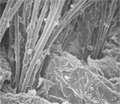
| | |
5th World Congress of Veterinary Dermatology 2004
From August 25th to 28th 2004, the 5th World Congress of Veterinary Dermatology will be held in the famous Hofburg in Vienna, an imperial Palace converted into a magnificant Congress Center. Both location and programme are outstanding - donÂŽt miss participating in this special celebration!
5th World Congress of Veterinary Dermatology
August 25th - 28th 2004
www.VetdermVienna.com
President: Dr. David Lloyd
Secretary: Dr. Regina Wagner
Treasurer: Mr. Craig Harrison
Scientific Program:
· State-of-the-art presentations and supporting papers
The Congress will have five main themes with state-of-the-art presentations and supporting papers presenting the latest information by the worldÂs leading authorities:
Immunology
focus on atopy
Therapy
focus on immunomodulatory drugs
Infectious & parasitic dermatosis
focus on mycobacteria
Skin biology
focus on wound healing
Nutrition
focus on antioxidants & free radicals
· Workshops
Work shops (approximately 15): interactive presentation and discussion of the latest information on specific topics in small groups and Âhands-on practical work shops in selected subjects of discourse. Anticipated topics include:
· Equine allergy/hypersensitivity/skin testing
· Parasitic/antiparasitic
· Malassezia in cats/dirty face
· Genodermatoses/alopecias/hypotrichoses/Alopecia X
· Neoplastic skin diseases/paraneoplastic
· Otitis/pseudomonas
· Food allergy/hydrolyzed vs limited antigen
· New therapies for atopy/NSAID/modulators
· New dermatopathological diseases
· Leishmaniosis/arthropod vectors
· Recurrent pyoderma/immunostimulants
· Hypothyroidism diagnosis
· Shampoo/topical therapies
· Continuing education
Continuing education on two levels: advanced level for veterinarians with special interest in dermatology and comprehensive level for general practitioners. Topics will include diagnosis and therapy of dermatological conditions, a special wound healing session, and a dermatopathology session.
· Clinicopathological presentations
Clinicopathological presentations: an interactive session involving outstanding clinicians and pathologists. A full day dermato-histopathology session organised by ISVD (International Society of Veterinary Dermatopathology)
· Free communications and posters
Free communications and posters: the leading edge in all areas of the discipline.
· Special Japanese Programme
Special Japanese programme: The worldÂs leading authorities speak about the newest development in diagnosis and therapy of dermatological conditions. A translation for these special sessions is supplied.
· Special Programme for Veterinary Nurses and Technicians
Hints and skills for paraveterinarians.
| | 
| | |
The effect of the removal of the third eyelid gland on the ocular surface of dogs
The surgical removal of the third eyelid gland is still performed in many small animal practices. One common indication is the eversion of the third eyelid gland. Japanese colleagues evaluated what happens on the ocular surface of healthy dogs after this type of surgery.
To evaluate the effect of third eyelid removal on the ocular surface of dogs, we operated on five young Beagle dogs and observed changes to tear function using the following tests: phenol red thread test (PRT), Schirmer tear test (STT-1), modified Schirmer tear test (STT-2), pH and tear break-up time (BUT).
There was a significant decrease (37%) in STT-2 within 2 weeks after the excision and this declined further to 60% at 1 year. The pH value increased after excision. Presurgical pH was 7.17 ± 0.20 (mean ± SD), which increased to 7.55 ± 0.24 in the 14-60 days following removal, and further increased to 7.77 ± 0.65 at 1 year. The PRT and STT-1 decreased by 26% within 3-7 months compared to pre-excision values, but by 1 year the values recovered to near normal. The BUT pre-excision value was 24.0 ± 8.1 s, which shortened to 13.5 ± 4.5 s after 5 months and continued to decrease further during the study.
There were no overt visual signs of KCS during the observational period. However, microinjury of the keratoconjunctival epithelium was observed for all operated eyes when vital staining was used at 1 year post surgery. Surgical excision of the third eyelid in Beagle dogs influenced tear quality level and affected the stability of the tear layer, and at 1 year there was evidence of microinjury to the keratoconjunctival epithelium.
Source: Saito, A., Izumisawa, Y., Yamashita, K., Kotani, T.(2001): The effect of third eyelid gland removal on the ocular surface of dogs. In: Veterinary Ophthalmology 4 (1), pp 13-18.
www.blackwell-synergy.com/links/doi: 10.1046/
j.1463-5224.2001.00122.x
| | | | |
Ruptured cranial cruciate ligament - comparison of fixation methods
Monofilament nylon leader line (MNL) is a popular prosthetic material used by veterinary surgeons for extra-capsular cranial cruciate ligament repair. Careful examination of MNL fixation methods has been reported, but a comprehensive comparison has not been done.
This study evaluated three unpublished novel methods of MNL loop fixation [Harris wire tightener (knotter), Securos(R) crimp damp system, self-locking knot] to traditional methods of MNL loop fixation (clamped square knot, sliding half hitch knot). Loops (27.3 kgt and 36.4 kgt) were distracted at 500 mm/min until failure by breaking or slipping. Ultimate force, elongation and stiffness were used for comparison of loop fixation methods. All of the loops failed by breaking within 3.0 mm of knot or clamp.The Harris knotter had significantly greater elongation than all other loops, except for the self-locking knot. The self-locking knot required the most force to failure; however, it was not superior if the double-stranded configuration was considered. If the mechanical properties of the knot method is considered in light of the subjective handling characteristics, the Securos(R) crimp clamp system had equivalent strength measurement for the 27.3 kgt MNL loops and was stronger than traditional methods using the 36.4 kgt MNL. The Securos(R) system recommends use of the larger diameter MNL and it allows a surgeon to overcome potential difficult handling characteristics previously encountered with knot formation and security.
Source: Peycke,LE, Kerwin, SC, Hosgood,G, Metcalf, JB (2002): Mechanical comparison of six loop fixation methods with monofilament nylon leader line. In: Veterinary and Comparative Orthopaedics and Traumatology, 2002, Vol 15, Iss 4, pp 210-214
| | | | |
West Nile virus vaccine gives promising results in monkeys
Scientists at the National Institute of Allergy and Infectious Diseases (NIAID) have created a promising vaccine against West Nile virus by replacing parts of a distantly related virus with proteins from the West Nile virus. Human clinical trials of the vaccine are expected to begin before the end of 2003.
The NIAID research team replaced proteins in a virus known as dengue type 4 with the corresponding West Nile virus proteins, creating a hybrid virus vaccine that protects monkeys from West Nile infection.
`The Department of Health and Human Services has responded vigorously to emerging infectious diseases, including West Nile Virus, and we aim for the earliest and best possible protection for Americans,` says HHS Secretary Tommy G. Thompson. `We will continue aggressive research and development steps, and we will continue to work with our public health partners toward preventing mosquito-borne disease and ensuring effective prevention and treatment.`
`West Nile is one of the emerging infectious diseases for which we are developing novel preventive and therapeutic tactics,` says NIAID Director Anthony S. Fauci, M.D. `Because our researchers have more than a decade of experience working with this class of virus, they could respond very quickly to the urgent public health need for a promising West Nile virus vaccine.`
Human clinical trials of the vaccine are expected to begin before the end of 2003. `We`re optimistic that our engineered virus vaccine will provide long-term immunity to West Nile virus, but the human clinical trials will give us the definitive data,` says Brian Murphy, M.D., of the NIAID Laboratory of Infectious Diseases.
West Nile virus is spread to people by mosquitoes. It usually produces mild, flu-like symptoms but can cause a deadly encephalitis, or inflammation of the brain. The virus was first detected in the United States in 1999. Since then, it has spread rapidly from the north eastern United States throughout North America. Centers for Disease Control and Prevention statistics show that West Nile cases this year are quickly outpacing those for the same period in 2002. The disease is most severe among the elderly and has sickened 470 and claimed 10 lives in the United States this year.
The potential West Nile vaccine is a live but weakened virus. To create it, scientists took the dengue 4 virus and replaced its outer shell proteins with corresponding proteins from West Nile virus, explains Alexander Pletnev, Ph.D., lead investigator and NIAID molecular biologist.
Dr. Pletnev and colleagues at NIAID developed the strategy of mixing parts of one virus with another to form chimeric viruses for use as vaccines in 1991. They found that this approach could cripple the disease-causing virus but still trigger a strong immune response against it.
To ensure the safety of the chimeric virus in humans, the scientists further weakened the West Nile/dengue 4 virus by deleting some of the genetic material, RNA in this case, from the dengue virus. With this deletion, the chimeric virus was less able to replicate itself when injected into the monkeys. Even though it was further weakened in its ability to replicate in the monkeys, the monkey immune system was still able to produce protective antibodies against the West Nile virus proteins.
The scientists tested two versions of the West Nile/dengue 4 virus in rhesus monkeys, one with the entire dengue virus RNA and one with some of the dengue RNA deleted. By doing so, they proved that deleting some of the dengue RNA weakened it even further.
NIAID scientists gave one or the other of the two chimeric virus vaccines to 12 monkeys and then measured the monkeys` antibodies to both West Nile and dengue 4 virus. They also simultaneously injected eight other monkeys with either West Nile virus or dengue 4 virus for comparison.
After six weeks, the scientists injected West Nile virus into all 20 monkeys. The 12 monkeys that received a version of the West Nile/dengue 4 virus developed high levels of neutralizing antibodies that successfully fought the West Nile virus.
Because it was less able to replicate, the West Nile/dengue 4 virus with the RNA deletion will be the first one used in the planned clinical trials in humans. Scientists favour this virus as a vaccine because it triggered high levels of West Nile antibodies and did not produce measurable levels of virus in monkeys. It could provide life-long immunity against West Nile virus and would be highly unlikely to mutate into a disease-causing virus. It is also not likely to be passed via mosquitoes to birds or other animals.
Source: A Pletnev et al.: Molecularly engineered live-attenuated chimeric West Nile/dengue virus vaccines protect rhesus monkeys from West Nile virus. Virology, in press. Available online at http://www.sciencedirect.com.
http://www.vetscite.org
| | | | |
Sudden blindness in a dog (case report)
A male mixed breed dog of unknown age was presented with sudden onset of blindness and a slightly exophthalmic right eye. Ophthalmoscopically, a spherical, pinkish mass protruding from the region of the optic disc into the vitreous was seen in the right eye. How would you proceed?
Ultrasound and computer tomography demonstrated an extension of the mass into the right retrobulbar space, continuing intracranially to the optic chiasm. Cytologic findings, obtained by ultrasound-guided fine needle aspiration from the retrobulbar space, were consistent with myxosarcoma. On the basis of these findings of a well-delineated mass in the brain stem area, irradiation was planned as the therapy of choice. The dog was treated under general anesthesia using a proton beam at the Paul Scherrer Institute (PSI, Villigen, Switzerland). A curative protocol (56 Gy in 16 fractions over 4 weeks, 3.5 Gy/fraction) was used. Twenty-seven days post radiation therapy the dog was euthanized, as clinical symptoms progressed. Enlargement of the intracranial tumor was seen on a CT study repeated on the day of euthanasia. A gross pathologic and histologic examination were performed and confirmed the diagnosis of a myxosarcoma involving the eye, retrobulbar space of the right side, and the optic chiasm. Post-mortem examination failed to identify any abnormalities or metastases elsewhere in the body.
Source: Richter, M., Stankeova, S., Hauser, B., Scharf, G., Spiess, B.M. (2003): Myxosarcoma in the eye and brain in a dog. In: Veterinary Ophthalmology 6 (3), pp 183-189.
www.blackwell-synergy.com/links/doi: 10.1046/
j.1463-5224.2003.00289.x
| | | | |
Acute pancreatitis in dogs - which lab tests give prognostic informations?
Canine acute pancreatitis is a life-threatening emergency with a mortality rate up to 50%. An australian study tried to find whether laboratory testing currently available is able to provide prognostic information in canine pancreatitis.
A prospective study of dogs with naturally occurring pancreatitis was undertaken.
Twenty-two cases with histologically confirmed pancreatic inflammation were included in the study. Each dog had routine haematology parameters, serum biochemistry (including lipase and amylase), serum trypsin-like immunoreactivity and trypsinogen activation peptides (TAP) in urine and plasma measured.
Twelve of the dogs were classified as having severe disease. These dogs had statistically significant increases in urinary TAP-creatinine ratio (UTCR) measurement, serum lipase, serum phosphate and serum creatinine concentrations. Additionally dogs with severe pancreatitis had significantly decreased urine specific gravity levels.
The most sensitive and specific test to assess the severity of pancreatitis was the measurement of UTCR.
Source: Mansfield,C.S.,Jones,R., Spillman, T. (2003): Assessing the severity of canine pancreatitis. In: Research in Veterinary Science, 2003, Vol 74, Iss 2, pp 137-144
| | | | |
Efficacy of terbinafine and ketoconazole against Malassezia in dogs
Malassezia dermatitis and otitis is commonly diagnosed in dogs, especially in certain breeds like bassets. Oral ketoconazole is a well established and effective therapeutic option. In this study performed on 21 beagles, the efficacies of terbinafine and ketoconazole against malassezia yeasts were compared.
Twenty-one Basset Hounds were randomised in three groups of seven according to Malassezia populations. Dogs in the first group were treated by oral administration of ketoconazole (KetofungolÂź 200 mg, Janssen-Cilag) at 10 mg kg1, every 24 h with food, for 3 weeks. Dogs in the second group were treated by oral administration of terbinafine (LamisilÂź 250 mg, Novartis) at 30 mg kg1, every 24 h with food, for 3 weeks. The seven remaining dogs were used as controls. Malassezia population sizes were assessed by use of contact plates on four cutaneous sites at days 7, 14 and 21. Both ketoconazole and terbinafine were effective in reducing the baseline levels of Malassezia organisms with no significant difference between the two drugs. In further studies, oral terbinafine should be evaluated for the management of canine cases of Malassezia dermatitis.
Source: Guillot, J., Bensignor, E., Jankowski, F., Seewald, W., Chermette, R., Steffan, J.(2003): Comparative efficacies of oral ketoconazole and terbinafine for reducing Malassezia population sizes on the skin of Basset Hounds. In: Veterinary Dermatology 14 (3), pp 153-157
| | | | |
Lidocaine, xylazine or both for bovine caudal epidural analgesia?
Caudal epidural analgesia is very often used in cattle, especially in surgical procedures. Which medication is the best: lidocaine plus xylazine or one of these two alone?
In a prospective randomized experimental study, nine adult (> 4 years of age) dairy cows (520-613 kg) were examined.
Caudal epidural analgesia was produced in all cows with 2% lidocaine (0.22 mg/kg; 5.5 mL 500/ kg), 10% xylazine (0.05 mg/kg diluted to 5.5 mL/ 500 kg with sterile water), and 2% lidocaine/10% xylazine (0.22 mg/kg/0.05 mg/kg; total volume of 5.7 mL/500 kg), at no earlier than weekly intervals in a Latin square design. Time to onset, duration and cranial spread of analgesia were recorded, as were degree of sedation, ataxia and ptyalism.
No significant difference (p > 0.05) was noted for time (mean ± SEM) of onset of analgesia between lidocaine (4.8 ± 1.0 minutes) and the lidocaine/xylazine combination (5.1 ± 0.9 minutes) but onset of analgesia following xylazine was significantly longer (11.7 ± 1.0 minutes) than either of the other two treatments. Lidocaine/xylazine (302.8 ± 11.0 minutes) produced analgesia of significantly longer duration than that of xylazine (252.9 ± 18.9 minutes) and both the lidocaine/xylazine combination and xylazine alone produced analgesia of significantly longer duration than that produced by lidocaine (81.8 ± 11.8 minutes).
In all cattle, xylazine, administered either alone or with lidocaine, induced mild to moderate sedation and ataxia and cutaneous analgesia from the coccyx to T13. Mild ataxia was also present in those cattle receiving lidocaine alone.
The combination of xylazine and lidocaine produces analgesia of quicker onset and longer duration than xylazine administered alone and of longer duration than lidocaine administered alone.
Utilizing this combination, long-duration obstetrical and surgical procedures could commence relatively soon after epidural injection and could be completed without re-administration of anesthetic agents.
Source: Grubb, T.L., Riebold, T.W., Crisman, R.O., Lamb, L.D.(2002): Comparison of lidocaine, xylazine, and lidocainexylazine for caudal epidural analgesia in cattle. In: Veterinary Anaesthesia and Analgesia 29 (2), pp 64-68.
| | | | |
Anticonvulsant therapy in dogs
Epileptic seizures belong to the ownersÂŽand veterinariansÂŽ nightmares. Successful control of seizures with anticonvulsant drugs reflects a balance in achieving seizure control while minimizing undesirable side effects. Which drugs are recommended, and when is the use of anticonvulsiva indicated?
It is important to approach epilepsy as a clinical manifestation of an underlying disease. Causes should be identified and appropriately treated before chronic anticonvulsant therapy is instituted; however, regardless of the cause of seizures, management is based on control of seizures with anticonvulsant drugs. Not all seizures necessarily need to be treated.
Chronic therapy is indicated for seizures that last more than five minutes, cluster seizures or seizures that occur more frequently than once a month.
Phenobarbitone remains the drug of first choice for chronic control of seizures and can be successful in over 70% of cases.
Potassium bromide is recommended as the first combination drug of choice for dogs if phenobarbitone therapy does not satisfactorily control the seizure frequency or severity. Although diazepam is an ineffective drug for chronic seizure control in dogs, it can be very effective, if cautiously used, in cats.
If the patient fails to respond to phenobarbitone and bromide, it is classed as refractory. There are some recent additions to the human anticonvulsant market that may be considered in these cases but they are expensive and their efficacy is unknown at present.
Source: Platt, S. (2003): Anticonvulsant therapy
In: Irish Veterinary Journal, 2003, Vol 56, Iss 2, pp 99+
| | | | |
Unilateral versus bilateral nasal catheters for oxygen administration in dogs
This study determines the effect of bilateral nasal oxygen supplementation on tracheal airway and arterial blood gas parameters in eight healthy dogs, compared with the unilateral application. At least the patientÂŽs discomfort is reduced with bilateral nasal catheters.
Animals:Eight normal dogs.
The intra-tracheal oxygen concentration and arterial oxygen partial pressure at three different oxygen flow rates given through either unilateral or bilateral nasal catheters were measured.
FIO2 and PaO2 were significantly increased with higher total oxygen flow rates, but the increase was the same whether the higher flow was delivered through one nasal catheter or divided and administered though two nasal catheters. The use of bilateral nasal catheters allowed a tracheal FIO2 as high as 0.60 with minimal patient discomfort.
The benefit of bilateral nasal catheters for oxygen supplementation is the ability to provide high total oxygen flows with decreased risk of patient discomfort. If the desired oxygen flow can be achieved with a unilateral nasal catheter, then the only benefit of bilateral catheters is increased patient comfort. The use of bilateral nasal oxygen catheters for oxygen supplementation can result in an FIO2 that is high enough to produce oxygen toxicity with prolonged administration.
Source: Dunphy, E.D., Mann, F. A., Dodam, J.R., Branson, K.R., Wagner-Mann, C.C., Johnson, P.A., Brady, M.A. (2002): Comparison of unilateral versus bilateral nasal catheters for oxygen administration in dogs. In: Journal of Vetrinary Emergency and Critical Care 12 (4), pp 245-251.
| | | | |
Comparison of 2 antiinflammatory drugs in sows with mastitis-metritis-agalactia syndrome
A total of 200 sows and litters were examined in a double-blind clinical study with observations up to 8 days after the first treatment. They were treated with either meloxicam or flunixine. Basic therapy comprised administration of an antibiotic and oxytocin.
The primary parameter, the clinical index score on day 2, consisting of rectal temperature, feed intake, general demeanour, respiratory rate, vaginal discharge, degree of inflammation of mammary glands, milk flow and nursing behaviour, revealed a significant (P 0.05) non-inferiority of meloxicam in comparison with flunixin implying equal efficacy of both drugs.
No significant differences were noted in the distribution of clinical efficacy scores within both groups at each day of examination. The differences in litter weight and daily weight gain per piglet were not significant between the two test groups. The mortality rates until day 8 of the study were without significant difference between groups.
In piglets of diseased litters, however, the mortality rate was 50% lower in the meloxicam group in comparison with the reference group, this difference reaching statistical significance (P 0.05).
Source: Hirsch, A. C., Philipp, H. & Kleemann, R. (2003): Investigation on the efficacy of meloxicam in sows with mastitis-metritis-agalactia syndrome. In: Journal of Veterinary Pharmacology & Therapeutics 26 (5), 355-360.
| | | | |
Acute staphylococcal peritonitis following cystocentesis in a dog (case report)
Cystocentesis is a common diagnostic and therapeutic method. The rate of complications seems low. In this case report, the authors describe a `standard situation` in the veterinary practice (decompressive cyctocentesis), followed by severe complications.
A 6-year-old male Standard Poodle was presented for stranguria and was identified to have a urethral obstruction. Attempts at retrograde urethral catheterization failed and a decompressive cystocentesis was performed.
Within several hours, the dog became dull, tachycardic, tachypneic, pyrexic and profoundly hypovolemic. Septic peritonitis resulting from the introduction of a staphylococcal organism from a urinary tract infection into the peritoneal cavity was identified. The dog responded well to surgical therapy and medical management.
To the authors` knowledge, this is the first detailed report of gram-positive septic peritonitis resulting from a therapeutic cystocentesis. This is contrary to most other reports of septic peritonitis in dogs, where the causative agent is a gram-negative organism. The characteristics of sepsis caused by a gram-positive organism are different and in humans the relative importance of gram-positive sepsis is increasing.
Source: Specht, A. et al. (2002): Acute staphylococcal peritonitis following cystocentesis in a dog. In: Journal of Veterinary Emergency and Critical Care 12 (3), pp 183-187.
| | | | |
FDA plans no restrictions on animal feed for pets
The U.S. Food & Drug Administration`s Center for Veterinary Medicine says it does not plan to expand its ban on brains and spinal tissue in cattle feed to include food for dogs, cats, pigs and poultry. FDA is clarifying its position following publication of incorrect information in a recent Associated Press report.
In a statement, the agency clarifies, `While FDA has stated in the past that it was interested in comments about potential changes to its 1997 rule prohibiting certain material in feed for cattle and other ruminants, the so-called BSE Feed Rule, FDA officials have not decided to make any change.`
The agency later states that it does allow use of mammalian proteins for dogs, pigs and chickens, adding `Scientists consider those animals unlikely to get mad cow disease.`
In sum, FDA says it has not made any decision concerning the ban and won`t consider expanding the ban until it has consulted with the U.S. Department of Agriculture.
Source: www.dvmnewsmagazine.com/dvm/
| | | | |
University of Missouri will launch first swine resource center
Thanks to a $10 million grant, the University of Missouri will establish the nation`s first swine resource center, housed in the university`s College of Veterinary Medicine. School officials plan to complete the building by February 2006.
The center will be modeled on existing National Institutes of Health-funded mouse and rat resource centers. Dr. Joe Kornegay, dean of the veterinary college, says the agency is backing research on the three animal species because they best help to explain the genetic basis of human disease.
The center`s chief function will be to breed genetically engineered, disease-free pigs for use by medical researchers worldwide. The center additionally will conduct research on disease detection in pigs, freezing pig embryos and sperm, and the potential use of pig organs in human transplants.
Source: dvmnewsmagazine.com/dvm/
| | 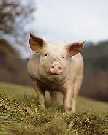
| | |
Coma and apnea in a dog with hydroxyzine toxicosis (case report)
Hydroxyzine is a commonly used antihistamine in canine atopic dermatitis. The most common side affects are mild sedation and gastrointestinal problems. This case report describes a severe, comatous adverse reaction in one dog.
The most common adverse effect of hydroxyzine reported after therapeutic dosing is mild sedation; severe reactions resulting in coma have occasionally been reported in children.
We present a case of large po hydroxyzine exposure causing in coma and apnea in a dog.
Exposure was confirmed with gas chromatography/mass spectrometry analysis of urine. Extensive therapeutic measures to enhance drug elimination and assist ventilation were required for IId.
The positive outcome justifies critical care of similarly exposed animals. Veterinarians should be aware of the potential for coma and apnea secondary to hydroxyzine exposure.
Source: JH Tegzes, SD Smarick, B Puschner (2002): Coma and apnea in a dog with hydroxyzine toxicosis. In: Veterinary and Human Toxicology, 2002, Vol 44, Iss 1, pp 24-26
| | | | |
Comparison of Home Monitoring Methods for Feline Urine pH Measurement
Monitoring of urine pH, often done in the patientÂs home, is essential for proper clinical treatment and management of conditions such as urolithiasis. A Study performed in Gainesville, Florida, tried to find out if home monitoring could lead to reliable results.
The purpose of this study was to assess the agreement in pH readings between a standard laboratory method and methods readily available for home monitoring. The influence of refrigerated storage on urine pH was also examined.
Urine samples were obtained by cystocentesis from 40 clinically healthy cats, and pH was measured within 2 hours of collection. Each sample was evaluated using pH paper, urinalysis reagent strip, 2 brands of portable pH meters (Chek-Mite, Corning, Corning, NY, USA; and Checker 1, Hanna Instruments, Woonsocket, RI, USA), and a standard laboratory benchtop pH meter. Urine samples were refrigerated, and a second pH reading was obtained with the laboratory benchtop meter after 24 hours. The degree of agreement was assessed among the different methods, with the laboratory benchtop pH meter as the reference method.
The closest agreement was obtained with the Chek-Mite portable pH meter and least agreement with the Checker 1 portable pH meter, which had a constant negative bias of 0.31 units due to expiration of the electrode. As expected, pH paper and reagent strips had poor and intermediate agreement, respectively. The reagent strip method had a negative bias of 0.12 units when compared with the benchtop pH meter and wide disagreement at the low pH end. The
reagent strip did not agree strongly with the reference method; only 50% of values were within 0.25 pH units of each other. The difference in pH between 0 hours (6.57 ± 0.54) and 24 hours of refrigeration (6.61 ± 0.53) was not considered clinically significant.
Portable pH meters are excellent for monitoring urine pH at home as long as attention is given to electrode maintenance. Urine can be collected at home and kept refrigerated, and pH may be measured reliably within 24 hours using the reference method or a portable pH meter.
Source: Raskin RE, Murray KA, Levy JK (2002): Comparison of Home Monitoring Methods for Feline Urine pH Measurement. In: Vet Clin Pathol 2002 June;31(2):51-55
| | | | |
Oncura allows American practitioners to run cancer patients online
Oncura is an online cancer management program offered by oncologists to interested general practitioners. For $45 a month plus $150 initial consultation fee the subscribing veterinarian is provided with the diagnosis and therapeutic recommendations and even with the medications required...
Oncura is the brainchild of Dr. Brian Huber, dipl. ABVP, and aids general practitioners in developing, implementing and operating successful oncology services for their patients, virtually eliminating the need to refer to a specialist.
Once cancer is confirmed with a biopsy report, Oncura oncologists consult with veterinarians on the complete health of the pet, type of cancer and available therapies. To simplify the drawing of blood and administration of chemotherapy, veterinarians are taught to surgically implant vascular access ports into patients. Oncura then provides the exact amount of drugs needed per case, prepackaged with protective gear, eliminating waste. Consultants and veterinarians manage cancer cases via e-mail and phone calls.
`We go case-by-case, step-by-step, injection-by-injection with the practicing veterinarian,` Huber says. `The system is extremely detailed and controlled by our consultants. Once practitioners get on board with us, we`re there to help these guys walk through their case. It`s not just e-mail. It`s true case management.`
Oncura actively works an average 35 to 70 cases a month. Clients include Banfield Pet Hospitals and National PetCare Centers as well as private practitioners.
Serving as consultants are Dr. Michael Lucroy, dipl. ACVIM, and Dr. Steven Susanic. Oncura medical directors are Dr. Philip Bergman, dipl. ACVIM, and Dr. Guy Mauldin, dipl. ACVIM.
Oncura doctors take phone calls, answer e-mails and practitioners can even attend training sessions at the Oncura facility in Dallas. `The system`s available to veterinarians anywhere in the country,` Huber says.
Source: Jennifer Fiala (2003): Practitioners run cancer cases with online system. In: DVM Newsmagazine May 1, 2003. www.newsmagazine.com/dvm/
| | | | |
University of Missouri tests glucose monitoring system
Diabetes mellitus is an increasing problem especially in small animals, and still the monitoring at home can be a serious problem. Veterinarians at the University examined the feasibility of using continuous glucose monitoring systems (CGMS) in different species (dogs, cats, and horses) and found it very useful.
The systems have a sensor in a small flexible needle that is inserted under the skin. The sensor is attached, via wires, to a recording device, and continually monitors the level of glucose in normal fluid under the skin, which then reflects the level of glucose in the blood.
The advantages of CGMS, according to university investigators:
ÂThe animal does not have to be repeatedly handled and have multiple blood samples drawn.
ÂThe animal can be at home and will be more likely to eat regular amounts of food and exercise normally.
ÂLevels of glucose can be determined every five minutes over a 24-hour period.
During the study, normal and diabetic dogs and cats showed little discomfort from the sensors or recording devices. Researchers found good correlation between CGMS and actual blood glucose levels, concluding use of CGMS in animals will be useful for glucose monitoring in the future.
Source: University tests glucose monitoring system. In: DVM Newsmagazine November 25, 2003. www.dvmnewsmagazine.com/dvm/
| | | | |
Delayed neurological sequelae after smoke inhalation (case report)
Smoke inhalation and the sequelae to several organ systems are well known to most veterinarians. This recently published case report from the University of Florida describes a dog developing neurological signs four days after a house fire.
A 1-year-old Australian shepherd dog was found unconscious in a house fire. Although recovery after initial therapy was reportedly complete, the dog`s condition acutely worsened 4 days later and progressed to stupor and non-ambulatory tetraparesis with subsequent pneumonia.
After successful therapy, the dog regained full neurologic function after approximately one week.
Thus delayed neurologic sequelae may occur in dogs after smoke inhalation (and presumably carbon monoxide) injury. Neurologic recovery can be complete and sustained, even with severe central nervous system dysfunction.
Source: Mariani, Christopher L. (2003): Full recovery following delayed neurologic signs after smoke inhalation in a dog. In: Journal of Veterinary Emergency and Critical Care 13 (4), 235-239
| | | | |
Amlodipine besylate in bilateral hypertensive retinopathy in a cat (case report)
A 17-year-old, female spayed Domestic Short-haired cat with bilateral hypertensive retinopathy and choroidopathy with bullous retinal detachment was diagnosed at the University of Florida and is described in this case report.
Hypertensive retinopathy and choroidopathy in a cat
The underlying cause of the systemic hypertension could not be determined.
The blood pressure was lowered successfully with the oral application of the L-type calcium channel blocker amlodipine besylate.
The cat subsequently regained vision. The improvement in retinal function was documented using electroretinography.
Source: KomĂĄromy, AndrĂĄs M., Andrew, Stacy E., Denis, Heidi M., Brooks, Dennis E. & Gelatt, Kirk N. (2004): Hypertensive retinopathy and choroidopathy in a cat. In: Veterinary Ophthalmology 7 (1), 3-9.
| | | | |
Semi-quantitative palpation to diagnose feline hyperthyroidism
Hyperthyroidism is the most common endocrinopathy in older cats. Diagnosis is usually confirmed by an increased TT4 level. In this study, the relationship between a semi-quantitative palpation of the thyroidea and TT4 levels is evaluated in more than 150 cats. With very interesting results!
In 155 cats, both with and without clinical signs of hyperthyroidism, total thyroxine (TT4) concentrations were compared to a sensitive, semi-quantitative thyroid palpation technique.
On the basis of TT4 concentrations, 23 of the 155 cats were classified as hyperthyroid. The size of individual thyroid glands was scored between `0` (non-palpable) and a maximum of `6`.
One or more enlarged thyroid glands (score >0) were palpated in 22 of the 23 hyperthyroid cats and in 78 of the 132 euthyroid cats.
However, none of the 132 euthyroid cats had a thyroid lobe score of greater than `3` whereas 18 of the 23 hyperthyroid cats had a thyroid lobe score of `4` or greater, and in two of the five that had scores below `4` there was evidence of intrathoracic functional thyroid tissue on scintigraphy.
Source: G. D. Norsworthy, V. J Adams, M. R. Mcelhaney, J. A. Milios (2002): Relationship between semi-quantitative thyroid palpation and total thyroxine concentration in cats with and without hyperthyroidism. In: Journal of Feline Medicine and Surgery , 4, 3, September 2002 139-143
| | | | |
Invitation to the 22nd ESVP and the 6th ESVCP Meeting
The 22nd Meeting of the European Society of Veterinary Pathology and the 6th Meeting of the European Society of Veterinary Clinical Pathology / European College of Veterinary Clinical Pathology will take place in Olsztyn (Poland)
15-18 September 2004
Dear Colleagues and Friends,
According to the decision of ESVP General Meeting (Amsterdam, 2000), we have a great pleasure and honour to invite you for the 22nd Annual Congress of ESVP, to Olsztyn and to Poland.
We have put together an attractive Congress Programme, with ample time not only for scientific activities, but also for social events.
Our particular aim is to integrate pathomorphologists, morphologists and clinical pathologists and to create developed background for the practitioners.
Our meeting will be held at the University of Warmia and Mazury in Olsztyn, in significant academic and cultural centre of north-eastern Poland.
We are convinced that both, our academic village (counting over 40 000 students, 1 700 scientists, situated near two lakes) and 650 years old Olsztyn (with castle of the XIV century, where Nicolaus Copernicus lived and worked) will appeal to you very much. All the participants will chance to know the beauty of Olsztyn and Poland.
Participation is open to all persons interested in veterinary pathology and related sciences.
University of Warmia and Mazury
Fac. of Vet. Med.
Prof. Jozef Szarek
Ul. Oczapowskiego 13
10-719 Olsztyn
Poland
Phone: +48 89 5233707
Fax: +48 89 5233252
e-mail: esvp@uwm.edu.pl
Further information: www.uwm.edu.pl/esvp
Registration: www.uwm.edu.pl/esvp/register.htm
| | 
| | |
Causes of death in five common dog breeds
In this study, the final necropsy diagnoses of 1206 dogs in the years 1985-1999 were compared. The dogs belonged to the breeds Golden and Labrador Retriever, Boxer, Rottweiler and German Shepherd. One of the results of this interesting evaluation: Golden Retrievers have the same index of suspicion for neoplasia as Boxers, but Boxers die earlier...
A significantly larger proportion of boxers and golden retrievers died of neoplastic disease than the other three breeds.
The ages at death were not significantly different among golden retrievers, German shepherd dogs, and Labrador retrievers.
However, rottweilers and boxers died at a younger age from both neoplastic and nonneoplastic diseases.
Although boxers were already known to be at a higher risk for neoplasia, a similar index of suspicion for neoplasia should now be used for golden retrievers.
Source: Craig LE (2001): Cause of death in dogs according to breed: a necropsy survey of five breeds. In: J Am Anim Hosp Assoc 2001 Sep-Oct;37(5):438-43
| | 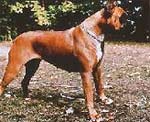
| | |
Spontaneous abortions in female veterinarians
The number of female veterinarians is constantly raising. This very interesting finnish study raises the question if they are a risk group with higher rates of spontaneous abortions and what the reasons for this might be...
The investigation was a retrospective cohort study among all the female members of the Finnish Veterinary Association (N=549). Information on pregnancies was obtained from hospital records from 1973-1990.
The risk of spontaneous abortion among the veterinarians was compared with that of all other Finnish women and other upper-level employees. Odds ratios from logistic regression analyses were used as the estimates of the risk ratios.
The risk of spontaneous abortion was 10.5% for the veterinarians.
In the 1970s, practicing veterinarians had an increased risk of spontaneous abortion as compared with other Finnish women (adjusted odds ratio 1.8, 95% confidence interval 1.0-3.1) or other upper-level employees (adjusted odds ratio 2.0, 95% confidence interval 1.1-3.4).
In the 1980s, the risk fell below that of other Finnish women.
No essential differences were observed in the risk between the veterinarians employed in different occupational categories.
The results suggest that the veterinarians had an increased risk of spontaneous abortion in the 1970s, but not in the 1980s. Factors which might have contributed to this decrease in risk include
decreases in the prevalence and level of exposure to harmful agents, improvements in the occupational hygiene of the work environment, and an increased awareness of reproductive hazards and the use of sick leave during pregnancy.
Source: Lindbohm ML; Taskinen H (2000): Spontaneous abortions among veterinarians. In:
Scan J Work Environ and Health Dec 2000; 26 (6) : 501-506.
| | | | |
Euthanasia of cats in BSE positive farms?
Transmissible spongiform encephalopathies affect a number of mammalian species. The most common spongiform encephalopathies are scrapie in sheep and Bovine Spongiform Encephalopathy (BSE) in cattle. Feline Spongiform Encephalopathy (FSE) is a related disorder in domestic cats. Is there a scientific reason to euthananize the cats on BSE positive farms?
Because of the link between BSE and FSE, cats are put on a par with cattle, in terms of politics and regulations. In the Netherlands, when a case of BSE is found on a farm, not only the ruminants, but also the cats are taken away for post-mortem examination.
So far, the cats examined have always been negative for FSE. There are no scientific reasons for destroying the cats on farms where BSE has been found.
Source: Oomkes C, van Knapen F (2001): Cows, cats, and FSE: death penalty justified? In:
Vet Q 2001 Jan;23(1):51-2
| | | | |
Four methods to determine total protein concentrations in pleural and peritoneal fluid
The determination of the total protein concentration is the first examination of pleural or peritoneal fluid. But which method is the best: the `classical` biuret-method, the Bradford assay, refractometry or even urine test sticks?
23 peritoneal and 12 pleural fluid samples from 35 dogs with various abnormalities were evaluated. Samples were collected into tubes containing EDTA, centrifuged, and stored at -20 C until total protein concentrations were assessed.
Protein concentration in each sample was determined by use of urine test strips, refractometry, and Bradford and biuret techniques.
Accuracy of each method was determined, using dilutions of human control sera.
There was good correlation among results of all quantitative procedures.
Results of the biuret technique were more accurate than results of the Bradford assay.
Refractometry underestimated protein concentration in samples with < 20 g of protein/L.
Results of urine test strips correctly classified effusion samples into 2 groups on the basis of total protein concentrations less than or greater than 20 g/L.
Results of any of these 4 techniques can be used to rapidly and efficiently differentiate peritoneal and pleural fluid from dogs into transudates and exudates on the basis of total protein concentration less than or greater than 20 g/L, respectively.
Source: Braun JP, Guelfi JF, Pages JP (2001): Comparison of four methods for determination of total protein concentrations in pleural and peritoneal fluid from dogs. In: Am J Vet Res 2001 Mar;62(3):294-6
| | | | |
Mandibular Reconstruction of a Partial Hemimandibulectomy in a Dog (Case Report)
This case report describes the successful treatment of severe mandibular malocclusion (after left partial hemimandibulectomy, 7 cm gap) in a 14-month-old golden retriever. This technique might be used also for repair of other large mandibular defects.
After corrective osteotomy of the right horizontal mandibular ramus, normal occlusion was reestablished and temporarily maintained while both mandibles were stabilized by miniplates on the lateral alveolar surface spanning the bilateral mandibular defects (right=1.5 cm, left=7 cm).
A fenestrated, monocortical rib graft was positioned beneath the left gingival surface to protect the synthetic graft, which was secured to the miniplate.
A mandibular reconstruction plate (right) and a locking mandibular reconstruction plate (left) were secured to the ventral borders of the mandibles. Recombinant bone morphogenetic protein-2 delivered in collagen tricalcium phosphate sponges (rhBMP-2 collagen-TCP sponge) was inserted into both mandibular defects.
New bone formation was identified at 3 months and bony remodeling was evident at recheck examinations up to 4 years. Scintigraphy (6 months, 1 year) confirmed graft revascularization and viability. Bone collected (1 year) from the left defect site had robust new bone formation and evidence of continued remodeling. Only minor complications were encountered during the postoperative period and were easily resolved.
Reconstruction of a large mandibular defect was facilitated by use of an osteoinductive factor (rhBMP-2 collagen-TCP sponge) as a graft substitute.
One-step salvage and reconstruction facilitated by use of an osteoinductive factor, as a graft substitute, may be an alternative strategy for repair of large mandibular defects.
Source: Boudrieau, Randy J., Mitchell, Susan L. & Seeherman, Howard (2004): Mandibular Reconstruction of a Partial Hemimandibulectomy in a Dog with Severe Malocclusion. In: Veterinary Surgery 33 (2), 119-130.
| | | | |
Research project for equine hereditary diseases started
Hereditary equine regional dermal asthenia is the focal point of new research at the University of California-Davis (UC-Davis). Dr. Stephen White, a board-certified an worldwide known dermatologist at UC-Davis is the leader of the project.
The research involved collection of information and skin samples from more than 50 horses, which were examined at veterinary schools including UC-Davis and Colorado State University, and by private practitioners.
Phase two of the study will evaluate pedigrees on horses diagnosed with the disease to establish a mode of inheritance. Lastly, scientists plan to develop a test for the trait.
White says researchers hope to find where the animals differ in their DNA from normal horses, to locate any defects.
Source: UC-Davis tackles hereditary disease research. DVM Newsmagazine March 19, 2004. www.dvmnewsmagazine.com/dvm/
| | | | |
European Congress of Veterinary Dentistry 2004
The 13th European Congress of Veterinary Dentistry will be held in Krakow, Poland from the 22nd to the 24th October 2004.
The English language event is organised by the European Veterinary Dental Society in collaboration with the European Veterinary Dental College with the support of the Polish Small Animal Veterinary Association.
The congress will be held at the Manggha Center of Japanese Art & Technology, located in the center of KrakĂłw.
The company Royal Canin sponsors the registration fees of 25 young veterinarians (up to 35 years of age) who wish to attend the congress.
View the Programme
Please send the registration form to:
GRUPA A-05 Sp. z o.o.
`VETERINARY 2004`
PLAC NA GROBLACH 14 / 2
31-101 KRAKĂW
Poland
or by fax: +48 12 429 62 87
Important dates:
Early registration - till 1st September 2004
Late registration - till 10th October 2004
For further information, please visit the website of the EVDS.
| | 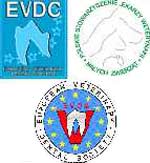
| | |
Plasma thromboxane B2 concentrations during abdominal surgery in horses
Less is known about the changes of blood parameters like thromboxane B2 during an abdominal surgery of several hours in horses. This non-randomized experimental study including six horses compares the effect of anesthesia alone with anesthesia and abdominal surgery on plasma thromboxane B2 concentrations in horses.
Six male mixed-bred horses (5-12 years, 350 ± 18 kg) were included. All horses were anesthetized for 2.5 hours using halothane, and a month later abdominal surgery was performed using the same anesthetic technique with a similar duration.
The schedule of anesthesia included pre-medication with diazepam (0.1 mg kg1 IM), followed by xylazine (2.2 mg kg1 IV), and 10 minutes later anesthesia was induced with ketamine hydrochloride (2.2 mg kg1 IV). After orotracheal intubation, anesthesia was maintained with halothane.
Blood samples for the determination of thromboxane B2 (TXB2) were obtained before, at induction, at 60 minutes after halothane was first inspired, and at recovery from anesthesia as well as at the corresponding stages of the experimental abdominal surgery (before induction, prior to laparotomy, enterectomy, enteroanastomosis, abdominal wall closure).
Results: Baseline value for the anesthesia group was 76 ± 12 pg mL1 and increased (p < 0.001) after 1 hour of anesthesia to 265 ± 40 pg mL1. With surgery, the corresponding value was 285 ± 21 pg mL1 (hour 1, p < 0.001) and 210 ± 28 pg mL1 (hour 2, p < 0.001), respectively. These were not different from anesthesia alone.
The increased concentrations of thromboxane B2 between 1 and 2.5 hours of halothane anesthesia and during the corresponding stages of the surgical intervention suggested that the anesthetic technique caused a significant increase in thromboxane B2 and that surgery did not appear to contribute to this response.
Source: Dinev, Dinko & Andonova, Maria (2004): The effect of general anesthesia and abdominal surgery upon plasma thromboxane B2 concentrations in horses. In: Veterinary Anaesthesia and Analgesia 31 (2), 146-149.
| | | | |
Synergistic effect of chlorhexidine and miconazole on M. canis growth in vitro
The treatment of an Microsporum canis-infection can be very time-consuming and expensive. In this study, the combination of chlorhexidine (known as effective against this organism) and miconazole was used. The interesting result: in vitro a synergistic effect of both substances could be demonstrated.
An agar dilution technique was used to assess the minimum inhibitory concentrations (MIC) of miconazole, chlorhexidine and a 1:1 combination of both agents for 10 isolates of Microsporum canis.
For nine of 10 of the isolates, a combination of miconazole and chlorhexidine was more effective than either agent alone; fractional inhibitory concentration indices indicated a synergistic effect for five isolates and an additive effect for four.
These results illustrate the potent antimycotic effect of miconazole and chlorhexidine against M. canis and are in accordance with previous clinical studies that showed the value of using miconazole and chlorhexidine shampoo in association with oral griseofulvin in the treatment of feline dermatophytosis caused by M. canis.
Source: Perrins, N. & Bond, R. (2003): Synergistic inhibition of the growth in vitro of Microsporum canis by miconazole and chlorhexidine.
In: Veterinary Dermatology 14 (2), 99-102.
| | | | |
European College of Veterinary Pharmacology and Toxicology
Workshop on Pharmacokinetics
September 8th to 11th 2004
in Poland (Wroclaw)
View Program
Program Highlights:
Pharmacokinetic parameters; validation methods; bioavailability; data analysis; drug metabolism; regulatory aspects; population kinetics; residues withdrawal time
Who should attend
Young scientists who expect to become Diplomates of the ECVPT and (according to availability) people having interest for a basic course on pharmacokinetics including practical work on computer
Tuition cost
300 Â (free for students) + housing expenses
Contact for pre-registration
Pierre-Louis Toutain
Ecole Nationale Vétérinaire de Toulouse
23 chemin des Capelles  BP 87614
31076 Toulouse cedex 03 - France.
Tel: +33 (0) 561.19.39.15 Â Fax: +33 (0) 561.19.39.17
Email: pl.toutain@envt.fr or v.defforge@envt.fr
Final registration
30 June 2004
| | 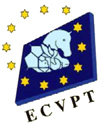
| | |
Histoplasma-induced keratitis in a horse
This case report from Switzerland describes a unilateral keratitis in a horse which turned out to be caused by Histoplasma spp. Very unusual: the horse came from Germany, and Histoplasma spp. are thought to be non endemic in Europe...
A 5-year-old Holsteiner gelding from Germany was presented 2 months after a whitish discoloration of the left cornea was observed.
Cytologic examination revealed intra- and extracellular globular structures, up to 4 ”m in size, consisting of a central spherical deeply basophilic body surrounded by an unstained halo.
The structures were morphologically consistent with Histoplasma spp. Infection with Histoplasma organisms is not endemic in Europe.
Topical use of fluconazole was successful in eliminating Histoplasma organisms within 10 days of initiation of treatment.
Source: Richter, Marianne, Hauser, Beat, Kaps, Simone & Spiess, Bernhard M. (2003): Keratitis due to Histoplasma spp. in a horse. In: Veterinary Ophthalmology 6 (2), 99-103.
| | | | |
Congress Highlights in
Pre-Congress Info
| | 
| | |
Essential fatty acids in canine atopic dermatitis
The steroid sparing effect of essential fatty acids is well known in the treatment of canine atopic dermatitis. Many studies were published, with sometimes controverse results due to poor study design. This perfectly designed multicentric, randomized, placebo-controlled, double blind study from Scandinavia shows: essential fatty acids do have a steroid saving effect which is seen after a lag time.
A randomized, double blind, placebo-controlled multicentre clinical trial of 12 weeks` duration was undertaken in 60 dogs with atopic dermatitis to evaluate the steroid sparing effect of essential fatty acid supplementation.
The dogs were randomly assigned to receive either a combination of borage seed oil and fish oil or a placebo, in addition to prednisolone tablets. All dogs received a standardized basal diet.
Owners of the dogs recorded pruritus daily using a 10 cm visual analog scale and the dosage of prednisolone was established based on the pruritus score, according to written instructions.
The dosage of prednisolone and the use of any concurrent treatment (shampoo and/or ear-cleanser) were recorded by the owner on a daily basis.
The investigators graded the skin lesions at days 0, 42 and 84. The use of prednisolone during the test period was lower in the active group, but the difference was not statistically significant (P = 0.32).
The test period was sequentially divided into 43-84, 50-84, 57-84, 64-84, 71-84 and 78-84 days. On day 64, the difference between the active group and the placebo group reached statistical significance (P = 0.04) with an increasing difference towards the end of the study.
A statistically significant reduction in the pruritus scores and the total clinical scores from day 0 to day 84 was apparent in both groups (P < 0.0001).
At the end of the study, both the pruritus score and the total clinical score were lower in the active group.
Our findings indicate a steroid sparing effect of essential fatty acid supplementation in canine atopic dermatitis and, furthermore, that there is a time lag before the effect is attained.
Source: SĂVIK, BENTE K., BERGVALL, KERSTIN, HOLM, BIRGIT R., SAIJONMAA-KOULUMIES, LEENA E., HEDHAMMAR, Ă
KE, LARSEN, STIG & KRISTENSEN, FLEMMING (2004): A randomized, controlled study to evaluate the steroid sparing effect of essential fatty acid supplementation in the treatment of canine atopic dermatitis. In: Veterinary Dermatology 15 (3), 137-145
| | | | |
Are dogs susceptible for equine influenza virus?
Influenza virus is thought to be species specific and being unable to cross species barriers. Now for the first time, University of Florida (UF) veterinary researchers believe they have documented cases of equine influenza virus jumping the species barrier into dogs. It might even be responsible for the death of eight greyhounds!
The virus is the likely cause of a respiratory disease outbreak that killed eight racing Greyhounds from kennels in Jacksonville. Although the outbreak has been isolated and quashed, any time a virus jumps species it is considered an important epidemiological event, the university reports.
Although researchers stress the findings involve only these particular Jacksonville dogs, they will investigate possible connections to similar disease outbreaks that have affected racing dogs in Florida and elsewhere in recent years.
Cynda Crawford, DVM, Ph.D., a UF veterinary immunologist, explains, `I want to stress that our team`s findings are preliminary and confined to the dogs affected by an outbreak at one Florida track, an outbreak that occurred three months ago and was contained through a voluntary statewide quarantine, which is no longer in effect.`
UF`s research team also worked with Cornell University`s College of Veterinary Medicine in Ithaca, N.Y., and the Centers for Disease Control and Prevention (CDC). Ed Dubovi, director of virology section at Cornell`s Animal Health Diagnostic Lab isolated the virus. CDC was brought in to assess the public health threat and monitor the outbreak.
`The virus found in the canine samples is probably representative of the strain that is circulating now in horses in Florida and elsewhere in the United States,` says Ruben Donis, Ph.D. with CDC.
On the basis of genetic sequencing, Donis and colleagues at the Influenza Branch conclude the virus found in canine samples resembled a strain of equine influenza virus that appeared in horses in Wisconsin last year.
The researchers also found that the dogs developed antibodies specific for the influenza virus.
`This implies that the virus replicated enough within the dogs for their immune system to recognize it and form antibodies,` Crawford says.
Believed to be a first: Equine influenza virus outbreak struck a Jacksonville, Fla., Greyhound track. The University of Florida spearheaded the investigation working with Cornell University and the Centers for Disease Control and Prevention.
Equine influenza is a disease of horses and is present in North America, Europe and parts of Asia. Horses typically develop a fever and a dry, hacking cough. In the early stages of the disease, horses are reluctant to eat or drink for several days, but usually recover in two to three weeks.
Crawford adds that she is unsure how the Jacksonville Greyhounds could have been exposed to equine influenza virus, and that is one of many questions they intend to pursue through further epidemiological studies.
When Crawford learned about the January outbreak, she visited the Jacksonville track to find 24 dogs affected with symptoms including cough, fever and other more serious symptoms.
Out of the total, eight dogs died and 16 recovered.
Crawford reports she collected blood and nasal fluid samples from 35 dogs, and five of the dogs that died underwent postmortem examinations.
The team also alerted dog owners not to experiment with prevention products approved for other species because of the potential for adverse reactions, including death.
Details of the story provided by Sarah Carey, University of Florida.
Source: Sarah Carey (2004): Equine Influenza Virus. In: DVM Newsmagazine June 1, 2004. www.dvmnewsmagazine.com/dvm/
| | | | |
New parasite guidelines released by CAPC
The U.S. Companion Animal Parasite Council (CAPC) released new internal/external parasite guidelines to improve prevention, treatment and monitoring of parasitic diseases. CAPC is a multi-disciplinary council, consisting of experts in parasitology, internal medicine, public health, veterinary law, private practice and association leadership.
According to Dr. Gary Holfinger, who unveiled the guidelines at the recently concluded North American Veterinary Conference, says: `The truth is that most parasite-related illness is preventable in our pets. Yet, parasites cause disease-and even death-in thousands of cats and dogs each year, while putting their human caretakers at risk.
He adds: `Veterinarians today have an arsenal of safe, effective and affordable products to prevent the most common parasites of companion animals. However, failure to prescribe and administer these products properly reduces their effectiveness.`
The council has four major objectives:
1. Adoption of practice and procedures to protect pets from parasitic infections.
2. Adoption of practices and procedures to reduce the risk of transmission of zoonotic parasites.
3. Collaboration among pet owners, veterinarians and physicians to control parasitic infections,
4. Collaboration with other groups who share the common interests of parasite control and animal and human health.
CAPC says that the foundation for the new guidelines is year-round administration of broad-spectrum parasiticides that protect against heartworm and intestinal nematodes along with lifelong protection against external parasites.
Compliance matters
Compliance for parasite preventives is low, CAPC says. In fact, the 2003 American Animal Hospital Association (AAHA) compliance survey says more than 48 percent of dog owners were found to be either not giving their dogs heartworm preventives or not giving them as recommended by their veterinarian.
Meanwhile, another recent survey revealed that while an estimated 77 percent of veterinarians currently recommend year-round administration of heartworm preventives, only half of owners report they follow this recommendation.
At the same time, dogs and cats continue to be infected with intestinal parasites at a comparatively high rate, increasing the opportunity for transmission to people, CAPC reports.
Nationwide, 34 percent of dogs are infected with gastrointestinal parasites, with up to 54 percent infected in southeastern states. The Centers for Disease Control and Prevention (CDC) estimate that between 1 million to 3 million people are zoonotically infected with toxocara migrans each year.
The guidelines
CAPC`s guidelines are separated into categories like consideration of pet health and lifestyle factors; lifelong prevention of common internal and external parasites; environmental control of parasite transmission; staff pet owner and community education; owner considerations in preventing zoonotic disease.
The guidelines also outline proper diagnostic techniques for veterinary professionals with an emphasis on properly conducted fecal examinations.
Blagburn explains, `The accuracy of fecal examinations is greatly influenced by sample size and quality as well as examination technique and timing.` The guidelines recommend annual fecal examinations in adult pets using centrifugal flotation technique, and encourage multiple examinations for younger animals.
Blagburn says regular fecal examinations greatly increase the ability of veterinary professionals to provide information-based recommendations, adding that the risks posed by inadequate testing and techniques are too great to ignore.
Source: CAPC releases new parasite guidelines. In: DVM Newsmagazine March 1, 2004. www.dvmnewsmagazine.com/dvm/
| | | | |
Symmetrical proliferative keratitis in one cat (case report)
Keratitis in the cat is seen frequently. But this cat showed a bilateral progressive keratitis which was probably due to feline herpesvirus-1. Maybe this reason is more common than we know...
A 9-year-old, female spayed, Domestic Long-haired cat was presented with bilateral, progressive, pinkwhite corneal opacities. The referring veterinarian had diagnosed feline herpesvirus-1 (FHV-1) keratitis though diagnostics for FHV-1 had not been performed and treatment with antibiotics and antivirals did not improve the condition.
Histopathology showed neutrophils, plasma cells and lymphocytes, but no eosinophils or mast cells.
Routine diagnostics did not find an underlying cause, but Southern blot analysis for FHV-1 was positive. The cat responded to topical corticosteroids and cyclosporine when used consistently.
Source: Colitz, Carmen M. H., Davidson, Michael G. & Gilger, Brian C. (2002): Bilateral proliferative keratitis in a Domestic Long-haired cat. In: Veterinary Ophthalmology 5 (2), 137-140.
| | | | |
Excellence in Veterinary Practice
Learn about the best ways how to identify and manage problems according to the needs of daily veterinary practice. Be the first to register for the new ESAVS species oriented training programme.
Excellence in Veterinary Practice:
A 4 year training programme consisting of 8 residential courses of 5 days and a distance learning part (courses can be attended independently)
The first course: Small Animal Practice I will take place in Palma de Mallorca: 27 Â 31 October 2004
Course topics of Small Animal Practice I: Abnormal gait, seizures, loss of equilibrium, Atopecia, pruritus, Âpustules, scales and crustsÂ
Are you interested? ESAVS
| | 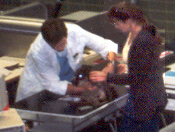
| | |
Why do so many dogs suffer from fear problems?
Are we socialising our puppies in the right way?
By: Jolanda Pluijmakers DIP CACB and David Appleby MSc
The good old 1960Âs
Probably the most famous research on which the majority of our knowledge of the behavioural development of puppies so far is based was carried out in the 1960s by some researchers called Freedman, King and Elliot. They kept the puppies they were studying in isolation from people and environmental experiences until 16 weeks except for one week during which they received daily sessions of socialisation with humans and testing. The different groups of puppies received their socialisation sessions at different ages. They started to get results with puppies that were exposed to a passive person in a test area from the age of 3 weeks on. These puppies immediately confidently approached the researcher with a `Hi, I`m a puppy` attitude. Those introduced at five weeks were initially hesitant but within ten minutes became as confident as the puppies introduced at three weeks. Puppies introduced to the test area for the first time at 7 weeks took an average of 20 minutes to approach the person. Those introduced to it at 9 weeks took an average of 30 minutes and those that had no experience of people until 14 weeks were said to be and to have remained as wild as wild animals.
As a result of this and other experiments it was concluded that between 3 to 12 - 14 weeks of age puppies go through a stage of development that has greater effect upon their capacity to cope with new experiences than at any other time in their lives. This, of course, has important implications for the way we bring up puppies in the real world, which is more complex and challenging than the laboratory conditions described above.
So far so good? Or not?
So far so good but what if the interpretation of those early experiments was wrong? What if the increasing tendency to avoid new things after 5 weeks, such as the person in the test area, was the after effect of insufficient experience in an earlier period of development? This is the conclusion of some recent reviews of this and other research, which put a new perspective on how we should bring up puppies. The research was started with the aim to develop a method to decrease the development of inappropriate avoidance behaviour, fear and fear aggression in dogs. For everyone who is involved in dogs it is noticeable that many dogs in our modern society, show an inability to cope when faced with challenging and even apparently benign situations in their environment which might be due to inadequate socialisation. The welfare of these dogs is at risk. They appear to be unable to relax and enjoy life, they feel threatened by Ânormal events and are more susceptible to stress and diseases. They are less likely to make rewarding pets and are at a higher risk of being abandoned, re-homed or euthanised than those that experience adequate socialisation during early development.
Shocking figures!
Looking at the annual reviews of cases of The Association of Pet Behaviour Counsellors in the UK illustrates further that the situation is worrying. Their figures show that fear is the basis of many behaviour problems. For example, fear aggression towards people and dogs were the most commonly referred behaviour problems of 2000. Twenty five per cent of the referred dogs exhibited fear aggression towards people. Between 1996 and 1999 this percentage varied between 20 to 28%. Fifteen percent of the referred dogs in 2000 exhibited fear aggression towards other dogs, which was between 7 and 14% between 1996 and 1999. In addition fears and phobias were observed in another 8% of the cases referred (including sound and visual fears and phobias). However, these figures are probably just the tip of the iceberg as not all dog owners seek help from a behaviour counsellor.
How to move on?
There are some key points that can`t be ignored; firstly the fact that in the latest research it is suggested that the socialisation period is much shorter than previously assumed and may end at 7-8 weeks with the most important period being the 3 to 5 week. The second point is that new insights in brain development have important implications for for example, the moment and manner in which we expose dogs to stimuli and the moment we choose to home them. However, it seems like this new knowledge is still overshadowed by the old work and is insufficiently integrated in the daily practice for the puppies to profit from it.
It has to be concluded that, everyone who is concerned about the welfare of dogs and wants to give them the best opportunity to develop into a happy dog, the time is ready for reflection and reconsideration of the daily practice. Plus, seeing the large amount of fear problems displayed by dogs, we will have to broaden our horizon. Knowing how to prevent the development of fear problems alone is not enough any more. As we are one of the first, if not the first persons a dog owner will ask advise from when confronted with a problem, to give an advise that works, a we will need a lot of knowledge about the treatment
Animal Behaviour Clinic Study Days
Animal Behaviour Clinic
Herendaal 21
6228 GV Maastricht
Niederlande
Telefon +31 43 3560623
Telefax +31 43 3560624
www.abclinic.biz
| | | | |
20th Annual Congress of the ESVD-ECVD
8th - 10th September 2005
Chalkidiki, Greece
Dear Fellow Dermatologists and Friends,
The Congress Organizers and the Clinic of Companion Animal Medicine, School of Veterinary Medicine, Aristotle University of Thessaloniki, are very proud and honored to invite you to attend and enjoy the 20th Annual Congress of the ESVD-ECVD, which will take place in Chalkidiki, Greece, from September 8th to September 10th, 2005.
Following the ESVD-ECVD tradition the Scientific Committee has prepared a program, which includes Scientific and Continuing Education sections as well as Free Communications and Posters. We have tried to enrich the Continuing Education program a little bit, not only because the majority of the Congress delegates are usually general practitioners, but also because in the preceding 5th World Congress of Veterinary Dermatology (Vienna, 2004) there will be to much derm science to enjoy! However, the Scientific Program has been scheduled to satisfy even the most demanding veterinary dermatologist. It is our deep intention to have the general practitioner updated in the ever expanding and fascinating field of Veterinary Dermatology the way he or she will really enjoy, and also to provide an opportunity to the delegates, coming from different countries, to meet, discuss and exchange their research and clinical experiences.
The Scientific Program, containing interesting subjects such as Staphylococcus intermedius and canine allergies, aeroallergens, feline autoimmune alopecias, follicular diseases, keratinization disorders, leishmaniosis, cutaneous inflammation and canine atopy and feline eosinophilic dermatoses, will be covered by speakers of international reputation and ambitious young colleagues. To fulfill the purpose of the Continuing Education program well-known lecturers will bring us up to date on exotic animal dermatology, diagnostic dilemmas in canine hypothyroidism, elimination diets, otitis externa and many other clinically-oriented topics.
It is more then sure that you will learn more about dermatology in a friendly and relaxing atmosphere, enjoying swimming, sunbathing, the BBQ-folklore night and most of all the Greek hospitality, that will remain unforgettable. This is why we have chosen the greatest beach of Cassandra and Athos Palace-Pallini Beach hotel complex as the venue of the much promising 20th Annual Congress of the ESVD-ECVD. Before and after the event donÂt miss the opportunity to visit some famous ancient Macedonial sites located not far from the city of Thessaloniki or to enjoy a boat trip around the Holy Mountain peninsula. For all these reasons donÂt forget to mark September 8th to 10th 2005 on your diary.
We are looking forward to seeing you in Chalkidiki and to welcoming you to the Athos Palace-Pallini Beach.
On behalf of the Organizing Committee
Alex Koutinas
Organizing Committee
Chairman: A. F. Koutinas (Greece)
M. Saridomichelakis (Greece)
E. Papadogiannakis (Greece)
A. Danourdis (Greece)
R. Farmaki (Greece)
The Organizing Committee may be contacted
By surface mail: Dr A. Koutinas, PO Box 16039, GR-544 01, Thessaloniki, Greece
By e-mail: Dr M. Saridomichelakis msarido@vet.auth.gr
By fax: +30 231 0 994516
Scientific Committee
Chairman: D. Lloyd (UK)
H. Koch (Germany)
C. Noli (Italy)
M. Vroom (The Netherlands)
T. Willemse (The Netherlands)
Topics of the Congress
Infectious skin diseases
Allergies
Autoimmune skin diseases
Cutaneous endocrinology
Exotic species dermatology
Cytology/histopathology
Follicular diseases
Keratinization disorders
Alopecia
Clinicopathological interactions
Otitis
Cutaneous inflammation
Continuing Education and Scientific Program
Registration and Reservation
Please return your registration form to
CONGRESS SECRETARIAT of the 20th Annual Congress of the ESVD - ECVD
EPSILON CONGRESS ORGANIZERS,
I. Papapanayotou - V. Vourazeris OE
4 Papadiamantopoulou Str, GR-115 28,
Athens, Greece
For further information please visit the congress website: www.esvd2005.gr
| | 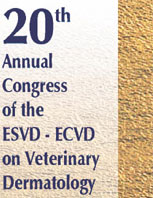
| | |
Bone marrow hypoplasia after fenbendazole administration in a dobermann
Dobermanns are known to be at risk to show adverse effects to certain drugs e.g. trimethoprime sulfonamides. In this case, a dog with fenbendazole-associated reversible bone marrow hypoplasia is described.
The 1,5 year-old Doberman Pinscher showed a sudden onset of fever and malaise twelve days after a therapy with fenbendazole because of a suspected lungworm infection had been initiated.
CBC of the patient revealed a pancytopenia and bone marrow biopsy showed bone marrow hypoplasia of undetermined origin.
After discontinuation of the fenbendazole, bactericidal antibiotics and fluid therapy a complete resolution of clinical and hematological abnormalities was seen within 15 days.
After exclusion of infectious, neoplastic, autoimmune and toxic etiologies and resolution of the signs after discontinuation of the fenbendazole the authors believe that an idiosyncratic reaction to fenbendazole caused the bone marrow hypoplasia.
Source: Gary AT et al (2004): Bone marrow hypoplasia associated with fenbendazole administration in a dog. In: JAAHA 40:3, pp 224-229
| | | | |
Are Malassezia yeasts the reason for feather picking?
Feather picking in birds is a frustrating and common phenomenon. Since Malassezia yeasts can cause moderate to severe pruritus in several mammals, the question was raised if pruritus due to these yeasts might be the reason for feather picking in psittacines.
No studies have been established the cutaneous normal microflora in birds. So in this study, 103 psittacines (50 normal and 53 pickers) were included.
Acetate tape samples were taken from 6 sites (head, neck, proventer, propatagium, inguinal and preen gland area) in each bird, stained with modified WrightÂŽs stain and then malassezia were counted. Additionally, a Sabouraud culture was started and PCR using primers specific for Malassezia, Candida and Saprophytes were used in macroscopic diagnosed `yeasts`.
The number of yeasts was not statistically significant between normal and picking psittacines - yeasts were found infrequently in both groups.
Source: Preziosi DE, Morris DO, johnston M, Rosenthal Kl, Rankin SC (2004): Quantitiy ands distribution of Malassezia organisms on the skin of normal and feather-picking psittacines. In: Veterinary Dermatology 15, p 204
| | | | |
New Jersey Veterinary Foundation (NJVF) supports needy pet owners
Not all animal owners are able to afford the costs of veterinarians or laboratory costs if their animal becomes sick. Especially older people are affected. A program of the NJVF called Healing Hands for Needy Paws is started in cooperation with veterinary practices and veterinary labors. It will provide medical care to pets whose owners salaries permit them to receive government assistance.
Participating practices can receive up to $1,000 per year for the program. Payments under the fund will be granted on a cost only basis, without compensation for veterinary labor or profit.
To qualify for the program the animal must be domestic, owned, sick, injured or in need of emergency care. The owner will pay a one time fee of $30 to the organization.
Source: NJVF program targets needy pet owners. DVM Newsmagazine Jul 21, 2004; www.dvmnewsmagazine.com/dvm/
| | | | |
First and second prize for German researchers
Professor Steffen Hoy from GieĂen has been awarded a prize by a private pharmaceutical company for the best paper at the 18th world congress of pig veterinarians in Hamburg. He demonstrated that certain diseases in sows have much wider effects than previously thought.
Also the second prize was awarded to a German: Jan-Bernd Lammers has developed a new method of examining pig bile.
If a sowÂs udder or uterus becomes infected or cannot provide enough milk, these diseases would also occur during subsequent production cycles, said Hoy during the award ceremony. This conclusion is new, he continued, and is particularly significant because these diseases are infectious and should be prevented in the interests of both the pigs and the pig breeders and farmers.
Source: www.ipvs.de
| | | | |
Fatal fat embolism during hip surgery (case report)
Pulmonary embolism is known to be a common complication of orthopedic surgery in men but seems to be rare in dogs. In this case report, the sudden death of a 3-year-old German Shepherd during hip surgery due to fat embolism is described - reminding all of us that fatal complications can also occur in routine surgery on `non-risk` patients.
Gross necropsy findings included severe pulmonary edema and congestion and congestion of liver and kidneys. The microscopic examination of HE- and oil red O-stained tissue sections revelaed large numbers of fat globules in blood vessels in the lungs, liver and kidneys.
Source: Terrell SP, Sundeep Chandra AM, et al (2004): Fatal Intraoperative Pulmonary Fat Embolism During Cemented Total Hip Arthroplasty in a Dog. In: JAAHA 40:4, pp 345-348
| | | | |
Repeated administration of propofol in dogs and cats
Propofol has become a very popular drug in small animal medicine and is considered to be a safe and well-tolerated option. But what happens if the drug is administered on consecutive days - is there an accumulation and thus a higher risk? This study on 10 dogs and 10 cats showed no apparent cumulative side effects.
The animals received a bolus of propofol i.v. at the dose of 6 mg/kg (dogs) and 10 mg/kg (cats) for three consecutive days.
The occurence of apnea, heart and respiratory rates, blood pressure, time to movement and biochemical profiles were recorded.
3 cats showed apnea, 6 cats showed a non-significant increase in the number of Heinz bodies.
Based on these results, the authors see no apparent cumulative adverse effects from a bolus of bisulfite-containing propofol, administered on three consecutive days.
Source: Matthews NS et al. (2004): Repetitive Propofol Administration in Dogs and Cats. In: JAAHA 40:4 pp 255-260
| | | | |
Chinese pigs clear from bird flu
Controversial statements came from China the last weeks: As the Chinese government says tests have found that its pigs are clear of a highly virulent strain of bird flu - several days after a Chinese scientist said cases of the H5N1 strain of the virus had been discovered in pigs in 2003 and 2004. Now the WHO said it was seeking clarification on the issue...
If the spread of bird flu to pigs is confirmed, there is a fear that the virus could mutate into a strain more easily transferable to humans.
Almost 200 million birds were culled during a flu epidemic in Asia earlier this year, and more than 20 people died in some of the relatively rare cases when the virus spread from the birds to humans.
But WHO experts warn that, if there are pigs harbouring both bird and human flu viruses, the two strains could interact to create a more deadly strain.
An official at the China National Avian Flu Reference Laboratory said in a conference on Friday that the H5N1 virus strain had been found in pigs at several farms in the country.
Chen Hualan later told journalists that the virus had been discovered in pigs in south-east China`s Fujian province in 2003, and in `another place` in 2004.
But in an internet statement on Monday, the Chinese Ministry of Agriculture said it had tested 1.1 million poultry and pork samples for H5N1 earlier this year, and found nothing in pigs.
It did not, however, directly refute Ms Chen`s comments about the case last year.
It also did not make clear whether the tests were carried out on laboratory animals or on farms.
Just as the Chinese Agriculture Ministry was releasing its statement, a senior WHO official told a news conference in Malaysia that finding H5N1 in pigs would increase the chances of a flu pandemic.
The WHO said it was seeking clarification of the situation, and urged the Chinese Agriculture Ministry to discuss the matter in an open manner.
Source: http://news.bbc.co.uk/go/pr/fr/-/2/hi/asia-pacific/3591200.stm
| | | | |
Selamectin against Pneumonyssoides caninum mites
Pneumonyssoides caninum is a nasal mite which is occuring especially in Scandinavia. Ivermectin was found to be highly effective against those but is not licensed for dogs. Would the licensed avermectin selamectin be an effective alternative?
In a laboratory study to evaluate the efficacy of selamectin for treatment of canine nasal mite infection, 12 purpose-bred beagles were experimentally infected with Pneumonyssoides caninum (P. caninum).
Six of the dogs were treated with selamectin applied to the skin of the back at dosages of 6 to 24 mg/kg for three times at 2-week intervals. The remaining six dogs were an untreated control group.
At necropsy 39 to 46 days after inoculation, no P. caninum mites were found in any of the treated dogs. In contrast, nasal mites were found in five of the untreated dogs. This difference was statistically significant at P=0.015.
Source: Lotta Gunnarsson, Göran Zakrisson, Dan Christensson, Arvid Uggla (2004): Efficacy of Selamectin in the Treatment of Nasal Mite (Pneumonyssoides caninum) Infection in Dogs. In:
Journal of the American Animal Hospital Association 40:400-404 (2004)
| | | | |
Use of Keyes skin punch for intestinal biopsies
Can a punch designed for skin biopsies really be an alternative for intestinal biopsies? An interesting question! And an interesting answer: This study recommends the punch as an alternative to other open intestinal biopsy methods!
A prospective, clinical trial was conducted using 12 dogs that were presented for intestinal biopsy.
Comparisons were made between paired jejunal biopsies collected using a Keyes biopsy punch and a standard scissor excisional technique.
There were no differences in speed of collection, diagnostic value of specimens, complication rates, or sample quality.
In this study, the Keyes skin punch was found to be safe, rapid, and diagnostic in all animals. Based on results of this study, the use of a Keyes punch instrument can be recommended as an alternative to other open intestinal biopsy methods.
Source: Matthew M. Keats, Robert Weeren, Paul Greenlee, Krista L. Evans, Anne C. Minihan (2004): Investigation of Keyes Skin Biopsy Instrument for Intestinal Biopsy Versus a Standard Biopsy Technique. In: Journal of the American Animal Hospital Association 40:405-410 (2004)
| | | | |
Establishing the body fat in dogs
Currently, it is very popular to determine not only the body weight but also the body fat index in people. So it is not surprising that people look for an accurate method not only to weight their dogs but also to determine how much fat they have: Obesity is considered one of the most common forms of malnutrition occurring in dogs.
In this study, laboratory methods of evaluation of body composition in live dogs have included dual-energy X-ray absorptiometry (DEXA) and deuterium oxide (D2O) dilution.
Clinical methods of evaluation include assigning a body condition score (BCS) based on visual observation, palpation, and morphometric measurements.
This study used these four methods to evaluate 23 healthy, adult, client-owned dogs.
Good correlation (coefficient of determination [r2]=0.78) was found between measurements of percent body fat (%BF) determined by the D2O dilution method and the DEXA scan. Percent body fat can also be estimated using BCS (r2=0.92 comparison with DEXA) or by using morphometric measurements with simple calculations (r2=0.92 comparison with DEXA).
Source: Dianne I. Mawby, Joseph W. Bartges, Andre dÂAvignon, Dorothy P. Laflamme, Tamberlyn D. Moyers, Tamorah Cottrell (2004): Comparison of Various Methods for Estimating Body Fat in Dogs. In: Journal of the American Animal Hospital Association 40:109-114 (2004)
| | | | |
WCVD5
New presentations online with clinical images from the world dermatology congress available on VetContact web site.
WCVD5 Presentations View also the
WCVD5 Picture Gallery and WCVD5 Poster
5th World Congress on Veterinary Dermatology in Vienna
Over 1.200 veterinarians and technicians from 55 countries met in August 2004 at the 5th World Congress on Veterinary Dermatology in Vienna.
This yearÂs event took place on the beautiful premises of the ÂHofburg Conference CentreÂ.
A total of 45 companies from around the world presented their products and services in the dermatology field. Top specialists from different countries were invited to give lectures at the event.
Numerous workshops and wet labs enabled the participants to learn and train on new techniques and methods or to refresh their knowledge. Additionally, a day was set aside to provide veterinary assistants with specialized training. Again, for the second time, a special program translated in Japanese was offered to the numerous participants coming from the Far East.
A copy of the WCVD5 proceedings can be requested for 20 Â (Austria), 25 Â (European countries) or 35 $ (other countries) from the event organizer. Please send your order to
Fehringer
Kellergasse 52
A - 7100 Neusiedl/See
Austria
with the subject: WCVD5 CE Proceedings.
Please submit the payment confirmation.
Some of the presentations with clinical pictures are also made available online at the VetContact website in the section `Presentations online`.
Highly interesting lectures and symposia were rounded off by numerous social events enabling the participants to spend unforgettable evenings with people who share the same interests. Here the participants engulfed themselves in discussions, secured residency positions and swapped experiences, framed by dancing couples performing the traditional Viennese Waltz to the music of Austrian composer Johann Strauss (Welcome Reception at the town hall).
During the Austrian Evening, one could enjoy various Viennese specialties, authentic food and Austrian wines. Many socio-cultural traditions could be experienced and learned, for example the ÂSchnaltzer (cracking - a pre-Christian custom in which this specific noise is made to announce the perishing of winter), ÂWettnageln (a game consisting of driving nails into a log) or ÂWettsĂ€gen (sawing competition).
One of the greatest highlights was visiting the Spanish Riding School of Vienna, where classic dressage is still practiced in its purest form. The special gala performance on Friday evening offered an unforgettable experience for the participants of the World Congress.
An extensive picture gallery available at VetContact (Picture Galleries) shows vibrant impressions of this World Congress on Veterinary Dermatology.
| | 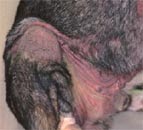
| | |
`New` giant ape species discovered
Scientists found this group of giant apes in the north of the Democratic Republic of Congo. The animals share characteristics of both gorillas and chimpanzees. According to local villagers, the apes are ferocious, and even capable of killing lions.
The UK magazine New Scientist is to publish its report about the mysterious creatures next week.
If they are a new species of primate, it could be one of the most important wildlife discoveries in decades.
The discovery of these apes `reveals just how much we still have to learn about our closest living relatives,` New Scientist says.
The characteristics of the `new` apes are:
Large, black faces (like gorillas)
Up to two metres tall (6.5ft)
Weigh 85kg-102kg (187lb-224lb)
Males make nests on the ground (like gorillas)
Diet rich in fruit (like chimps)
They stand up to two metres tall, the size of gorillas, and like gorillas, they nest on the ground, not in trees. But they live hundreds of kilometres away from any other known gorilla populations, and their diet is closer to that of chimpanzees.
Primatologist Shelly Williams is thought to be the only scientist to have seen the apes.
There are three controversial possibilities to explain the origin of the mystery apes:
1. They are a new species of ape
2. They are giant chimpanzees, much larger than any so far recorded, but behave like gorillas
3. They could be hybrids, the product of gorillas mating with chimpanzees.
So far, researchers have little to go on, but they now plan to return to northern DR Congo to study the apes further.
Source: http://news.bbc.co.uk/go/pr/fr/-/2/hi/science/nature/3730574.stm
| | | | |
Cephalexin intermittent therapy in dogs with Âidiopathic recurrent pyoderma
Pyoderma is a very common disease in dogs and is secondary to a variety of diseases (allergies, endocrinopathies, ectoparasites etc.) in the majority of cases. But what if no primary disease can be identified? Antibacterial interval therapies are recommended for these Âidiopathic pyoderma patients. This study shows the results of one of the most popular therapeutic protocols, the Âweekend therapyÂ.
The purpose of this study was to evaluate the efficacy of cephalexin intermittent therapy 2 days a week (weekend therapy) in the prevention of relapses of recurrent idiopathic superficial or deep pyoderma in dogs.
Twenty-eight dogs were entered into the study. A diagnosis of chronic idiopathic pyoderma was made based on: (1) history, including at least two previous relapses cured in the 12 months before inclusion; (2) clinical signs of pyoderma without underlying skin disease based on clinical presentation; and (3) appropriate diagnostic tests (compatible cytological examination and bacterial culture).
In phase 1 of the study, dogs were treated with cephalexin (15 mg/kg twice daily) if sensitivity testing was compatible until 2 weeks after cure, for a minimum of 4 weeks and a maximum of 2 and 4 months for superficial and deep pyoderma, respectively.
In phase 2, the cured dogs were then randomly and blindly allocated into two groups: Group 1 received cephalexin (15 mg/kg twice daily) on Saturdays and Sundays for 1 year, and Group 2 received a placebo in the same way. Dogs were examined every 3-4 weeks during phase 1 and every 2 months during phase 2, except in case of relapse justifying an earlier examination.
Clinical signs of pyoderma were scored at each examination (11 parameters scored 0-3). No other systemic antibacterial or anti-inflammatory treatments nor topical antibacterial or anti-inflammatory treatments were permitted during both phases.
The two groups were compared using Fischer`s exact test for sex and clinical signs, and the Wilcoxon Rank-Sum test for age, weight, number of relapses before inclusion, and duration of treatment in phase 1. The number of dogs remaining free of relapse, i.e. free of any pyoderma lesion, was compared between the two groups using a survival analysis with the Log-Rank Test.
The average time before relapse was compared between the two groups using the Wilcoxon Rank-Sum test. In phase 1, one case was lost to follow-up; two cases were excluded due to treatment failure and an additional two cases because of resistance in vitro to cephalexin. Various species of staphylococci sensitive to cephalexin were isolated in the 23 remaining dogs. In phase 2, 13 dogs received placebo and 10 received cephalexin.
The two groups were not statistically different according to clinical signs (six cases of folliculitis in each group, three and five cases of furunculosis, one and two cases of cellulitis in Groups 1 and 2, respectively), sex, age, weight, number of previous relapses, and duration of treatment in phase 1.
There was a significant difference between the two groups in the number of dogs that did not relapse. Two dogs in Group 1 did not relapse. Further, the rate of relapse over time was more rapid in the dogs receiving placebo. The average time until relapse in Groups 1 (6.6 months) compared to Group 2 (2.5 months) was significantly different. Resistance to cephalexin did not increase during the study.
We conclude that cephalexin weekend therapy can be beneficial in dogs with idiopathic recurrent pyoderma.
Source: D. N. Carlotti, P. Jasmin, L. Gardey and A. Sanquer (2004): Evaluation of cephalexin intermittent therapy (weekend therapy) in the control of recurrent idiopathic pyoderma in dogs: a randomized, double-blinded, placebo-controlled study. In: Veterinary Dermatology 15 ( s1) Page 7-8 Funding: Virbac SA.
| | | | |
Diagnosis of hyperkalemia by electrographic changes
Hyperkalemia is believed to cause characteristic changes in the ECG. But is it possible to diagnose hyperkalemia by ECG changes? The ECGs of 40 dogs and cats with a manifest hyperkalemia were evaluated and showed surprising results...
Eighteen dogs and 22 cats with serum potassium levels >5.5 mEq/L as the result of various disease processes were included in this prospective study.
Once hyperkalemia was documented, the following data were collected:
ECG (n=40), total magnesium (mg/dl) (n=18), total calcium (mg/dl) (n=31), and venous blood gas (n=20).
Animals were divided into 5 groups based on expected ECG`s changes associated with hyperkalemia (mEq/L): Group 1- 5.5-6.5; Group 2- 6.6-7.0; Group 3- 7.1-8.5; Group 4- 8.6-10.0; Group 5- >10.0.
ECG`s were interpreted to determine if the rate, rhythm and changes in the P-QRS-T complex were similar to those previously reported.
Results: Twelve ECGs demonstrated changes previously described, while 28 did not: Group 1 (n=7)- 1/7; Group 2 (n=2)- 0/2; Group 3 (n=14)- 4/14; Group 4 (n=6)- 3/6; Group 5 (n=11)- 4/11.
Many ECG abnormalities not previously described were also identified such as atrioventricular dissociation and ventricular tachyarrhythmias. Blood gas analysis revealed acidemia (19/20) with severe acidemia (pH<7.2) in the majority (16/19).
Hypocalcemia was documented (5/13) and most of these patents (4/5) were in Group 5.
Hypermagnesemia was documented in the majority of patients (10/18), though not in one particular group.
It is difficult to establish typical ECG changes in patients with hyperkalemia, which represents a departure from the historical description.
Hypocalcemia may be involved with ECG changes and arrhythmias in Group 5.
Hypermagnesemia causes electrocardiographic abnormalities similar to those described with hyperkalemia and therefore does not explain the results of this study.
There likely are complex interactions with electrolytes and acid base abnormalities that affect ECG formation.
Source: Tag, TL & Day, TK (2004)
ELECTROCARDIOGRAPHIC ASSESSMENT OF HYPERKALEMIA IN DOGS AND CATS. In: Journal of Veterinary Emergency and Critical Care 14 (S1), S1-S17.
| | | | |
Is radiotherapy in cutaneous grade II mast cell tumors mandatory?
A very important question, because cutaneous mast cell tumors are very common and radiotherapy is not always and everywhere available. The answer: If these tumors are completely excised, adjuvant radiotherapy might not be necessary in the majority of dogs, as this study shows.
A retrospective study was performed on 31 dogs with completely excised, grade II, cutaneous mast cell tumors in order to determine recurrence rates and sites.
Distant tumor recurrence developed in 22% of dogs, and local tumor recurrence developed in 11% of dogs; however, the vast majority of these animals were incompletely staged initially.
Complete surgical excision of grade II mast cell tumors was associated with effective local control in 89% of these dogs.
Therefore, adjuvant radiation therapy might not be indicated in the majority of dogs with complete surgical excision.
Source: Chick Weisse, Frances S. Shofer, Karin Sorenmo (2002): Recurrence Rates and Sites for Grade II Canine Cutaneous Mast Cell Tumors Following Complete Surgical Excision. In: Journal of the American Animal Hospital Association 38:71-73 (2002)
| | | | |
New Presentations - Neurology
Two new presentations in the field of neurology from Prof. Dr. Marc Vandevelde (awarded at the 29th WSAVA Congress in Greece with the `International Award for Scientific Achievements`) are now available at VetContact:
`Pathogenesis of Nervous Canine Distemper`
`Mad Cows and Mad Cats, Where Do We Stand?`
| | 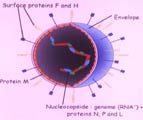
| | |
Telomerase-targeted therapies in canine cancer cell lines
Cancer is still one of the most frustrating diseases in both men and animals. Novel therapies become more and more specific, for example by evaluating tumour-specific treatment strategies like telomerase-targeted therapies. How effective is this therapy in vitro?
Despite advances in conventional therapeutics, cancer remains an invariably fatal disease, the major challenge being to develop tumour-specific cancer treatment strategies. Current treatments such as chemotherapy and radiotherapy rely on a crude distinction between cancer cells and normal cells.
However, with an increased understanding of the molecular events in the development of cancer, it is possible that far more innovative and targeted approaches can be developed. From studies on humans and dogs, the enzyme telomerase has emerged as a central unifying mechanism underlying the immortal phenotype of cancer and has thus become a candidate for differentiating between normal and cancer cells.
The level and frequency of telomerase activity and component gene expression in cancers reinforces this as a potential target for cancer therapies.
This article describes two approaches to target cancer by capitalizing on the expression of this enzyme.
In the first approach, we target the enzyme itself, the goal being to cause cancer cell death.
In the second approach, we utilize the respective gene promoters for telomerase component enzymes to drive expression of a reporter gene in cancer cell lines.
The results demonstrated that targeted gene expression using promoter elements can be achieved specifically in telomerase-positive cell lines.
However, targeting the enzyme itself proved less successful and warrants investigations into alternative approaches.
Source: Argyle, D. J., McKevitt, T., Gault, E. & Nasir, L. (2004): Evaluation of telomerase-targeted therapies in canine cancer cell lines. In: Veterinary and Comparative Oncology 2 (4), 214-221.
| | | | |
Surgery on a dog with FallotÂŽs tetralogy
The four defects that are found in TOF are pulmonic stenosis, ventricular septal defect, overriding aorta and right ventricular hypertrophy secondary to the pulmonic stenosis. These defects occur in dogs as well as in men, but normally the dogs are not treated but die at a young age or are euthanized. This report describes a unique cooperation between veterinary and human medicine which led to the surgery on September...
Veterinarians at Texas A&M College of Veterinary Medicine teamed up with a pediatric cardiothoracic surgeon in what is believed to be the first collaboration of its kind to repair a heart defect in Liz, a 10-month-old Labrador.
The procedure to correct the dog`s defect, called Tetralogy of Fallot (TOF), took place Sept. 1 at the university and was conducted by Dr. Theresa Fossum, DVM, PhD, professor at Texas A&M, and Dr. Kenneth A. Fox, a pediatric cardiothoracic surgeon with Cardiothoracic and Vascular Association of Austin.
`We felt very good with the repair,` Fossum says. `The heart looked beautiful after the repairs.`
The team approached the surgery using a new technique and went to greater lengths to protect the heart while it was stopped.
`Dogs` hearts are more sensitive than humans`, so we used a cardio polygenic solution to protect it for the 50 minutes it took to make the repairs,` Fossum explains.
Evidence suggests that these defects are the result of varying degrees of abnormality in a single developmental processÂthe growth and fusion of the conotruncal septum. It is possible that pulmonic stenosis or a ventricular septal defect, both of which occur independently, might be less severe manifestations of the same genetic defect.
Liz stayed on a ventilator for about 24 hours after the surgery but was eating independently the following day.
Dogs suffering from TOF will have a bluish color depending on the severity of their defect, Fossum says. Liz didn`t have the bluish color, but she was less active than a dog her age is expected to be.
A severe murmur was discovered when Liz`s owner took her to get routine vaccinations in August, and the veterinarian recommended further tests.
Despite the intensive care given to Liz, she died Sept. 21.
`She had an infection in her lungs and was being monitored by Dr. David Nelson at the university and his wife, Kate Nelson, a clinical perfusionist and professor,` Fossum says. `By the time they reached the hospital, she had arrested,` she adds. `The specific cause of death was a blood clot that entered her pulmonary artery.`
Liz was the second dog to undergo TOF surgery for her own benefit.
Much was learned from Liz`s procedure, Fossum says.
`Just like anything else, the more surgeries we do, the more we`ll discover and understand about repairing the defect,` she adds.
Source: Jessica Tremayne (2004): Veterinarian, pediatrician team up to correct TOF in a canine. In: DVM Newsmagazine Nov 1, 2004
| | | | |
10 cm cockroach in jungles of Borneo discovered
Besides this `monster` cockroach other new insects in the jungles of Borneo have been discovered, scientists say. An expedition of caves and cliffs, led by the Nature Conservancy, also said it saw previously unknown fish and plants.
The newly-discovered cockroach is believed to be the largest in the world.
As well as the `monster` cockroach, the scientists reported a new `micro-crab`, a pure-white 6.5cm-long millipede, two new species of begonia, two new species of snail and several new types of fish, the conservancy said.
`In just five weeks, the expedition team discovered numerous new species previously unknown to science,` the conservancy`s Scott Stanley said.
`Who knows what else is out there?` he added, calling for the area surveyed in East Kalimantan to be preserved.
`If something is not done soon to protect these areas, dozens of species could disappear before anyone knew they ever existed.`
Borneo is one of the world`s richest regions, in terms of biodiversity, but the area had no special status that might have protected it against illegal mining or logging.
The team of scientists explored four `karst` systems of limestone caves, cliffs and sinkholes in the Sangkulirang Peninsula, about 1,200km (750 miles) north-west of Indonesia`s capital, Jakarta.
Source: http://www.bbc.news.co.uk
| | | | |
Bilateral stifle joint OCD in a cat
Osteochondrosis dissecans (OCD) is a common problem in young dogs especially in those of large or giant breeds. Cats are not predisposed to develop this problem, but it is worth to be considered at least as a differential diagnosis in lameness of growing cats, as this very informative care report demonstrates.
A 9-month-old, castrated male, domestic shorthaired cat was presented for progressive right hind-limb lameness.
A diagnosis of osteochondritis dissecans of the lateral femoral condyle was made based on radiographs and physical examination, and was confirmed by right lateral stifle arthrotomy.
The cartilage flap was removed, and the underlying bone was curetted.
Seven months later, the cat was sound on the right leg but developed a left hind-limb lameness.
A similar lesion was found in the left leg and was treated identically.
Fourteen months after presentation, the cat was sound on both hind limbs.
Source: S. Christopher Ralphs (2005): Bilateral Stifle Osteochondritis Dissecans in a Cat. In: Journal of the American Animal Hospital Association 41:78-80 (2005)
| | | | |
Cornell University installs first permanent open-magnet MRI for animals
MRI is a standard diagnostic procedure in men. If an MRI is indicated, most dogs and cats have to be referred to a diagnostic centre, often run by colleagues from human medicine. Now a new magnetic resonance imaging (MRI) system, the first permanent open-magnet MRI in North America specifically designed for companion animals, is installed at the Cornell Hospital for Animals and will get a better view of abnormalities in soft tissue.
`This machine is her 24/7 just for the animals,` says Dr. Peter Scrivani, a board-certified radiologist at the hospital. `This is an open MRI, not a closed tunnel that the patient disappears into. The open MRI seems to make the pet owners more comfortable.`
Animals are anaesthetized so they stay motionless during the about 30 to 45-minute series of scans. Tubes for air and anesthetic gas run through one wall of the enclosure, and an anesthesiologist monitors the flow of gases in and out of the animal`s lungs.
A grant from the Maurice and Corinne Greenberg Foundation funded the acquisition. The Italian company Esaote SpA built the Vet-MR system.
Source: www.dvmnewsmagazine.com/dvm/
| | | | |
Cox-2-expression in canine keratinocytes
Cyclooxigenase 2 (Cox-2) has been demonstrated to be overexpressed in various neoplasias in both animals and men, also in the canine squamous cell carcinoma, one of the most common skin tumours in dogs. This excellent article, a Swiss-Canadian cooperation, gives very interesting insights in the COX-2 expression of both normal and abnormal keratinocytes which may lead to improved therapeutic techniques in the following years.
Original Article
Expression and regulation of cyclooxygenase-2 in normal and neoplastic canine keratinocytes
N. Pronovost1, M. M. Suter2, E. Mueller2, J. Sirois3 and M. Doré1*
Squamous cell carcinoma (SCC) is one of the most common cancers in dogs, yet relatively little is known about the molecular events involved in its development.
Increasing evidence implicates cyclooxygenase-2 (COX-2) in the pathogenesis of various cancers in humans and animals. COX-2 overexpression has recently been demonstrated in canine SCCs.
The objective of our study was to characterize the expression and regulation of COX-2 in normal and neoplastic canine keratinocytes (CKs) to provide an in vitro system to investigate the implication of COX-2 in SCC oncogenesis in dogs.
Cell lines derived from normal CKs and neoplastic CKs (SCCs) were cultured in the absence or presence of agonists, and immunoblots, immunocytochemistry, radioimmunoassays and a cell proliferation assay were used to characterize COX-2 expression and action.
Results showed that neoplastic keratinocytes had a higher basal COX-2 expression than normal keratinocytes.
In both cell lines, stimulation with the tumour promoter phorbol 12-myristate 13-acetate induced a time-dependent increase in COX-2 protein, with COX-2 induction being stronger in cancerous SCC than in normal CK cells.
Moreover, SCC cells produced significantly more PGE2 than CK cells, under both baseline and stimulated conditions (P < 0.05). NS-398, a selective COX-2 inhibitor, inhibited prostaglandin (PG)E2 synthesis and decreased proliferation of CK and SCC cells (P < 0.05).
Collectively, our results indicate that the canine neoplastic keratinocyte SCC cell line expresses more COX-2 and produces more PGE2 than the normal keratinocyte CK cell line, thus providing an in vitro system to study the molecular basis of elevated COX-2 expression in SCCs in dogs.
Source: Pronovost, N., Suter, M. M., Mueller, E., Sirois, J. & Doré, M. (2004): Expression and regulation of cyclooxygenase-2 in normal and neoplastic canine keratinocytes. In: Veterinary and Comparative Oncology 2 (4), 222-233.
| | | | |
First accurate description of the rabbitÂŽs lumbosacral spine cord
Every small animal practitioner knows that rabbits tend to develop problems with the spinal cord sometimes even resulting in vertebral fractures. Before this study, the exact anatomy of this important part of the rabbitÂŽs spine was not completely cleared. 64 rabbits helped to get these new insights.
This study provides an accurate, anatomical description of the rabbit`s lumbosacral spinal cord.
Following humane euthanasia, 64 rabbits were radiographed and dissected. The number of thoracic (T) and lumbar (L) vertebrae was 12T/7L in 43.8%, 13T/6L in 32.8%, and 13T/7L in 23.4% in the 64 rabbits studied.
The 13th ribs were rudimentary, asymmetric, or both in 15 animals.
The spinal cord terminated within the second sacral vertebra (S2) in 79.3%, within the first sacral vertebra (S1) in 19.0%, and within the third sacral vertebra (S3) in 1.7% of the sample.
Spinal nerve contributions to the femoral, obturator, sciatic, and pudendal nerves were determined.
Formulas to predict the termination of the cord relative to the vertebral column were established.
Age, weight, sex, and method of preparation did not show a significant correlation with the length of the spinal cord.
Source: JB Greenaway, GD Partlow, NL Gonsholt, and KR Fisher (2001): Anatomy of the lumbosacral spinal cord in rabbits. In: Journal of the American Animal Hospital Association, Vol 37, Issue 1, 27-34
| | 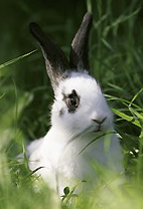
| | |
Potomac horse fever more dangerous than West Nile Virus?
Potomac horse fever (PHF) is an often fatal disease of horses, caused by different strains of Rickettsia. Unfortunately, the signs are pleomorph and differ also between vaccinated and non-vaccinated animals. Early and aggressive therapy is mandatory, and this excellent summary gives important informations for every horse practitioner.
Currently, six strains of PHF have been recognized, and all strains cause similar disease.
Affected horses typically show initial signs of depression and a transient high fever. These early signs contribute to the difficulty in diagnosing this disease because depression and variable high fever can be seen with any number of bacterial and/or viral diseases.
Typical management of such cases might be supportive care with pain relief and a fever-reducing agent, such as flunixin.
A complete blood count done initially might show a mild leucopenia or a normal hemogram.
In 7 to 10 days from the initial signs, effected horses progress to show loss of appetite, colic, loose manure to profuse watery diarrhea, edema of the head, legs and abdomen and potentially life-threatening laminitis. Pregnant mares effected with PHF might experience late-term abortions.
Treatment is most effective when initiated early in the course of disease. Practitioners that suspect a case of PHF should begin aggressive fluid therapy to counteract the dehydration that is seen with this disease and to correct the electrolyte imbalance created by the diarrhea.
Anti-rickettsial therapy with oxytetracycline also is crucial, and current recommendations are to treat with a 6.6 mg/kg IV daily for up to five days. Response to treatment is often quick and marked. Doxycycline also has been used recently by many clinicians, too.
Diagnosis of PHF still remains problematic. Testing can be done by IFA, Elisa and, more recently, by a PCR test. There still remains no correlation between titer and the likelihood of disease, and many of the testing methods cannot differentiate between a vaccine titer and actual clinical disease.
Paired titer samples can be helpful, but they take too much time, and isolation of the causative agent, which is definitive, also will be too slow for proper and timely treatment decisions.
Veterinarians are left with the reality that if they suspect PHF, then treatment must begin immediately because toxemia, laminitis and death can occur rapidly.
The need for rapid treatment is one of the factors that seems to be contributing to the recent re-emergence of PHF. The trend toward fewer vaccinated horses also appears to be contributing to the disease`s rapid rise. Because this disease has been relatively quiet during the last few years, many owners and veterinarians have not been as diligent in their management practices or as aggressive with treatment in cases that present with PHF-like signs.
There are many areas of the country that have not had a case of PHF in a long time. Owners in these locations are not as concerned with this disease as they had once been. Veterinarians do not think of PHF perhaps as often as they should when presented with a depressed horse with a high fever. The recent increase in PHF cases points out the need for more vaccination and for heightened awareness on the parts of both owners and veterinarians.
There are a number of vaccines available for PHF. Initially a vaccine was available that protected against only one PHF strain. Newer vaccinesÂone released and approved as recently as this summerÂoffer wider protection and better efficacy. There have been reported cases of horses contracting PHF however, despite the use of routine and repeated vaccinations. It should be noted that the vast majority of horses that are vaccinated and still contract PHF actually develop a much milder form of the disease and usually are spared the more-serious consequences of the condition.
The fact that the disease presents in a slightly different way in vaccinated horses makes clinical diagnosis even harder for veterinarians. Vaccinated horses can show mild depression, a less-severe temperature elevation and slightly soft manure for a few days and never develop any other signs. Practitioners attending such a horse might be unaware that what they are seeing is an active PHF case, and therefore, they might not be alerted to the potential for other more severe cases in their area among unvaccinated
Source: Kenneth L. Marcella (2005): Conditions collide to propel PHF/Potomac horse fever must be treated rapidly to dodge fatalities. In: DVM Newsmagazine Jan 15, 2005. www.dvmnewsmagazine.com/dvm/
| | | | |
Essential Facts of Physiotherapy in Dogs and Cats
with educational video on DVD
ISBN 3-938274-09-3
 59,95
The rehabilitation/physical therapy modalities available today supply fast and effective treatment strategies for postoperative care and pain management. In the present book, renowned European and American veterinary scientists have compiled their long years of experience in the application of these techniques in veterinary practice. It currently is the only book on the market specifically geared towards the practical implementation of these potent treatment methods in veterinary medicine. Each treatment modality is clearly and concisely described using extensive tables and illustrations.
To ensure simple and selective implementation of the treatments, we have included:- Teatment protocols in `Indications`, the chapter in which all orthopedic and neurological indications for physical therapy are discussed.
- Training videos to all treatment modalities on the DVD, including all important details and numerous tips to ensure easy mastery of the techniques in individual home study.
Physical therapy encompasses an endless variety of treatment possibilities. The treatment modalities included in this book were selected with the following goals/criteria in mind:- Significant reduction of rehabilitation time after surgery
- Fast and effective pain management for patients with acute and chronic pain
Optimal postoperative care of orthopedic and neurological patients, or as an alternative to surgery in cases where surgery is not feasible for various reasons:
Easy mastery and application
Frequent use
Rapid onset of effect
Improve client-animal bonding by enlisting the animal owner in treatment
Cost-effectiveness
Authors: Barbara Bockstahler, David Levine, Darryl Millis
Buy this book
Further information www.be-vetverlag.com
| | 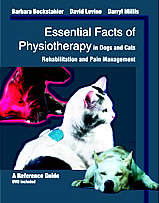
| | |
No blood groups in ferrets?
Dogs, cats, birds, and ferrets are popular companion animals, often family members. So they are provided with high-quality veterinary medical care, including blood transfusions. But how many blood groups do these species have? Ferrets seem to have only one...
This article reviews the current status of blood groups in dogs, cats, birds, and ferrets and discusses the impact of blood groups on veterinary transfusion medicine.
One blood group with 3 types has been described in the cat, whereas multiple blood groups have been described in the dog.
Only rudimentary knowledge exists regarding pet bird blood groups, and, to date, the ferret appears to be unique because no blood groups have been described.
Antibodies against blood group antigens also play a role in animal blood transfusions. Cats have naturally occurring alloantibodies; however, dogs do not appear to have clinically significant naturally occurring alloantibodies.
Understanding the issues related to blood groups and blood group antibodies in companion animals will also benefit those using these species as research models for human diseases.
Source: Hohenhaus AE. (2004): Importance of blood groups and blood group antibodies in companion animals. In: Transfus Med Rev. 2004 Apr;18(2):117-26.
| | | | |
Essential Facts of Blood Pressure in Dogs and Cats
This is the first and only book to focus specifically on the different aspects of blood pressure in veterinary medicine. It is ment to be a practical guide and provide all the information needed to help integrate an understanding of blood pressure into every day clinical practice.
216 pages, with 17 min. educational video on CD-ROM
Hypertension is commonly found as a symptom of many major diseases and the possibility of monitoring blood pressure can often be of paramount importance for the successful treatment of these diseases.
Hypertension is also a dangerous disease itself, because it not only leads to progression of the underlying cause (such as with renal disease), but it can also cause damage to other organs, like the eye, the heart, the kidney and the brain. Especially the eyes and the heart are frequently affected, thus a thorough examination of these organ systems is indicated in any patient, being diagnosed with hypertension.
The book covers all topics relevant to blood pressure including physiology, hypotension, hypertension, therapy of blood pressure abnormalities, economics of blood pressure measurement and, most importantly, how to get a reliable and repeatable blood pressure reading.
In order to offer the best support, this book also includes a very valuable 17 min. CD-Rom showing videos on how to reliable measure blood pressure in dogs and cats. The CD also demonstrates how to evaluate the eye and heart for endorgan damage.
`This pioneering text will stand as a gateway to bring blood pressure (...) to position of importance and pertinence in contemporary veterinary practice.`
Larry Cowgill/ Davis, President Elect of the Veterinary Blood Pressure Society (VBPS)
ISBN 3-00-011096-8
USD 59.90; Â 59.90
Buy this book
Further information www.be-vetverlag.com
| | 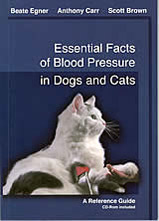
| | |
West Nile Virus vaccination recommendations released by AAEP
The West Nile Virus is a raising problem not only in the United States. Vaccination is possible, but there are many controversies regarding the vaccination. Now the AAEP (American Association of Equine Practitioners) gave an official statement and recommendations regarding the administration of the vaccine.
The horse`s age, level of activity and breed are taken into consideration when deciding what is appropriate, association authorities say.
The new guideline is a supplement to the association`s existing position that was released in 2001. To view recommendations, visit www.aaep.org/pdfs/AAEP_WNV_Guidelines_2005.pdf.
The task force is co-chaired by Robert Holland, DVM and Gordon Brumbaugh, DVM, researchers, vaccine manufacturers and private practitioners.
The task force stresses all vaccines should be evaluated based on the risk for disease, potential for adverse reactions to a vaccine, anticipated efficacy of the product and cost.
Source: www.dvmnewsmagazine.com/dvm/
| | | | |
Breed predisposition for spontaneous cataracts
Spontaneous cataracts are commonly seen in older dogs, and every practitioner knows that there are certain breeds which seem to be overrepresented. But is this really true? One of the interesting and as well surprising results of this study: Fox Terriers have a higher prevalence of this disease than Miniature or Toy Poodles - at least in the United States!
The objective of the study was to determine the prevalence of cataracts in dogs presented to veterinary medical teaching hospitals in North America between 1964 and 2003.
A retrospective study of all dogs presented with cataracts to veterinary medical teaching hospitals in North America between 1964 and 2003 was conducted to determine cataract prevalence.
The different decades, breeds, gender, and age at time of presentation with cataract were compared.
The prevalence of dogs presented with cataract varied by decade and ranged from 0.95% (196473), 1.88% (197483), 2.42% (19942003), to 3.5% (198493).
The total number of dogs presented with cataracts over the 40-year period was 39 229. From 1964 to 2003 the prevalence of cataract formation in this patient population increased by about 255%.
Fifty-nine breeds of dogs were affected with cataracts above the baseline prevalence of 1.61% seen in mixed-breed/hybrid dogs.
The breeds with the highest cataract prevalence included: Smooth Fox Terrier (11.70%), Havanese (11.57%), Bichon Frise (11.45%), Boston Terrier (11.11%), Miniature Poodle (10.79%), Silky Terrier (10.29%) and Toy Poodle (10.21%).
The breeds with the largest number of cataractous dogs during the entire four decades were the Boston Terrier (11.11%), Miniature Poodle (10.79%), American Cocker Spaniel (8.77%), Standard Poodle (7.00%), and Miniature Schnauzer (4.98%).
Gender ratios of cataractous dogs seemed to affect limited breeds.
Age of presentation with cataract diagnosis varied among several breeds.
In the mixed-breed/hybrid baseline population, cataract formation appeared to be age related with a higher frequency of cataract formation in dogs after 47 years.
Cataract formation is one of the most prevalent eye diseases in the dog population, and in about 60 breeds of dogs the prevalence of cataract exceeds that of the baseline mixed-breed/hybrid group.
The prevalence of cataract is also influenced by age in most purebred dogs and affects 16.80% of the 715+-year-old mixed-breed/hybrid dog population. Total and age-related cataract prevalence in dogs seems very similar to that in man.
Source: Gelatt, Kirk N. & MacKay, Edward O. (2005): Prevalence of primary breed-related cataracts in the dog in North America. In: Veterinary Ophthalmology 8 (2), 101-111
| | | | |
Circular external fixator to lengthen a dogÂŽs leg
This uncommon surgery was performed as a cooperation of veterinary and human researchers at the University of Florida, Gainesville: They united to develop components for applying the human technology of circular external fixators to animals.
The University of Florida`s (UF) College of Veterinary Medicine, Texas Scottish Rites Hospital for Children and IMEX Veterinary Inc. swapped notes in effort to perfect the use of the technology for animals.
Veterinary surgeons have applied their knowledge to help approximately 10 canines a month, with the first animal benefiting from the device in 1996, says Dr. Dan Lewis, professor of small animal surgery.
`Veterinarians are always referring clients to see us with their pets` fractures and limb abnormalities because our surgeons have worked with this technology and accomplished a lot,` says Sarah Carey, UF public relations.
The Ilizarov fixator, a type of circular external fixator, was used to repair an Akita`s leg that had been deformed when the animal was attacked by another dog. One of the Akita`s front legs had already been amputated and the other limb was not growing properly. The procedure altered the animal`s gate and reduced stress on it`s back and legs.
`The limb UF surgeons repaired had not grown to the length of the rear legs, and when the dog walked it was much lower in the front,` Carey adds.
The dog`s leg was lengthened 30 percent officials say, simultaneously derotating and straightening it.
The technology is being used at the University to correct fractured limbs, joint fusions and correct limb deformities in companion animals.
The university`s surgeons have used the device many times and have become the authority on the procedure, according to Carey. The university works closely with IMEX Veterinary Inc and the research unit at Texas Scottish Rites Hospital for Children to develop components for applying the human technology to animals.
Source: Circular external fixator lengthens Akita`s leg. In: DVM Newsmagazine Apr 14, 2005; www.dvmnewsmagazine.com/dvm/
| | | | |
2nd Virbac European Symposium - ESVD 2005
Glycotechnologies in veterinary dermatology: a new era!
7th September 2005
Chalkidiki - Greece
18H30 - 21H00
Athos Palace Hotel Auditorium Inscription
View the programme
For further information, please contact:
Cecile CormorĂšche
Virbac Animal Health
13 rue LID
BP 27
06511 Carros Cedex
France
Tel 00 33 (0)4 92 08 71 11
Fax 00 33 (0)4 92 08 79 90
ccormore@virbac.fr
| | | | |
Rapidly growing Mycobacteria in dogs and cats
Mycobacteria are sometimes isolated in samples from dogs and cats, often taken from chronic nonhealing skin lesions. Which species are affecting dogs and cats most commonly and how are they treated best?
Rapidly growing members of the genus Mycobacterium were most often associated with chronic (2 to 72 months), nonhealing skin lesions of dogs and cats.
Mycobacterium fortuitum (M. fortuitum) was the most commonly isolated mycobacterium obtained from these lesions, although M. chelonae-abscessus and M. flavescens were occasionally encountered.
Isolates were tested in vitro to various antimicrobial agents and found to be susceptible to amikacin (100% of the isolates), cefoxitin (93.8%), ciprofloxacin (75%), clarithromycin (71.4%), doxycycline (28.6%), erythromycin (6.2%), gentamicin (68.8%), kanamycin (75%), minocycline (81.3%), streptomycin (14.3%), tobramycin (43.8%), trimethoprim/sulfonamides (57.1%), and vancomycin (15.4%).
Source: Spencer S. Jang, Dwight C. Hirsh (2002): Rapidly Growing Members of the Genus Mycobacterium Affecting Dogs and Cats. In: Journal of the American Animal Hospital Association 38:217-220 (2002)
| | | | |
Streptococcus agalactiae vaccination in fish
Streptococcus agalactiae is a well-known bacterium in mammals. But it is also a major pathogen in a diversity of fish species, leading to serious economic losses in many species of freshwater, marine and estuarine fish worldwide. Is the new vaccine the right choice?
A highly efficacious S. agalactiae vaccine was developed using extracellular products (ECP) and formalin-killed whole cells of S. agalactiae. The vaccine efficacy following storage of S. agalactiae ECP and formalin-killed S. agalactiae cells at 4 °C for 1 year was determined.
The stored ECP containing S. agalactiae formalin-killed cells failed to prevent morbidity and mortality among the vaccinated fish, and the relative percentage survival was 29.
Serum antibody responses of the stored ECP and freshly prepared ECP against soluble whole cell extract of S. agalactiae indicated that significantly less antibody was produced in fish immunized with stored ECP and S. agalactiae cells than in those fish immunized with freshly prepared ECP and S. agalactiae cells at day 31 post-vaccination.
Silver staining of sodium dodecyl sulphate-polyacrylamide gels and immunostaining of Western blots with tilapia antiserum to S. agalactiae revealed that predominant 54 and 55 kDa bands were present in the freshly prepared ECP fraction.
The 55 kDa band was absent from the stored ECP and new bands below 54 kDa appeared on the Western blot.
The results of this study on S. agalactiae ECP provide evidence for a correlation between protection and antibody production to ECP and for the importance of the 55 kDa ECP antigen for vaccine efficacy.
Source: Pasnik, D J, Evans, J J, Panangala, V S, Klesius, P H, Shelby, R A & Shoemaker, C A (2005):
Antigenicity of Streptococcus agalactiae extracellular products and vaccine efficacy. In:
Journal of Fish Diseases 28 (4), 205-212.
| | | | |
WSAVA 2005 - Mexico
Congress News
1st Issue
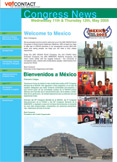
Congress News
2nd Issue
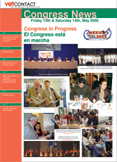
| | | | |
Slaughter of animals without prior stunning
FVE is of the opinion that the practice of slaughtering animals without prior stunning is unacceptable under any circumstances.
| | 
| | |
Prof. Carl Osborne received received the Distinguished Teacher Award
Prof. Osborne ist well known all over the world: He is a professor in the veterinary clinical sciences department at the University of Minnesota. Among his professional accomplishments, Osborne`s breakthroughs in the causes and treatment of urinary tract diseases changed the practice of companion animal care worldwide.
He has presented more than 585 continuing education presentations and is one of the world`s most sought after educators.
Now he was honored in a ceremony for distinguished professors: He received the Distinguished Teacher Award, as one of the 14 professors to receive the award at the University of Minnesota.
He was not the only professor who received this honor: Eight professors received the university`s Graduate-Professional Teaching Award for outstanding contributions to post-baccalaureate, graduate and professional education; six professors received the Morse-Alumni Award for outstanding contributions to undergraduate education and all 14 faculty members were inducted into the university`s Academy of Distinguished Teachers.
Osborne will receive a continuous salary augmentation of $3,000 as long as he is a member of the faculty and a five-year award of $1,500 for his department to use in professional development activities.
Source: www.dvmnewsmagazine.com/dvm/
| | | | |
Ureteral obstruction due to mast cell tumor
The first description of a mast cell tumor in this location! And although the neoplasia was poorly differentiated it showed no evidence of recurrence or dissemination of the tumor after surgical resection.
A 6-year-old, castrated male, mixed-breed dog was diagnosed with partial unilateral ureteral obstruction secondary to a ureteral mass.
The ureteral mass was surgically resected, and an ureteroneocystostomy was performed.
Histopathology of the ureteral mass was consistent with a poorly differentiated mast cell tumor (MCT).
The patient recovered well but was euthanized 5 months postoperatively for central nervous system signs.
A choroid plexus tumor was diagnosed during necropsy examination.
There was no evidence of recurrence or dissemination of the ureteral MCT. Extracutaneous MCTs are rare in dogs, and primary MCT associated with the urinary tract has not previously been reported in the veterinary literature.
Source: Michele Steffey, Kenneth M. Rassnick, Brian Porter, Bradley L. Njaa (2004): Ureteral Mast Cell Tumor in a Dog. In: Journal of the American Animal Hospital Association 40:82-85 (2004)
| | | | |
First upgrading of the Cornell disease detection facility
For the first time since the construction in the 1950s the Pathology Teaching and Diagnostic Complex at the Cornell University College of Veterinary Medicine has been upgraded. 1 Million Dollars will be spent.
The program promises a both attractive and effective `new` complex:
The upgrade includes renovations to the Kenneth I. Gumaer Necropsy Laboratory and construction of 3,900 square feet of new space for laboratories, including a diagnostic immunohistology laboratory and a transmissible spongiform encephalopathy (TSE) diagnosis laboratory. The new design features controlled access to the facility.
`The infectious proteins, known as prions, that cause TSE are extremely resistant, so the work must be done in special areas so these agents don`t contaminate other laboratories,` says Sean McDonough, associate professor in Cornell`s Department of Biomedical Sciences.
Other upgrades include: an anatomic pathology teaching theater with 60-student capacity and digital projectors that provide high-resolution images and Internet accessibility; an avian, exotics and special procedures room, complete with hooded biosafety cabinet and down-draft table for examining infectious diseases; new small-animal morgues and tissue storage make the facility more usable and able to handle infectious-disease patients.
Source: www.dvmnewsmagazine.com/dvm/
| | | | |
Veterinary oxygen masks can safe lives
Not only in the intensive care units oxygen masks are saving lives daily. Now they are used very successful in a new way: they have been embraced by firefighters to prevent pets from smoke inhalation.
And the reasons are very clear: These masks offer a better seal around the animal`s snout increasing the chance of survival, firefighters say. They are hooked to a tank that provides oxygen while firefighters lead the animal to safety.
Smiths Medical Veterinary Division, the manufacturer of the masks, has sold more masks in the past year than in the last 15 years due to the increased interest, according to The Kansas City Star.
Funding for the masks comes from humane agencies and private donations.
Source: www.dvmnewsmagazine.com/dvm/
| | | | |
Behavioural Medicine Course
European School for Advanced Veterinary Studies offers a basic behavioural medicine course, which aims at understanding and solving the most common clinical conditions. It includes an introduction to basic techniques of behaviour consultations and then focuses on practical problem solving, addressing issues such as aggression in dogs and soiling in cats.
Course programme
| | 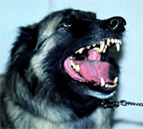
| | |
Neuropathology
Section trough the cerebellum of an 8 week old Coton de Tuléar dog with early onset of rapidly progressive cerebellar ataxia.HE, 200X.
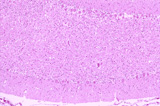
 What do you see? What do you see?
Answer: This is a massive depletion of the granule cells. Cerebellar granule cell atrophy is a neurodegenerative condition which has been described in a number of dogbreeds. In the Coton de Tuléar dog, the defect appears to be a congenital immunedefect leading to immunopathological destruction of the granule cells.
If you would like to learn more about veterinary neuropathology, visit the ESAVS course, 2007 in Bern Switzerland.
Course Masters in charge: Prof. Dr. Marc Vandevelde(CH)
Dr. Robert Higgins (USA), Dr. Georg Krinke (CH)
Overview:
This intensive course is specifically designed for diagnostic pathologists. We teach a systematic and practical approach to solve neuropathological problems starting from key morphologic features on macroscopical and histological examination. Further differentiation of such key features is trained by practical demonstration of a variety of specific lesions, which are than further studied in individual slide sessions. The course covers the major neurological diseases in domestic and laboratory animals. The course masters have taught this programme many times over the past several years. Course evaluations and feed back from former participants have shown that this concentrated effort is very effective and provides a solid base for further individual development in neuropathology.
Topics:
- General Neuropathology
Practical gross neuroanatomy for pathologists. Interpretation of the anamnesis, neurologic data. Braincutting/ representative sampling, processing. Gross lesions/ malformations. Basic reactions of the CNS to damage. General strategy in neurohistology. Wet lab: braincutting and representative sampling. Histolab: basic reaction patterns
- Inflammation
Principles of neuroimmunology and inflammation in the CNS. Special diagnostic techniques. Differential diagnosis of inflammatory/infectious diseases of the CNS: viral bacterial, protozoal, fungal, parasitic. Histolab: morphologic features of major inflammatory diseases
- Tumors and Malacias
Tumors of the nervous system in domestic animals. Tumors of the CNS in laboratory rodents. Trauma and infarcts. Toxic-metabolic diseases. Histolab: Tumors and malacias.
- Degenerations
Central nervous system/ picking up subtle lesions. Major types of degenerative lesions. Peripheral nervous system/muscle. Histolab: Degenerations.
- Spongy state in the CNS
Spongiform encephalopathies : BSE and Scrapie, an update. Other diagnostic methods for spongiform encephalopathies. Other spongy states/vacuoles in the CNS. Histolab: Spongiform encephalpathies and differential diagnosis
Download Registration Form
| | | | |
AVMF receives donations of nearly $100,000 for Katrina relief
The AVMF (American Veterinary Medical Foundation) reports almost $100,000 has been donated through the non-profit`s Web site. The money is slated for disaster relief efforts involving animals in hurricane-stricken areas of the Gulf Coast region.
While the donations were tallied just days following devastation caused by Hurricane Katrina, officials expect more will be contributed to the foundation`s disaster relief emergency fund, which supports aid for animals in disasters.
In addition, the foundation also supports Veterinary Medical Assistance Teams deployed by the Federal Emergency Management Agency to assist in treating injured animals and to provide public health advice.
Four VMAT units have been tapped to serve, bringing roughly 240 veterinarians, technicians and assistants into needed areas, the American Veterinary Medical Association reports.
AVMF officials add that the organization`s Web site now accepts international donations. For information on how to support animal relief efforts, visit www.avmf.org.
Source: www.dvmnewsmagazine.com/dvm/
| | | | |
Small Animal Reproduction I
Under the scientific responsibility of the European Veterinary Society for Small Animal Reproduction (EVSSAR) a new training programme Small Animal Reproduction is offered by European School for Advanced Veterinary Studies (ESAVS).
Nantes / France
12-17 September 2005
| | 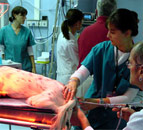
| | |
... and the winners are:
Five dermatology case study winners received a prize at the AVMA meeting. They won a trip to the George H. Muller Veterinary Dermatology Seminar in Hawaii this November for their written and photo submissions of dermatological cases in the practice setting. The case study challenge was sponsored by the drugs Clavamox and Zeniquin through Pfizer Animal Health.
Pfizer announced the award-winning practitioners during the American Veterinary Medical Association meeting in Minneapolis.
A panel of veterinarians reviewed almost 100 cases and judged the entries based on diagnosis of conditions that attributed to the disease, appropriate use of branded drugs, other treatments and photo quality.
The name of the winners were:
Dr. Tony Woodward, Animal Dental Care, Colorado Springs, Colo. Dr. Ned Bartlett, Harbor Animal Hospital, Winthrop Harbor, Ill. Dr. Nancy Soares, Cummings Veterinary Hospital, Easton, Pa. Dr. Ronald Poisker, Johnson-McKee Animal Health, Salisbury, Md. Dr. Chris Jenkins, Creature Comfort Animal Clinic, Arlington, Texas
Source: www.dvmnewsmagazine.com/dvm/
| | | | |
Drug delivery in the canine and equine eye
Often dogs and horses show conjunctivits, uveitis, corneal lesions or other eye diseases which require topical therapy. But how exactly do they influence parameters like aqueous and vitreous humor volume and scleral surface area and thickness? A very interesting study!
Ocular surface area, scleral thickness, and the aqueous and vitreous humor volumes in the canine and equine eye were measured. Fourteen canine and 16 equine cadaver eyes were included in this study.
Eyes were measured either fresh or following fixation in formalin. Ocular surface area was calculated using the fluid displacement method. Globes were hemisected and aqueous and vitreous humor were collected and quantitated. Scleral thickness was measured by digital caliper, by image projection, and by ultrasonic biomicroscopy (UBM).
Results: Mean ± standard deviation (SD) scleral surface areas in canine and equine eyes were 12.87 ± 2.24 and 57.23 ± 5.63 cm2, respectively. Mean ± SD aqueous humor volume was 0.77 ± 0.24 in the dog and 3.04 ± 1.27 mL in the horse. Mean vitreous humor volume was 1.7 ± 0.86 mL for the canine eye and 26.15 ± 4.87 mL for the equine eye. In canine and equine eyes, the sclera was thinnest at the ocular equator: 0.34 ± 0.13 mm (canine) and 0.53 ± 0.1 (equine). There were no significant differences between the direct caliper and projected thickness measurements or differences between measurements in the superior, inferior, nasal, and temporal quadrants of the eye. Scleral thickness in fresh tissue was greater than in fixed tissue at most sites.
Conclusions: The UBM measurement method appeared to be most consistent and reproducible when compared to direct measurement techniques. Formalin fixation of the eyes was associated with significantly thinner scleral tissue than with fresh ocular tissue
Source: Gilger, Brian C., Reeves, Keri-Ann & Salmon, Jacklyn H. (2005): Ocular parameters related to drug delivery in the canine and equine eye: aqueous and vitreous humor volume and scleral surface area and thickness. In: Veterinary Ophthalmology 8 (4), 265-269.
| | | | |
Metabolism of progesterone by canine hair follicle cells (In vitro)
Still not much is known about the metabolism of sex hormones in the hair follicles. This new study from Vienna adds some interesting news to the things we already know.
Dermal papilla cells (DPC) and dermal fibroblasts (DFB) derived from hair follicles from two different body sites (head, flank) of four male, castrated beagle dogs were incubated for 24 h with radioactive progesterone (P4).
Thin-layer chromatography was used for separation and autoradiography for identification of the radioactive metabolites.
In DFB the main metabolites were cortisol and 4-pregnene-11 -ol-3,20-dione, whereas in DPC they were 5 -pregnane-3,20-dione and cortisol. The highest percentage of metabolism of P4 was found in DFB of the head.
Smaller amounts of other metabolites were found in both cell types of both locations.
Source: BAMBERG, ELMAR, AICHINGER, AMANDA & WĂNSCH, GERDA (2005): In vitro metabolism of progesterone by canine hair follicle cells. In: Veterinary Dermatology 16 (3), 153-155.
| | | | |
MasterÂs degree in Management and Administration of Veterinary Centres
The Spanish Small Animal Veterinary Association (AVEPA) will be starting a new training program. In collaboration with the Spanish Institute of Veterinary Economic Studies (IVEE) and Autonomous University of Barcelona (UAB) the equivalent of a full-fledged MBA course will be offered.
Results of extensive studies conducted in veterinary clinics around the world
(AVMA 2000, AAHA 2001, and AVEPA 2004) revealed that there is a parallel between good economic management and higher quality of veterinary service, be it through better patient attention or through improved facilities.
To find out more about the offered courses view the AVEPA Press Release.
| | | | |
Canine influenza establishes in Connecticut
Not only bird flu, also canine flu has become important during the last months. The newly identified influenza strain is thought to origin from horses, can mimic kennel cough and has already killed racing greyhounds.
Two cases have been confirmed by the Animal Health Diagnostic Center at Cornell University, reports State Veterinarian Mary J. Lis.
The newly identified influenza strain mimics kennel cough but does not respond well to conventional antibiotic treatments, experts say. First recognized in racing Greyhounds, canine influenza has spread to dog populations in a handful of states. Death due to pneumonia complications occurs in up to 8 percent of all cases, experts say.
The Connecticut cases, confirmed via serologically positive tests, came from a West Hartford kennel where employees noticed an increasing number of respiratory problems among intakes, Lis says. Although the virus is highly contagious, she advises veterinarians not to be alarmed.
`Everyone is concerned, but I don`t think we need to send out an alert,` Lis says. `Influenza in general has been getting a lot of press lately. It`s the season for respiratory disease.`
Source: www.dvmnewsmagazine.com/dvm/
| | | | |
Colorado State University receives $2-million grant for Listeria study
There are about 2,500 cases of food-borne illnesses caused by Listeria monocytogenes each year result in about 500 deaths. Now Animal sciences professor John Sofos and his research team were awarded $2 million to study how to control the transmission of Listeria in food-processing and foodservice facilities.
Listeria monocytogenes also can induce meningitis in people with a weakened immune system and miscarriages and stillbirths in infected pregnant women.
About one-third of all Listeria cases are recorded in pregnant women, and the mortality rate is about 20 percent to 30 percent.
`Food-borne illness from Listeria has the most significant impact on pregnant women, newborns, the elderly and adults with weakened immune systems,` Sofos says.
In the last several years, large-scale outbreaks have led to initiatives, including a new regulation for, within the regulatory agencies and the food industry, to control the presence of the bacterium and prevent its survival and growth in ready-to-eat products.
The National Integrated Food Safety Initiative of the U.S. Department of Agriculture, which will fund the project through September 2009, awarded the grant.
Source: www.dvmnews.com/dvm/
| | | | |
How does the immune system recognize and respond to cancer?
An extremely interesting and fascinating question! Researchers at the California Los Angeles (UCLA)Âs Jonsson Cancer Center were able to observe - in real time - how the immune system initially recognizes cancer and mobilizes to fight the disease. These insights became possible using positron emission tomography (PET) imaging...
The UCLA study is expected to lead to new ways to test immune-based therapies for cancer and other immune system-related diseases and to monitor human response to cancer treatments much more quickly and without the need for invasive biopsies, said Dr. Owen Witte, a Jonsson Cancer Center researcher, a professor of microbiology, immunology and molecular genetics and the study`s senior author.
The study appeared in the Nov. 29, 2005 issue of the Proceedings of the National Academy of Sciences and will be published in an early online edition. `This study is teaching us about how the immune system recognizes cancer. That`s something we couldn`t see before,` said Witte, who also serves as director of the UCLA Institute for Stem Cell Biology and Medicine and is a Howard Hughes Medical Institute investigator.
`We were able to watch the primary immune response, the very first reaction of the immune system to the presence of cancer in body. This gives us a new tool that will allow us to evaluate novel ways to help the immune system become better at finding and eliminating cancer as well as studying autoimmune and immune deficiency disorders.`
In the study, Witte and his team removed bone marrow from a laboratory animal and marked all the cells that would be derived from the bone marrow stem cells with two radioactive probes that are detected by a PET scan. Because they used different probes that show in different ways the cell functions, the research team was able to see more of what was going on in the immune system as it fought cancer, Witte said.
The bone marrow was then put into a different laboratory animal and cancer was introduced so researchers could monitor the immune response observing the movement and behavior of lymphocytes and myeloid cells, the cells the immune system uses to fight foreign invaders.
`We were able to observe the moment that the immune system sees the foreign antigens of the cancer in the body and its response, which starts in the local draining lymph nodes,` Witte said. `We saw an increased number of lymphocytes and myeloid cells in those lymph nodes, then saw them migrating to the tumor in an attempt to kill the cancer.`
One of the probes used to mark the immune system cells and cause them to light up under PET scan, the agent FDG, already is approved for use in humans, Witte said. This could prove valuable in monitoring human response to immune-based therapies such as cancer vaccines. Researchers could use FDG and PET scanning, for example, on a patient receiving an experimental cancer vaccine.
Jonsson Cancer Center researchers testing a melanoma vaccine will be collaborating with Witte and his team to monitor immune response in those study volunteers, Witte said. If the therapy is not working, the volunteers would not have to undergo months of unsuccessful treatment and could potentially find another therapy to try. PET scanning, developed by UCLA scientist Michael Phelps, is a highly sensitive detection method that provides three-dimensional information within the body.
The probes used in this study are labeled with positron-emitting radioisotopes, which allow researchers to measure the rates of biochemical processes in the tissue, processes such as immune response.
`Many of the problems in evaluating immunotherapy protocols stem from the lack of effective tools to follow the extent and duration of responses to treatment,` the study states. `In this study, we have demonstrated a strategy to monitor a specific primary immune response against a tumor challenge.`
Source: www.vetschite.org
| | | | |
Aflatoxin contaminated pet food also in the EU
Aflatoxin containing dog food has been identified in the USA some weeks ago. But regarding to the following statement of the Food and Drug Administration (FDA) this food has also been exported in 29 countries including those of the European Union.
FDA Statement FOR IMMEDIATE RELEASE December 30, 2005
The FDA is conducting an investigation into the deaths and illnesses of dogs that consumed pet food contaminated with a potent toxin called aflatoxin.
To date, FDA is aware of 23 dogs that have died and another 18 dogs that have become ill. The pet food is made by Diamond Pet Food at its Gaston, South Carolina facility.
Customers who have purchased the recalled Diamond Pet Food manufactured in the South Carolina plant should immediately stop using it and return any remaining product to their retailer.
Aflatoxin comes from a fungus found on corn and other crops and can cause severe liver damage in pets. Consumers are urged to contact their veterinarian if their pets exhibit any of the following symptoms which may indicate aflatoxin consumption:
Sluggishness
Loss of appetite
Jaundice (yellow whites of the eyes, gums, belly)
Severe, persistent vomiting combined with bloody diarrhea
Fever
FDA also has discovered that some of the recalled product was exported to at least 29 countries, including countries within the European Union. These countries have been notified.
FDA is continuing to investigate the situation and is working closely with the state feed regulatory agencies in the affected states.
Source: www.fda.gov/oc/po/firmrecalls/diamond12_05.html
| | | | |
Texas A&M university creates new equine center
According to the Texas A&M University officials a Center for Equine Business Studies is slated to open in June. It will provide equine statistics and data to the government and public to help the equine industry build business. Additionally, it will provide economic and market information, as the center`s Executive Director Dr. Ernie Davis says.
Davis says it is the university`s goal to provide information in the field of veterinary medicine and agriculture. This venture will add to the university`s ability to provide information to media, government and public regarding the horse industry.
The center could provide economic analysis for impacts of programs and proposed legislation in the U.S. and horse industries, Davis says in a prepared statement.
The center will receive information from the Strategic Development Council that will meet at Texas A&M in February. A Blue Ribbon Advisory Panel will be formed to provide feedback.
Source: www.dvmnewsmagazine.com/dvm/
| | 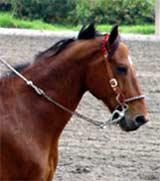
| | |
Small Animal Reproduction Congress
5th EVSSAR Congress
7th - 9th April 2006 Budapest, Hungary

| | 
| | |
10th Jubilee Dermatology Symposium in Poland
1 - 2 April 2006
Lublin, Poland
Speakers: David Grant, David Lloyd
Dear fellow Dermatologists,
The Symposium Organizing Committee is very proud and honored to invite you to attend and enjoy the 10th Jubilee Dermatology Symposium, which will take place in Lublin, Poland, from 1st to 2nd September 2006.
SATURDAY 1st April 2006
08.30-10.00 Registration
10.00-10.15 Opening Ceremony
10.15-11.05 Perianal disease, David Grant
11.05-11.10 Pause
11.10-12.00 Bacterial overgrowth in the dog, David Lloyd
12.00-12.45 Break, exposition
12.45-13.35 MRSA infection in dogs and cats, David Lloyd
13.35-13.40 Pause
13.40-14.30 Clinical cases, David Lloyd
14.30-15.30 Lunch, exposition
15.30-16.25 New feline and canine diseases, David Grant
16.25-16.35 Pause
16.30-17.30 Clinical cases, David Grant
20.00 Gala Dinner
SUNDAY 2nd April 2006
09.00-09.40 Pustular diseases, David Lloyd
09.40-09.45 Pause
09.45-10.30 Clinical cases, David Lloyd
10.30-11.00 Break, exposition
11.00-11.55 Canine tumours, David Grant
11.55-12.05 Pause
12.00-13.00 Clinical cases, David Grant
13.00-14.00 Lunch, exposition
14.00-14.45 Alopecia X, David Lloyd
15.45-14.50 Pause
14.50-15.30 Feline alopecia, David Grant
Registration Form - Registration Form - Registration Form - Registration
SYMPOSIUM OFFICE
Zaklad Diagnostyki Klinicznej i Dermatologii Weterynaryjnej
Ul. Gleboka 30, 20-612 Lublin, Poland
Tel/fax: +48 81 445 61 94 (9.00-14.00)
e-mail: pomorska@hot.pl
| | 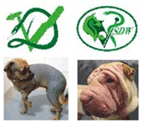
| | |
Lifestyle factors taking influence on the prevalence of allergies in children
The prevalence of allergic diseases has increased rapidly in recent decades, particularly in children. For adequate prevention it is important not only to identify risk factors, but also possible protective factors. A very interesting study from the PARSIFAL group!
The aim of this study was to compare the prevalence of allergic diseases and sensitization between farm children, children in anthroposophic families, and reference children, with the aim to identify factors that may protect against allergic disease.
The study was of cross-sectional design and included 14 893 children, aged 5šC13 years, from farm families, anthroposophic families (recruited from Steiner schools) and reference children in Austria, Germany, the Netherlands, Sweden and Switzerland. A detailed questionnaire was completed and allergen-specific IgE was measured in blood.
Results: Growing up on a farm was found to have a protective effect against all outcomes studied, both self-reported, such as rhinoconjunctivitis, wheezing, atopic eczema and asthma and sensitization (allergen specific IgE ÂĄĂ0.35 kU/l).
The adjusted odds ratio (OR) for current rhinoconjunctivitis symptoms was 0.50 (95% confidence interval (CI) 0.38šC0.65) and for atopic sensitization 0.53 (95% CI 0.42šC0.67) for the farm children compared to their references.
The prevalence of allergic symptoms and sensitization was also lower among Steiner school children compared to reference children, but the difference was less pronounced and not as consistent between countries, adjusted OR for current rhinoconjunctivitis symptoms was 0.69 (95% CI 0.56šC0.86) and for atopic sensitization 0.73 (95% CI 0.58šC0.92).
Conclusions: This study indicates that growing up on a farm, and to a lesser extent leading an anthroposophic life style may confer protection from both sensitization and allergic diseases in childhood.
Source: T. AlfvšŠn et al (2006): Allergic diseases and atopic sensitization in children related to farming and anthroposophic lifestyle šC the PARSIFAL study. In: Allergy Volume 61 Issue 4 Page 414 - April 2006
| | | | |
Vets4Africa combines science and adventure
Vets4Africa brings veterinary science professionals from around the world to experience Africa in a way uniquely tailored to complement their professional interests.
| | 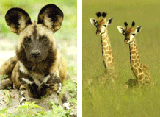
| | |
World Veterinary Conference 2006 in Czech Republic
31st WSAVA, 12th FECAVA, 14th CSAVA Congress 2006
278 lectures in 28 scientific disciplines presented by 100 top speakers from all continents.
| | 
| | |
Feline Congress
ESFM - European Society of Feline Medicine
Rome, Italy
8 - 10 September 2006
First class cpd lectures in the comfortable venue, in the fantastic location...
| | 
| | |
Mobility; a multi-disciplined approach
Iams Clinical Nutrition Symposium 2006 - Proceedings
_______________________
Improving Mobility.
Does human intervention hinder or help?A leading panel of experts in small animal physiotherapy and rehabilitation, surgery, nutrition, and human obesity, met at the Iams Clinical Nutrition Symposium on February 10th 2006 in Montreux, Switzerland. At the centre of the discussion was how human intervention can positively influence mobility in companion animals, and how dogs could actually help improve the lifestyle of overweight humans to help facilitate weight loss and improve human mobility.
Key findings from the expert panel include;up to 44% of dogs and up to 35% of cats are overweight or obese
it is estimated that as many as 20% of dogs suffer from osteoarthritis and 34% of cats suffer from joint problems which can affect their mobility
weight loss is an important factor for improving mobility
cats and dogs are predisposed to trauma of the limbs due their lifestyle
over the last 10 years there has been dramatic advancement in surgical management techniques to improve mobility
total hip and elbow replacements are available to give pain free mobility
animals with orthopaedic disorders can get into a vicious cycle of decreased daily exercise and increased weight gain
combining weight loss and physiotherapy significantly improves existing lameness and mobility
owners are very important for any implementation of physiotherapy and rehabilitation regimes to help improve patients mobility
the last two decades has seen a rapid, world-wide spread of mobility-related diseases in humans, even in relatively poor countries
mobility of humans has been reduced due to changes in our lifestyle and eating habits
dogs offer an unique opportunity to help encourage overweight humans to exercise more and improve their mobility
Read the REPORT.

List of proceedings:Proceedings Copyrights © 2006
The Iams Company
47. Route de Saint-George
CH-1213 Petit-Lancy 1
Geneva
Switzerland
DIAGNOSTIC IMAGING OF ORTHOPAEDIC PROBLEMS
IN SMALL ANIMALS: A PRACTICAL GUIDE, Professor Dr. Henri van Bree, DVM, PhD, DipECVDI, DipECVS
DIAGNOSTIC AND SURGICAL ARTHROSCOPY IN DOGS, Dr. Jean-François Bardet, DVM, MS, DipECVS
STATE OF THE ART JOINT REPAIR IN VETERINARY MEDICINE, Professor Dr. Ulrike Matis, Prof. Dr. med. vet, Dr. med. vet. habil (PhD), DipECVS
THE ORTHOPAEDIC PATIENT: CONSERVATIVE TREATMENT, PHYSIOTHERAPY AND REHABILITATION, Barbara Bockstahler, DVM, FTA Physical Therapy and Rehabilitation
MAXIMISING MOBILITY WITH NUTRITION, Dr. Daniel Carey, DVM und Dr. Allan Lepine, PhD
CAN CANINE MOBILITY BENEFIT HUMAN HEALTH?, Erik Hemmingsson, PhD
HUMAN MOBILITY Â BENEFITS AND LIMITATIONS OF TOTAL JOINT REPLACEMENT IN THE HIP AND KNEE, Professor Dr. Volkmar Jansson, Prof. Dr. med, Dipl.-Ing
More information can be found at www.eukanuba-scienceonline.com

| | 
| | |
ECVIM-CA Congress in Amsterdam / Netherlands 2006
This Congress organized by the European College of Veterinary Internal Medicine offers an excellent program with cutting edge information in various disciplines of veterinary medicine.

_______________________
| | 
| | |
Endoscopy Intensive Course
Veterinary Endoscopy
Total Emerge!
10-14 July 2006

_______________________
European School for Advanced Veterinary StudiesThis veterinary course in theoretical and practical endoscopy is designed for clinician`s with basic skills or none at all, in rigid and flexible endoscopy. We cover instrument handling from how to set up the endoscope to maintenance and cleaning. Many tricks are discussed and shown since all course masters have been involved in endoscopic teaching for many years.
Morning classroom teaching on basically all aspects of endoscopic utilisation in small and exotic animals, which is followed daily by a practical wet lab on live animals, cadavers and models. Small groups with several instructors will enhance the learning effect.
Topics:
Laparoscopy
Thoracoscopy
Rhinoscopy
Otoscopy
Esophago-Gastro-Duodenoscopy
Colonoscopy
Bronchoscopy
Cystoscopy
Therapeutic endoscopic interventions
Endoscopy of exotic animals
Course master: Prof. Dr. Reto Neiger
Co-lecturers: Prof. Dr. Henry van Bree (B), Dr. Ingrid Gielen (B), Dr. Christiane Stengel (D), Prof. Dr. Zdenek Knotek (CZ)
Course duration: 5 days / 10-14 July 2006
Course location: Brno / Czech Republic
Course fee: EURO 1.750,-
Daily rate: EURO 350,-
The price includes: proceedings, coffee, lunch and a social evening
Hotel: from 26Â to 70Â / per person / per night
Interested?
Please contact our office:
info@esavs.org
fax: +49 6782 4314
... or register
Registration form
Further details: www.esavs.org
or in the ESAVS information brochure: Order Free Information Brochure
| | 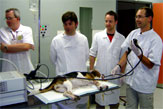
| | |
No higher incidence of diseases in rescue dogs from September 9th
More than 4 years after September 9th 2001 the University of Pennsylvania gives preliminary results of a still ongoing study in rescue dogs: Do the dogs `working` on Pentagon and World Trade Center show an increased rate of diseases today, especially of clinical signs of nasal or respiratory cancers? A question which is also of enormous interest for men...
`Because of increased metabolic rates, dogs and cats often display early signs of disease when exposed to the same carcinogens as humans,` says Iams Company Veterinarian Dr. Dan Carey, who has tracked the health of the canine participants for the past four years.
`While it`s impossible to form concrete conclusions about human health, this study allows us to track physical changes in the dogs and may provide an early warning of problems that could show up in humans years later.`
Iams partnered with the University of Pennsylvania and the American Kennel Club Canine Health Foundation to host the five-year study, which uses magnetic resonance imaging to identify early warning signs of health issues, primarily cancer in canine first responders.
The study, which launched in 2002, has been tracking the health of 12 search and rescue dogs that volunteered time in the rescue, recovery and relief missions at Ground Zero and the Pentagon post 9/11.
Source: www.dvmnewsmagazine.com/dvm/
| | | | |
Veterinary Ophthalmology: HAWK EYE portable digital slit lamp by DIOPTRIX
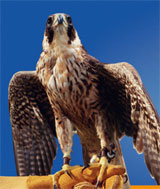
Veterinary Ophthalmology - HAWK EYE by DioptrixThe Hawk Eye portable digital slit lamp gives exceptional result of colours as well as pictures of perfect quality thanks to the optical block and the purely white light provided by a 5 W white diode (LED).
Show and share your instant pictures or videos straight away with the owner of the animal, your colleagues or correspondents
Carry out your examinations easily while you are in unusual conditions
Plug your HAWK EYE into the cigarette-lighter with the supplied car power set charger and recharge its main battery

Technological innovations:
Digital instant iconography
Built on high resolution digital camera: 6.0 megapixels
Digital 2.5 inch monitor
DivXÂź Certified Encoder device
High speed USB 2.0 connector
Security
The white LED (diode) reduces the light hazards to the patientÂs retina from ophthalmic instruments using classical bulbs (tungsten, halogen or xenon).*
Optical quality
Excellent optical quality of the objectives, which, combined with the white LED, allows a very high-performance instrument in terms of colour results.
Ideal light
Extremely bright cold light source from 5W white LED
Exceptional colours results, 17.000 lux
Ultraviolet and infrared filters
Low heat emission
Image quality
Hawk Eye : 3 step Galilean magnification changer (8x,12.5x,20x)
Digital camera : powerful 3X zoom sliding lens system
Image magnification : 10 x
Practicability and autonomy
Rechargeable Lithium-ion battery
Built in fast charger
Car power set charger
2 hours long lasting illumination
DIOPTRIX
13, rue d`Ariane
31240 L`Union
France
Phone: +33 (0) 534 301 244
Fax: +33 (0) 561 610 995
Email: info@dioptrix.com
Web: www.hawkeye-slitlamp.com
| | 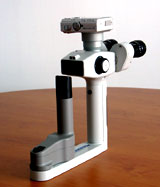
| | |
Physiotherapy on Dogs: the KEIPER Underwater Treadmill
Aquatic therapy, also called hydrotherapy, aqua training or underwater training, is a very effective method of rehabilitation in dogs to build up muscle strength and improve mobility without any additional stress on the joints.
Underwater treadmill for physiotherapy and aquatic therapy on dogs
The WATER-WALKERÂź underwater treadmill makes it possible for an animal to exercise muscles, tendons, ligaments and joints of limbs following injuries and / or surgery (animal physiotherapy). The buoyancy of the water removes much of the pressure from the painful limbs. Dogs quickly regain muscle tone and range of motion in limbs that have atrophied due to injury.
When dogs are using the underwater treadmill (aqua trainer), they are able to work on many things at one time. Their gait is often exaggerated, new muscle groups are engaged, extra balance is required on the treadmill, they are able to bear weight on guarded limbs better, and the treadmill compliments both neuromuscular re-education and agility.
The viscosity of the water creates resistance to the muscles, resulting in a great strength and endurance workout (aquatic training).
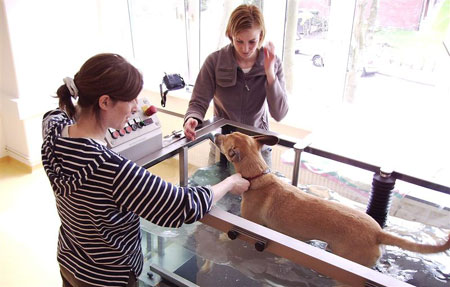
Underwater treadmill for dogs - aquatic therapy
Areas of use for the Keiper underwater treadmill in animal physiotherapy
- Physiotherapy: rehabilitation and recovery after surgery, injuries and orthopaedic disorders (dog physiotherapy)
- Wellness and fitness training without additional stress on the joints due to water buoyancy
- Effective aid in the faster recovery of neurologic disorders
- Exercise therapy for muscle build-up and circulation training
- Treatment of temporary paralysis and coordination disorders of the musculoskeletal system
- Swim training and improvement of performance in sport dogs
- Compensation for lack of exercise and improvement in muscle tone
- Effective swim or walk exercise using water counterflow system
- Thermotherapy with thermostat controlled water temperature ranging from
10  40 °C
- Dry run training
- Water massage above or under water
- Desinfection baths

Physiotherapy on dogs: hight regulation of the underwater treadmill during hydrotherapy (aquatic therapy)

Underwater treadmill for dogs - cleaning position
The advantages of hydrotherapy on dogs (aquatic therapy) with the KEIPER WATER WALKERÂź have been regognised and confirmed by a wide circle of experts.
The aqua trainer (underwater treadmill) can be accessed and the movement of an animal can be easily observed through the glass from all sides for optimal work and training conditions.
Its ergonomic and innovative design combined with low maintenance and safety was developed in cooperation with animal physiotherapists and veterinarians, and is recommended by small animal hospitals all over Europe. Ample accessories can be added, like reverse energy flow with an underwater massager.
This makes the WATERWALKERÂź underwater treadmill for dogs an indispensable training equipment for recovery as well as for wellness and performance training (dog physiotherapy / aquatic training).
The KEIPER WATER-WALKERÂź was distinguished with the Innovation Award 2004.
For more detailed information about the KEIPER WATER-WALKERÂź underwater treadmill, examples of operation and media reports on physiotherapy in dogs please visit www.water-walker.de
KEIPER underwater treadmill for dogs
Address of the producer:
Keiper Fördertechnik
LandsbergerstraĂe 12-15
67823 Obermoschel
Germany
Phone: (+49) 06362 - 721
Fax: (+49) 06362 - 3430
Internet: www.keiperkg.de or www.water-walker.de
Email: info@keiperkg.de
| | 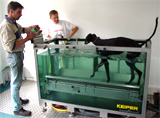
| | |
Veterinary Dermatology Intensive Course
The successful management of skin diseases and dermatological disorders in animals.
Dermatology I, Vienna / Austria
24 July - 4 August 2006Next veterinary dermatology courses 2007
This intensive veterinary dermatology course of the European School for Advanced Veterinary Studies (ESAVS) offers a great opportunity for the general practitioner to learn about a large number of common veterinary dermatological disorders and treatments. Wet lab sessions, in an excellent equipped laboratory, will also give practical experience in this discipline. Taught by highly experienced tutors of dermatology, this is a course well worth attending.
Please note: The dermatology courses of ESAVS are routinely recognized by the European College of Veterinary Dermatology (ECVD). which means they satisfy all the required criteria for continuing recognition in this discipline. Further information about credits for Dermatology can be found on the ECVD page: www.ecvd.org.
Course masters: Prof. Dr. David Lloyd (UK), Prof. Dr. Richard E.W. Halliwell (UK), Dr. Wayne Rosenkrantz (USA)
Topics week 1:
- Structure and function of epidermis and dermis
- Hair follicle and adnexae: anatomy and physiology
- Introduction to components of the skin immune system
- Laboratory practical: examination methods for skin, skin structure and hair morphology
- The diagnostic approach in dermatology
- Taking the history, physical examination, diagnostic tests
- worked case examples, focus on history and clinical signs - whole group then in small groups; computer-aided learning (Labs)
- Ectoparasitic infestations: Demodex, Sarcoptes, Notoedres, Otodectes, Cheyletiella
- Insects, ticks, other mites
- diagnostic techniques in parasitology (Labs)
- The skin as a microbial habitat
- Canine pyoderma, Dermatophytosis, Malassezia dermatitis
- diagnostic techniques in bacteriology & mycology (Labs)
- Gross skin pathology and patterns of inflammation
- Correlation of microscopical and gross pathology with special reference to allergy, parasitic and microbial infection
- gross and microscopic pathology; clinico-pathological correlations (Labs)
- Introduction to the immune system including mechanisms of allergy, autoimmunity and immunodeficiency diseases
- Introduction to cutaneous cytology
- The approach to pruritus
- Allergic contact dermatitis
- Food alllergy: introduction and clinical signs
- Diet trials and dietary management
- Atopic dermatitis: clinical signs and differential diagnosis
- Atopic dermatitis: medical management
- Allergen specific immunotherapy
- Technique of Intradermal testing and interpretation (Practicals)
- Skin testing laboratory
- Flea allergy and flea control
- Miscellaneous allergies
- Feline skin reaction patterns and allergic skin diseases
- Otitis: introduction, pathogenesis and diagnosis
- Otitis therapy - cleansing, topical and systemic
Topics week 2:
- Introduction to the immune system including mechanisms of allergy, autoimmunity and immunodeficiency diseases
- Flea allergy and flea control
- Immunopathogenesis of canine atopic dermatitis
- Atopic dermatitis: clinical signs and differential diagnosis
- Allergy testing (intradermal and in vitro)
- Allergen specific immunotherapy
- Medical management of atopic dermatitis
- Skin testing laboratory
- Food allergy: Pathogenesis and clinical signs
- Food allergy: Diagnosis and management
- Contact allergy
- Introduction to cytology
- Cytology lab / Cases
- Miscellaneous allergies: hormonal, mosquito, eosinophilic furunculosis of face, eosin necrotising folliculitis/vasculitis
- Feline skin reaction patterns and allergic skin diseases
- General approach to pruritus
- Instructors problem solving cases
- Otitis: introduction, pathogenesis and diagnosis
- Otitis therapy  cleansing, topical and systemic
- Discussion of participantÂs cases
General InformationCourse duration: 24 July - 4 August 2006
Course location: Vienna / Austria
Course masters: Prof. Dr. David Lloyd (UK), Prof. Dr. Richard E.W. Halliwell (UK), Dr. Wayne Rosenkrantz (USA)
Tuition fee: Â 1.750,-
Daily rate: Â 175,- / course day
The price includes: proceedings, coffee, lunch and a social evening
CE credits: 65 CE credit hours of ATF (Akademie fĂŒr TierĂ€rtzliche Fortbildung)
Hotel: from  50 to  90 / per person / per night
Interested?
Please contact ESAVS office:
info@esavs.org
fax: +49 6782 4314
REGISTRATION - REGISTRATION - REGISTRATION
Manual Registration via fax
Further details: www.esavs.org
or in the ESAVS information brochure: Order Free Information Brochure
| | 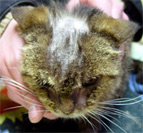
| | |
24th Annual Veterinary Pathology Meeting of the ESVP - University of Edinburgh, Scotland, UK
The 24th European Society of Veterinary Pathology (ESVP) Conference in 2006 will be a comprehensive mixture of keynote lectures from invited speakers and contributed papers on a range of naturally-occurring and experimentally-induced disease pathology topics. There will also be poster presentations and trade exhibits.
31 August - 2 September 2006

| | | | |
Professional Development
Veterinary Continuing Education
Veterinary Neurology I
21 - 25 October 2006
Berne / Switzerland
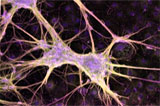
www.esavs.org
_______________________
| | | | |
Congress News 2006
WSAVA / FECAVA / CSAVA
10 - 11 October 2006
Issue No 1
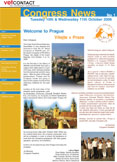
12 October 2006
Issue No 2
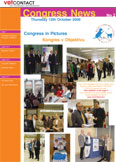
13 - 14 October 2006
Isssue No 3
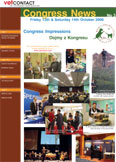
| | | | |
CPD / CE Courses for Veterinarians
Order the ESAVS free information brochure and learn more about the veterinary intensive training programs in over 16 disciplines in Europe and Asia.
Small Animals,
Exotic Pets,
Equine Medicine
| | 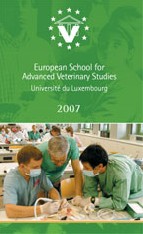
| | |
Canadian Veterinary Medical Association - CVMA Convention 2007
Top-notch continuing education in veterinary medicine, the opportunity to see old friends and make new ones, a beautiful part of Canada worth visiting  that is what the 59th CVMA Convention experience is all about.
Companion Animal, Bovine, Equine and Other...
| | 
| | |
Annual Meeting of the European Association of Veterinary Diagnostic Imaging 2007
August 29th - Sept 1st 2007
Thessaloniki / Greece
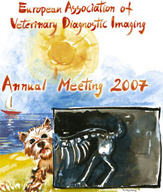
| | | | |
22nd Annual Veterinary Dermatology Congress of ESVD-ECVD
Congress Centrum Mainz
13 - 15 September 2007
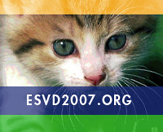
ESVD/ECVD Pre-Congress Symposium12th September 2007
The Kurhaus Wiesbaden
Germany ******************************** ********************************
| | 
| | |
Veterinary Neurology Symposium 2007
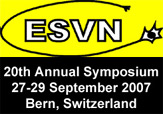
Theme: Inflammatory and infectious diseases of the nervous system in animals.
*******************************
| | | | |
Equine - Dentistry Basic Course with Workshops
23 - 27 July 2007, Hannover / Germany
During the five days of this equine course veterinarians will be taught to diagnose and treat dental problems in horses. The participants will be split into groups; each group will make a diagnosis and treatment plan for various horses.
| | 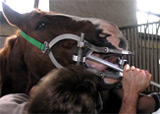
| | |
13th European FECAVA Congress 2007
The event will be both an impressive intellectual and educational forum at highest standard as well as a delightful social experience!
FECAVA Congress
Dubrovnik, Croatia
29 March - 1 April 2007

| | 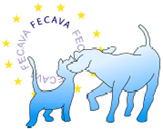
| | |
SEVC 2007 - Southern European Veterinary Conference in Barcelona, Spain
19-21 October 2007
The new veterinary continuing education event in Europe organized by
AVEPA and NAVC

Conference Registration Fees
SEVC 2007 will feature multidisciplinary lectures as well as masterclasses, teaching seminars and practical Âhands-on workshops from top international speakers on practical and contemporary issues. The conference will also include international veterinary specialist groups and associations who will hold their own meetings in conjunction with the SEVC.
The official languages at SEVC are English and Spanish (simultaneous translation in other languages will be also provided).
SEVC 2007 - Congress Website
SEVC 2007 - Conference Preliminary Program
| | 
| | |
6th European Veterinary Emergency and Critical Care Congress 2007
EVECCS Congress
8th - 10th June 2007
Vienna, Austria
The main aim of the European Veterinary Emergency and Critical Care Society is to promote the study, development, and practice of veterinary emergency medicine and critical patient care in Europe.
| | 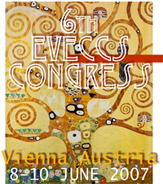
| | |
International Veterinary Ophthalmology Meeting in Genova, Italy
ECVO-ESVO-ISVO-SOVI
Joint Meeting
30th May to 3rd June 2007
| | 
| | |
10th World Veterinary Dental Congress, Brasil, 25 -27 April 2007
The 10th edition of the World Veterinary Dental Congress will consist of three full days of scientifi c and clinical reports, which will be presented in conference and poster sessions.
The main objective of the event will be to share information and to bring together professionals of three important areas in animal dentistry: small animals, equines and wild life.
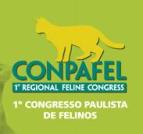
| | 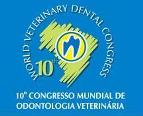
| | |
32nd WSAVA Congress 2007
Sydney, Australia
19 - 23 August 2007
Sydney Convention and Exhibition Centre
Darling Harbourg

View Scientific Program
View List of Invited Speakers
32nd World Small Animal Veterinary Association Congress 2007 - See you in Sydney!
www.wsava2007.com
********************************
| | 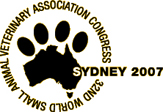
| | |
2nd International Symposium on Pet Bird Nutrition, 4 - 5 October 2007, Hannover, Germany
| | 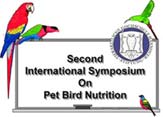
| | |
The EUROPEAN PCV-2 AWARD for the Advancement of Applied Immunological Research - Boehringer
Boehringer Ingelheim Animal Health GmbH is offering a total sum of 75.000 Â annually for the best research proposals in the field of applied immunological PCV-2 research.
********************************
| | 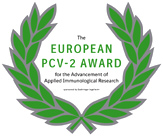
| | |
ECVIM-CA Congress in Budapest / Hungary 2007
This Congress organized by the European College of Veterinary Internal Medicine offers an excellent program with cutting edge information in various disciplines of veterinary medicine.
13 - 15 September 2007

_______________________
| | 
| | |
2nd Veterinary Medicine and Food Safety Supervision Fair WETERYNARIA 2007

| | | | |
ESAVS Courses for Veterinarians and Nurses - 2008
Order the ESAVS free information brochure 2008 and learn more about the veterinary intensive training programs in over 16 disciplines in Europe and Asia.
Small Animals,
Exotic Pets,
Equine Medicine
| | 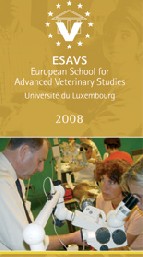
| | |
7th European Veterinary Emergency and Critical Care Congress 2008
7th EVECCS Congress
29th May - 1st June 2008
Göteborg, Sweden
The main aim of the European Veterinary Emergency and Critical Care Society is to promote the study, development, and practice of veterinary emergency medicine and critical patient care in Europe.
Emergency medicine and critical care for vets and technicians.
Pre-congress day - Thursday 29th May 2008
Lectures on:
First aid in the trauma patient
Feline blood transfusions
Enteral feeding tubes
Acute heart failure
Design your ICU
Vascular access
Oxygen therapy
CPCR
Wet labs - Friday morning 30th May 2008
Practical workshops planned on monitoring, ventilation, vascular access and tracheal stenting
Main program Friday 30th May - Sunday 1st June 2008
Thoracic and abdominal trauma
Pathofysiology of trauma
Shock
Fluid therapy
Progress in science
Care of fractures
Head trauma
Use of CT in traumatized humans and animals
Transfusion medicine
Tracheal collapse
Gastro-enterology emergencies
Abstracts / Cases
Veterinary technicians
Lectures on:
Triage
Nursing management emergency cases
Shock
Sedation
(Pre)anesthesia
Post operative management
Analgesia
Wounds and fractures
Nursing care
Monitoring
Life saving techniques
Abstracts / Cases
Speakers: Nuno Felix (PT)/ Bert Jan Reezigt (SE) / Harold Davis (USA) / Matt Beal (USA) / Torkel Falk (SE) / Lisabeth Rem Jessen (DK) / Joris Robben (NL) / Andreas Lervik (NO) / Christina Fragio (ES) / Jennifer Deves (USA) / David Spreng (CH) / Görel Nyman (SE / Bo Wiinberg (DK) / Kate HOpper (USA) / Martin Rapp (SE) / Michael Willard (USA)
====>>>> CONGRESS PROGRAMM - pdf
Become a member of EVECCS and VECCS!
The European Veterinary Emergency and Critical Care Society was founded in Amsterdam 2002. Since that year a yearly scientific congress has been organized.
EVECCSÂŽ important goal is to promote the study, development, and practice of veterinary emergency and critical care in Europe. We do this in affiliation with our American counterpart VECCS. We need you as a member to take part in this. As a member you have multiple benefits like discounts on meetings of EVECCS and VECCS, access to members only pages on the EVECCS and VECCS website, and a personal hard copy of the quarterly published Journal of Veterinary Emergency and Critical Care as well as online access.
Prices
(include membership of both EVECCS and VECCS)
Veterinarian 110 Â
Intern/Resident 85 Â
Veterinary technician 75 Â
Affiliate 75 Â
Student 65 Â
Visit www.eveccs.org for online membership
====>>>> CONGRESS WEBSITE
Congress Venue
Elite Park Avenue Hotel
Kungsportsavenyn 36-38
400 15 Göteborg Sweden
Phone: +46 (0)31 727 1000
Fax: +46 (0)31 727 1010
www.elite.se/eng/node/706
| | 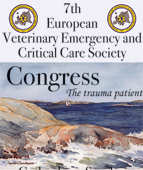
| | |
The Hugo Schindelka Award
The World Congress of Veterinary Dermatology Association invites nominations for The Hugo Schindelka Award.
Extended Nomination Period! 15th February 08
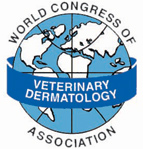
This award commemorates initiation of the scientific approach to veterinary dermatology and its establishment as a discipline in 1903 when Dr. Schindelka, a teacher at the Vienna Veterinary School, published his book, Hautkrankheiten bei Haustieren Handbuch der TierÀrztlichen Chirurgie und Geburtshilfe (Skin Diseases of Domestic Animals).
The Award
The award, a medal and US$5,000, and will be presented every 4 years at the World Congress of Veterinary Dermatology, beginning with the 6th Congress in Hong Kong in 2008. The recipient will be invited to attend and deliver a plenary lecture.
Purpose of the Award
The award recognises excellence in scholarship and publication in Veterinary Dermatology.
Scholarship includes organisation and development of the discipline, teaching at both undergraduate and postgraduate levels in universities and within other educational systems, and the development of diagnostic and therapeutic methods, courses and teaching material.
The recipient should have published a substantial volume of high quality material relating to veterinary dermatology with a significant impact on the discipline. Research papers should include new discoveries and publication in high impact journals.
All aspects of the discipline can be included and publications can be scientific papers, popular articles, books and electronic media. Candidates for the award do not have to have a veterinary qualification.
Nomination and Selection
Nominations for the first award are now invited and will be evaluated by an Award Committee established by and reporting to the WCVDA Board. Members of the WCVDA Board will not be eligible for this award.
Nominations should be submitted on the NOMINATION FORM and must be received by 15th February 2008.
COMPLETE THIS FORM ELECTRONICALLY USING MICROSOFT WORD OR COMPATIBLE SOFTWARE AND E-MAIL IT TO PROFESSOR DAVID LLOYD (dlloyd@rvc.ac.uk) BEFORE 15TH FEBRUARY 2008
Further information available at the WCVDA website.
| | 
| | |
1st Veterinary Conference `From Practice To Practice`
9 - 11 May 2008
Warsaw, Poland
...the cat is not a little dog...
CONFERENCE PROGRAM
| | 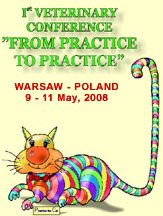
| | |
WSAVA, FECAVA, VICAS Congress 2008
20 - 24 August 2008
Dublin, Ireland
The Veterinary Ireland Companion Animal Society (VICAS) will host the WorldÂs companion animal veterinarians to the 33rd WSAVA Congress and 14th European, FECAVA Congress in 2008 in Dublin, Ireland.
We look forward to welcoming you to Ireland!

| | 
| | |
Course: Internal Medicine & Ophthalmology
Luxembourg
3 - 7 December 2007
This course tackles major issues relevant to daily companion animal veterinary practice. It is based on a systematic approach to disorders related to organ systems and their frequency and significance. Both novel information and proven techniques are covered.
Course masters:
Prof. Dr. Peter Bedford,
Dr. Charlotte Keller,
Dr. Alex J. German,
Dr. Mark Jackson
Course details
| | 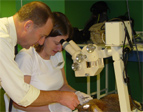
| | |
Course: Rehabilitation and Physiotherapy of Small Animals
Intensive training with workshops for veterinarians and qualified clinic technicians.
14 - 18 April 2008
ESAVS: University of Luxembourg
| | 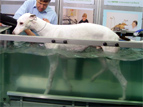
| | |
Veterinary European Equine Meeting - 14th SIVE Congress
Venice, Italy
January 25th-27th, 2008
Owing to the presence of international invited speakers, the congress will be an educational opportunity for both specialised practitioners and students or new graduates.
www.sive.it
______________________
| | 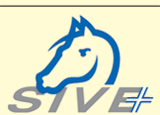
| | |
EVDI Annual Conference - EAVDI / ECVDI Joint Meeting 2008
6 - 9 August 2008
Svolvaer, Norway
European Association of Veterinary Diagnostic Imaging is looking forward to welcome you in Norway.

| | 
| | |
Radiology in Small Animals
Luxembourg
25 - 29 March 2008
This training programme in veterinary radiology is designed for veterinarians who wish to broaden their knowledge in diagnostic radiology of companion animals.
Day 1: Introduction Thorax
Day 2: Thorax
Day 3: Abdomen
Day 4: Appendicular Skeleton
Day 5: Axial Skeleton
Further information:
ESAVS Office
info@esavs.org
www.esavs.org
Fax: +49 6782 4314
| | 
| | |
WCVD6 - World Congress of Veterinary Dermatology 2008, Hong Kong
The World Congress of Veterinary Dermatology in Hong Kong in 2008 will combine the excitement of exotic and luxurious Hong Kong with an innovative scientific program in Veterinary Dermatology.
| | 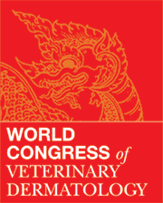
| | |
4th Annual Convention of the Austrian Association of Equine Practitioners
ORTHOPEDICS & WOUND MANAGEMENT
29 February - 2 March 2008
Hotel Loipersdorf Spa & Conference
Stmk, Austria
 Equine Conference Programme Equine Conference Programme
| | 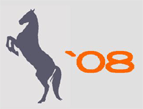
| | |
Course: Radiology in Small Animals
This intensive course in veterinary radiology is designed for veterinarians who wish to broaden their knowledge in diagnostic radiology of companion animals.
Luxembourg
25 - 29 March 2008
Course masters:
Prof. Dr. Paul Barthez
Prof. Dr. Mark FlĂŒckiger
Course programme
| | 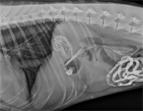
| | |
Reproduction Congress: ISCFR and EVSSAR Joint Meeting 2008
6th International Symposium on Canine and Feline Reproduction (ISCFR) and 6th Biannual Congress of European Veterinary Society for Small Animal Reproduction (EVSSAR)
9 - 11 July 2008
Vienna, Austria
| | 
| | |
SIVE Seminar - Equine
SEMINAR ON EQUINE GASTROENTEROLGY
Malpensa Cavalli
Busto Arsizio (VA), Italy
March 29th 2008
******************
| | 
| | |
BSAVA Congress 2008 - Birmingham, UK
This wide-ranging programme offers four days of scientific excellence through lectures and interactive sessions.
The speakers come from both academia and from practice, so our programme brings you the latest scientific advances as well as essential practical knowledge.
3Â6 April 2008
ICC/NIA Birmingham, UK
BSAVA website
| | 
| | |
4th National Veterinary Pathology Congress - International attendance
29 October - 2 November 2008
Turkey
| | 
| | |
ECVIM-CA Congress
4 - 6 September, 2008
Ghent, Belgium
European College of Veterinary Internal Medicine - Companion Animals

| | 
| | |
SEVC 2008 - Southern European Veterinary Conference in Barcelona, Spain
17-19 October 2008
EARLY BIRD REGISTRATION DEADLINE - 15TH OF SEPTEMBER
Veterinary continuing education event organized by
AVEPA and NAVC

| | 
| | |
RECENT ADVANCES IN REPRODUCTION: Small Animals, Exotic Pets...
Intensive course for veterinarians
15 Â 19 September 2008
Milan / Italy
Organized by ESAVS and EVSSAR
Further information
| | 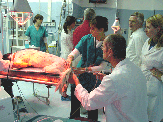
| | |
New trends in feather-picking psittacines
Histologic findings are described for 408 feather-picking or self-mutilating psittacines with the use of biopsies from clinically affected and unaffected skin. Very interesting new insights were found!
Inflammatory skin disease was diagnosed in 210 birds, and traumatic skin disease was diagnosed in 198 birds.
Criteria used for the diagnosis of inflammatory skin disease included the presence of perivascular inflammation in the superficial or deep dermis of clinically affected and unaffected sites.
The primary histologic criteria for the diagnosis of traumatic skin disease were superficial dermal scarring with or without inflammation in the affected sites and an absence of inflammation in the unaffected sites.
The inflammatory cells associated with the lesions were typically lymphocytes and occasionally plasma cells, histiocytes, and granulocytes.
A preponderance of inflammatory skin disease was seen in macaws (Ara spp.) and Amazon parrots (Amazona spp.).
A preponderance of traumatic skin disease was seen in cockatoos (Cacatua spp.) and African grey parrots (Psittacus erithacus).
The prevalence of each was approximately equal in several other species, including conures (Aratinga and Pyrrhura spp.), eclectus parrots (Eclectus roratus), quaker parrots (Myiopsitta monachus), cockatiels (Nymphicus hollandicus), parakeets (Cyanorhamphus and Psittacula spp.), and caiques (Pionites spp.).
No geographic or gender-based trends were identified. These findings could be helpful for identifying and treating birds with feather-picking disorders.
Source: M. M. Garner, S. L. Clubb, M. A. Mitchell and L. Brown (2008): Feather-picking Psittacines: Histopathology and Species Trends. In: Vet Pathol 45:401-408 (2008)
| | | | |
ESVOT Congress 2008
The Cutting Edge in Veterinary Orthopaedics CE
An event of the European Society of Veterinary Orthopaedics and Traumatology.
10 - 14 September 2008
Munich, Germany
| | 
| | |
Eurasia Veterinary Conference - 2009
Bali, Indonesia, 16 - 20 February 2009
Small animal continuing education at one of the world`s most beautiful locations.
Internationally renowned European specialists present the most recent information about current veterinary diagnostics and therapy of small animal internal medicine.
Congress language is English and German in separate sessions.
Further information and registration...

| | 
| | |
ESAVS Courses for Veterinarians and Nurses - 2009
Order the ESAVS free information brochure 2009 and learn more about the veterinary intensive training programs in over 16 disciplines in Europe and Asia.
Small Animals,
Exotic Pets,
Equine Medicine
Course Overview: www.esavs.org
| | 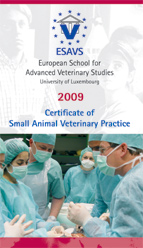
| | |
15th FECAVA EUROCONGRESS
27-28-29 November 2009
Lille, France
| | 
| | |
Three Associations from three Countries are united for a great eventÂ
The FECAVA EUROCONGRESS 2009, organized by AFVAC (France), SAVAB (Belgium) and LAK (Luxembourg).
The scientific programme will include resentations on many topics at comprehensive and advanced levels, given by renowned speakers
from all parts of Europe.
An exciting and warm social programme is planned, with a local touchÂ
Wherever you live and work, you should consider going to the FECAVA EUROCONGRESS 2009!

| | | | |
European Veterinary Dental Society Annual Congress
10-12 September 2009
ZURICH, SWITZERLAND
Hotel Renaissance
Vetsuisse Faculty University Zurich
www.evds-zurich-2009.org
| | 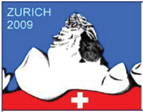
| | |
Horses travel, Diseases spreadÂ

Protecting against Equine Diseases in a Changing International Environment.

Event organized by Fort Dodge  World Equine Leaders  1st to licence a West Nile virus vaccine in Europe
Equine disease seminar in conjunction with the University of Kentucky and University of Padova
10-12 June 2009
Venue: Padova, Italy
View Announcement 
| | 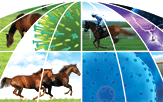
| | |
2nd Veterinary Conference `FROM PRACTICE TO PRACTICE - ...a cat and a dog...`
II Veterinary Conference `FROM PRACTICE TO PRACTICE - ...a cat and a dog
16th - 17th May 2009
Venue: Conference - Congress Center PWSBiA
Warsaw / Poland
Theme: Diseases of urinary and gastrointestinal tracts in dogs and cats
xxxxxxxxxxxxxxxxxxxxxxxxxxxxxxx
| | 
| | |
8th Emergency Care Congress - EVECCS - Berlin 2009
European Veterinary Emergency and Critical Care Society Congress
Berlin, Germany
12-14 June 2009
11 June 2009 Precongress Day
Topic: LET IT FLOW
| | 
| | |
SEVC 2009 - Southern European Veterinary Conference
1-4 October 2009
Barcelona / Spain
Veterinary continuing education event organized by AVEPA and NAVC

| | 
| | |
Courses for Equine Practitioners 2009
Advanced Rehabilitation and Physiotherapy
Neustadt (Dosse) / Germany
10-14 August 2009
Dental Problems in Horses
Hannover / Germany
31 August-4 September 2009
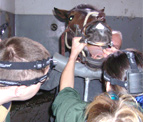
| | 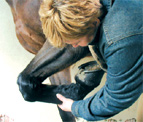
| | |
6th EVSSAR Annual Symposium - Animal Reproduction - 2009
Wroclaw, Poland
6 June 2009
Scientific Program
Abstracts Submission
Registration
EVSSAR website
| | 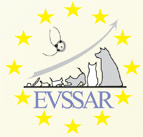
| | |
ASAVA Veterinary Conference 2009 - New Zealand
Christchurch / New Zealand
9Â14 August 2009
Visceral Pleasures:
Gastroenterology,
Cardiology
Urology
Wonderful learning experience that will allow the practitioner to bring their skills up to date in one enjoyable week.
To balance the learning, the ASAVA will provide an amazing social program which will also allow the attendee the feeling of having had a relaxing week off from work.
Christchurch at this time of year offers such delights as skiing, white water rafting, hot air ballooning and wineries.
View Info Flyer
Visit Conference Website

| | 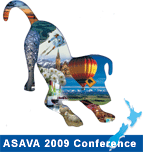
| | |
2009 ACVIM Forum & CVMA Convention
EXCELLENCE IN VETERINARY INTERNAL MEDICINE KNOWS NO BORDERS

In June of 2009, Montréal will be the site of the most important gathering of the veterinary medical community in North America.
The American College of Veterinary Internal Medicine will join with the Canadian Veterinary Medical Association to showcase the latest developments in research, treatment, products and innovations from around the globe.
Montréal, Québec (Canada)
June 3 - 6, 2009
www.ACVIMForum.org
| | | | |
WSAVA 2009 - REGISTRATION FULLY BOOKED
Due to the popularity of the WSAVA Sao Paulo World Congress, all delegate spots are sold out and no further regsitrations can be accepted. If you wish to register in our waiting list you can send an e-mail to: congressos@nielsen.com with your full name and telephone and we will contact you if we have any desistance.
Thank you
WSAVA 2009 - Brazil
| | 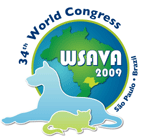
| | |
23rd Annual Veterinary Dermatology Congress of ESVD-ECVD
Bled, Slovenia
17. - 19. September 2009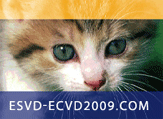
ESVD/ECVD Pre-Congress Symposium16. September 2009
Golf Hotel Bled ******************************** ********************************
| | | | |
ECVIM-CA Congress in Porto / Portugal 2009
This Congress organized by the European College of Veterinary Internal Medicine offers an excellent program with cutting edge information in various disciplines of veterinary medicine.
Porto / Portugal
8 - 10 September 2009

_______________________
| | | | |
ESAVS Courses for Veterinarians and Nurses - 2010
Order the ESAVS free information brochure 2010 and learn more about the veterinary intensive training programs in over 20 disciplines in Europe and Asia.
Small Animals,
Exotic Pets,
Equine Medicine
Course Overview: www.esavs.org
| | 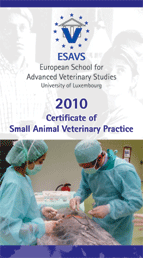
| | |

WSAVA 2010 Congress

35th Annual World Small Animal Veterinary Association Congress
FECAVA
SVK-ASMPA
FAFVAC
2-5 June 2010
Geneva / Switzerland

| | | | |
Novel findings in vitamin B2 deficiency in young chickens
Riboflavin (vitamin B2) deficiency in young chickens produces a demyelinating peripheral neuropathy - a fact that is known over decades. In this Australian study on very young chickens fed with a riboflavin-deficient diet it could be shown for the first time that riboflavin deficiency in young, rapidly growing chickens produces selective injury to peripheral nerve trunks, with relative sparing of spinal nerve roots and distal nerve branches to muscle and skin...
In this study, day-old broiler meat chickens were fed a riboflavin-deficient diet (1.8 mg/kg) and killed on posthatch days 6, 11, 16, 21, and 31, while control chickens were given a conventional diet containing 5.0 mg/kg riboflavin.
Pathologic changes were found in sciatic, cervical, and lumbar spinal nerves of riboflavin-deficient chickens from day 11 onwards, characterized by endoneurial oedema, hypertrophic Schwann cells, tomacula (redundant myelin swellings), demyelination/remyelination, lipid deposition, and fibroblastic onion bulb formation.
Similar changes were also found in large and medium intramuscular nerves, although they were less severe in the latter.
However, by contrast, ventral and dorsal spinal nerve roots, distal intramuscular nerves, and subcutaneous nerves were normal at all time points examined.
These findings demonstrate, for the first time, that riboflavin deficiency in young, rapidly growing chickens produces selective injury to peripheral nerve trunks, with relative sparing of spinal nerve roots and distal nerve branches to muscle and skin.
These novel findings suggest that the response of Schwann cells in peripheral nerves with riboflavin deficiency differs because either there are subsets of these cells in, or there is variability in access of nutrients to, different sites within the nerves.
Source: Z. Cai, P. C. Blumbergs, J. W. Finnie, J. Manavis and P. D. Thompson (2009): Selective Vulnerability of Peripheral Nerves in Avian Riboflavin Deficiency Demyelinating Polyneuropathy. In: Vet Pathol 46:88-96 (2009)
| | | | |
Esophagitis after removal of esophageal foreign bodies
Foreign bodies in the esophagus are not rare in dogs - especially wooden sticks, bones or toys can be found there. At first of course it is important to remove the foreign body in these patients. In this study including 60 dogs the presence of esophagitis in dogs after esophagoscopy for diagnosis and treatment of esophageal foreign body and a relationship between the degree of esophageal injury and the clinical signs and outcome were evaluated.
Medical records of 60 dogs with esophageal foreign bodies diagnosed between January 1999 and December 2003 were reviewed.
Information obtained from the medical records included age, breed, and sex; type and duration of clinical signs; physical examination, radiographic, and esophagoscopy findings; type and location of foreign body; surgical intervention; morbidity, and outcome.
Animals were divided into 2 cohorts based upon the degree of esophageal injury detected during esophagoscopy: mild esophagitis or moderate-to-severe esophagitis. Data were then compared between the groups.
Results: Dogs with moderate-to-severe esophagitis had a longer duration of clinical signs, were more likely to present for lethargy and regurgitation/vomiting, and had a longer time to recovery.
This cohort had significantly greater morbidity including esophageal stricture, perforation, necrosis, and diverticulum formation, as well as aspiration pneumonia, pneumothorax, severe tracheal compression, and death.
Dogs with mild esophagitis were more likely to present to the hospital for gagging.
Conclusions: This study demonstrated a wide range of injury associated with esophageal foreign bodies. The degree of esophagitis appears to relate to the duration and severity of some of the clinical signs.
Source: Alexandre Rousseau, Jennifer Prittie, John D. Broussard, Philip R. Fox, James Hoskinson (2007): Incidence and characterization of esophagitis following esophageal foreign body removal in dogs: 60 cases (1999Â2003). In: Journal of Veterinary Emergency and Critical Care Volume 17 Issue 2, Pages 159 - 163
| | | | |
XVII. Annual Conference CSAVA
FAULTS AND MISTAKES IN SMALL VETERINARY PRACTICE
24thÂ25th October 2009
Hradec Krålové
Czech Republic
Lectures will be given in English (simultaneous translation into Czech) and Czech
| | | | |
2nd FASAVA 2009 - Veterinary Congress in Asia
The first joint effort of WSAVA, NAVC, FASAVA.
The biggest event in Asia!
3-5 November 2009
Bangkok / Thailand
www.fasava2009.com
| | 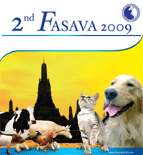
| | |
EVDI Annual Conference 2010
21-25 July 2010
Giessen, Germany
Faculty of Veterinary Medicine
diagnostic imaging in veterinary medicine
Congress of EAVDI, ECVDI and Faculty of Veterinary Medicine Justus-Liebig-University in Giessen.
EAVDI - European Association of Veterinary Diagnostic Imaging
ECVDI - European College of Veterinary Diagnostic Imaging
SCIENTIFIC PROGRAM:
State of the art lectures, international presentations and courses concerning the field of diagnostic imaging in veterinary medicine (x-ray, ultrasonography, CT, MRI, szintigraphy, radiation oncology).
SOCIAL PROGRAM:
Welcome Reception
Mathematikum
Excursion to Marburg
Oldtimer Meeting
Farewell Dinner Castle Rauischholzhausen
LOCAL ORGANIZER:
Prof. Dr. M. Kramer
Department of Veterinary Clinical Sciences
Clinic for Small Animals Surgery
Justus-Liebig-University
Frankfurter Strasse 108
35392 Giessen / Germany
Phone: +49 641 99 38 501
Fax: +49 641 99 38 509
E-mail: martin.kramer[at]vetmed.uni-giessen.de
ORGANIZATION:
For further information please contact
CSM
Congress and Seminar Management
Industriestr. 35
82194 Groebenzell / Germany
Phone: +49 8142 570 183
E-mail: info@csm-congress.de
| | 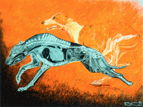
| | |
European Veterinary Conference `the Voorjaarsdagen`
22-24 April 2010
Amsterdam, The Netherlands

| | 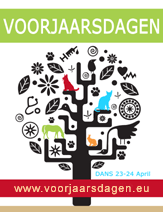
| | |
VEPRA Conference 2010
Veterinary European Physical Therapy and Rehabilitation Association
Physical therapy of the stifle
15th - 16th May 2010
Zagreb, Croatia
| | 
| | |
ACVIM Congress 2010
The highest standards of care for your patients while pushing the envelope of discoveries in internal medicine.
ACVIM Forum
9-12 June 2010
Anaheim, California, USA
| | 
| | |
III VETERINARY CONFERENCE - FROM PRACTICE TO PRACTICE
Warsaw / Poland
21 May 2010
Symposium
22-23 May 2010
Conference
... a cat and a dog, to be continuedÂ
Program & Registration
| | 
| | |
5th Turkish Veterinary Pathology Congress with International Contribution
14-18 September 2010
Bursa, Turkey
| | 
| | |
European Veterinary Ophthalmology Conference
13th  16th May 2010
Dublin, Ireland
| | 
| | |
Veterinary Oncology  ESAVS Intensive Course
This course is designed for veterinarians wishing to broaden their knowledge in diagnosis and how to treat oncological diseases.
Participants are welcome to prepare some interesting cases from their own practice to consult with the specialists during the 5-day training.

European School for Advanced Veterinary Studies
12-16 July 2010
Luxembourg
Course details
| | 
| | |
SEVC Congress 2011
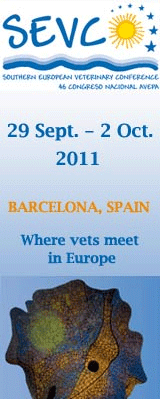
| | | | |
20th ECVIM-CA Annual Congress - 2010
9 - 11 Septembre 2010
Toulouse / France
Expect high scientific level talks on various topics in internal medicine given by experts in their respective field!
| | 
| | |
European Congress of Veterinary Dentistry
25-26 September 2010
Nice, France
The Congress is an educational and scientific meeting for veterinarians with an interest in dentistry, oral medicine and oral surgery.
*******************************
| | 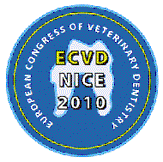
| | |
24th Congress of the European Society and College of Veterinary Dermatology
ESVD-ECVD Congress
23-25 September 2010
Florence - Italy
********************************
| | 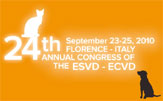
| | |
ESVD-ECVD Pre-Congress Symposium
22 September 2010
ALBANI HOTEL
Firenze - Italy
**********************************
| | 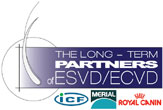
| | |

MOST FREQUENT MISTAKES AND FAULTS IN SMALL ANIMAL VETERINARY ONCOLOGY
XVIII. Annual Conference of the Czech Small Animal Veterinary Association (CSAVA)
Congress Centre Aldis, Hradec Krålové
Czech Republic
October 9thÂ10th 2010
| | 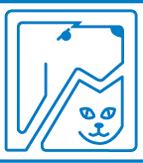
| | |
PractiVet - Moscow, Russia 2011
| | 
| | |
House dust mites in the environment of atopic dogs
About 80% of the atopic dogs have a positive reaction to house dust mites either in the intradermal skin test or in the in vitro tests. This interesting study from Greece was designed to investigate the presence and density of domestic mites (DMs) in households with atopic dogs sensitive to these mites (group A; n = 20), in households with clinically healthy, nonatopic dogs (group B; n = 20) and in households without pets (group C; n = 25). One interesting result: No differences were found between households with and without dogs.
Dust samples were vacuum-collected from the owner mattress (all groups) and dog sleeping area (groups A and B) or living room couch (group C) on four consecutive occasions, reflecting the four seasons of the year. ÂŽ
DMs were found, at least once, in 19 of 20 (95%) group A, 13 of 20 (65%) group B and 21 of 25 (84%) group C households.
DM numbers per gram of dust were 0Â159 (median, 8.8), 0Â302 (median, 3) and 0Â1473 (median, 6.9) for group A, B and C, respectively.
Dermatophagoides farinae predominated in all groups, since it was identified in 60% of group A, 40% of group B and 64% of group C households.
Dermatophagoides pteronyssinus was found in 45%, 35% and 48% of households, in group A, B and C, respectively.
No differences were found between households with (groups A and B) or without dogs (group C).
When considering both sampling sites together, frequency of DM recovery was higher in group A than in group B (P = 0.044).
Also, both mite frequency (P = 0.011) and density (P = 0.015) in dog sleeping area were higher in group A than in group B.
In conclusion, presence and density of DMs is higher in the microenvironment of mite-sensitive dogs with atopic dermatitis than in that of clinically healthy nonatopic dogs.
Source: Farmaki, R., Saridomichelakis, M. N., Leontides, L., Papazahariadou, M. G., Gioulekas, D. and Koutinas, A. F. (2010), Presence and density of domestic mites in the microenvironment of mite-sensitive dogs with atopic dermatitis. Veterinary Dermatology, 21: 469Â476. doi: 10.1111/j.1365-3164.2010.00891.x
| | | | |
7th World Congress of Veterinary Dermatology 2012
24 - 28 July 2012
Vancouver, Canada
| | 
| | |
AFVAC Congress 2010 - Paris
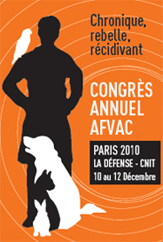
| | | | |
17th FECAVA Eurocongress 2011
Istanbul, Turkey
7-10 September 2011
As the meeting point between Asia and Europe, Istanbul signifies the aims of FECAVA and this unique veterinary event - to advance the profession, strengthen community, and facilitate communication between colleagues.
| | 
| | |
ACVIM Forum - Denver 2011
15 - 18 June 2011
Denver (CO) / USA
The premier event featuring leading-edge veterinary internal medicine, strong educational programming, and unparalleled networking opportunities.
| | 
| | |
ESVD-ECVD Annual Congress 2011
European Veterinary Dermatology Congress
Brussels / Belgium
8th - 10th September 2011
Square Brussels Meeting Center
| | 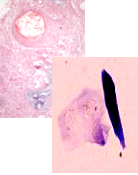
| | |
ESAVS Courses for the Veterinary Profession - 2011
Order the ESAVS free information brochure 2011 and learn more about the veterinary intensive training programs in over 20 disciplines in Europe and Asia.
Small Animals,
Exotic Pets,
Equine Medicine
Course Overview: www.esavs.org
| | 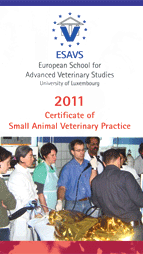
| | |
European Veterinary Conference 2011
Amsterdam
27-29 April 2011
| | 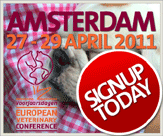
| | |
IV Veterinary Conference FROM PRACTICE TO PRACTICE
Warsaw / Poland
...dog & cat - on four paws
13 May 2011
Pre-Conference Symposia
13-15 May 2011
Conference
Program & Registration
| | 
| | |
11th EAAV and 1st ECZM Conference 2011
Avian and Zoological Medicine Meeting
26-30 April 2011
Madrid / Spain
| | 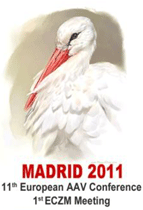
| | |
2nd VEPRA Conference 2011 - Physical therapy of the spinal cord
17-18 September 2011
Warsaw / Poland
This conference will be dedicated to therapeutic approaches to neurological rehabilitation.
| | 
| | |
Classified Ads - Standard, Premium and Top-Users
You can choose between standard, premium and top user classifieds:
Standard User * - 0 âŹDuration 6 weeks
âą Max. 400 signs (inlcuding empty spaces)
Additional Standard Advertisement * - 90 ⏠(plus VAT 19%)Duration 6 weeks
âą Max. 400 signs (inlcuding empty spaces)
Premium User ** - 150 ⏠(plus VAT 19%)Duration 12 weeks
âą Length max. 2048 letters per classified (including spaces)
âą Displayed before the standard user classifieds
âą With upload of a picture
âą With text formatting
âą Modifiable at any time
âą Additional classifieds possible
Each classified 150 ⏠(plus VAT 19%)
âą Implementation, technical support included
Top User *** - 190 ⏠(plus VAT 19%)Duration 12 weeks
âą After activation of user space and payment receipt online
âą Length max. 5000 letters per classified (including spaces)
âą Displayed before the standard and premium user classifieds
âą With upload of a picture
âą With text formatting
âą With link to your website
âą Modifiable at any time
âą Additional classifieds possible
Each classified 190 ⏠(plus VAT 19%)
âą Implementation, technical support included
Please contact us to place an advertisement: contact@vetcontact.com / +49 6782-980 650
| | | | |
Terms and Conditions
Disclaimer
1. Content
VetContact GmbH reserves the right not to be responsible for the topicality, correctness, completeness or quality of the information provided. Liability claims regarding damage caused by the use of any information provided, including any kind of information which is incomplete or incorrect, will therefore be rejected. All offers are not-binding and without obligation. Parts of the pages or the complete publication including all offers and information might be extended, changed or partly or completely deleted by VetContact GmbH without separate announcement.
2. Referrals and links
VetContact GmbH is not responsible for any contents linked or referred to from his pages - unless he has full knowledge of illegal contents and would be able to prevent the visitors of his site from viewing those pages. If any damage occurs by the use of information presented there, only the author of the respective pages might be liable, not the one who has linked to these pages. Furthermore VetContact GmbH is not liable for any postings or messages published by users of discussion boards, guestbooks, classified ads, calendar of events or mailinglists provided on VetContacts page.
3. Copyright
VetContact GmbH intended not to use any copyrighted material for the publication or, if not possible, to indicate the copyright of the respective object. The copyright for any material created by VetContact GmbH is reserved. Any duplication or use of objects such as diagrams, sounds or texts in other electronic or printed publications is not permitted without the authors agreement.
4. Privacy policy
If the opportunity for the input of personal or business data (email addresses, name, addresses) is given, the input of these data takes place voluntarily. The use and payment of all offered services are permitted - if and so far technically possible and reasonable - without specification of any personal data or under specification of anonymizated data or an alias.
5. Legal validity of this disclaimer
This disclaimer is to be regarded as part of the internet publication which you were referred from. If sections or individual terms of this statement are not legal or correct, the content or validity of the other parts remain uninfluenced by this fact.
| | | | |
DOUBLE COURSE DEAL - FELINE
Feline Medicine I & II 2011
10-day intensive training program offered by ESAVS
BenalmĂĄdena (MĂĄlaga) / Spain
Gastroenterology and Urinary Tract Diseases
22 â 26 August 2011
and/or
Infectious Diseases
29 Aug. â 2 Sept. 2011
Further information: info@esavs.org
| | 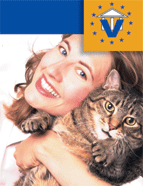
| | |
20th European Congress of Veterinary Dentistry
1-3 September 2011
Chalkidiki / Greece
The European Congress of Veterinary Dentistry is an educational and scientific meeting for veterinarians with an interest in dentistry, oral medicine and oral surgery.
| | 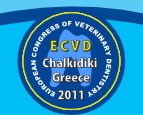
| | |
7th International Symposium of Veterinary Rehabilitation and Physical Therapy
15-18 August 2012
University of Veterinary Medicine
Vienna / Austria
This unique symposium is a meeting point for everybody who is interested in physical therapy, sports medicine, rehabilitation, surgery, orthopedic, neurology, biomechanics and motion analysis.
| | 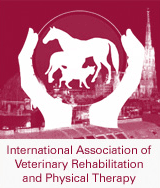
| | |
European Veterinary Conference - Voorjaarsdagen 2012
5-7 April 2012
Amsterdam / Netherlands
| | 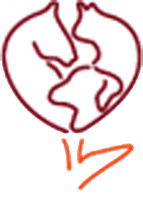
| | |
AFVAC, AVEF and SNVEL - Joint Annual Congress 2011
2 - 4 December 2011
Lyon Convention Centre
France
| | 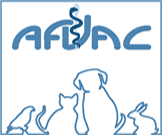
| | |
Eurasia Veterinary Conference 2012
| | 
| | |
Garfield is turning back the clock
In his latest animation, Garfield puts a stop to the affects of middle age and the associated risk of chronic kidney disease, which can cause symptoms in cats aged 7 years and older: Watch the video on YouTube.
Further Information
| | 
| | |
21st European Congress of Veterinary Dentistry
This congress is an educational and scientific meeting for veterinarians with an interest in dentistry, oral medicine and oral surgery.
Lisbon , Portugal
24th - 27th May 2012
| | 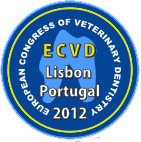
| | |
ESAVS Courses for the Veterinary Profession - 2012
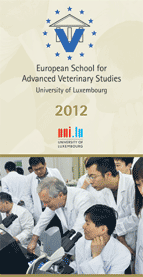
Order the ESAVS free information brochure 2012 and learn more about the veterinary intensive training programs in over 20 disciplines in Europe and Asia.
Small Animals,
Exotic Pets,
Equine Medicine
Course Overview: www.esavs.org
| | | | |
11th Congress of the European Veterinary Emergency and Critical Care Society
EVECCS Congress
(14)15-17 June 2012
Barcelona, Spain
From basic to cutting edge, lectures will attract all of you interested in veterinary emergency and critical care.
Main topic: Care of the Neurological Patient
| | 
| | |
5th Annual PractiVet Congress 2012
| | 
| | |
Optimizing MRI results of the spine
Magnetic resonance (MR) imaging is generally considered to be the best imaging modality for the spine because of its excellent tissue contrast and multiplanar imaging capability; however, good technique is vital in order to avoid nondiagnostic or even misleading images. This publications gives a variety of helpful advices to optimize the results!
The possibility of imaging in multiple planes and using many different pulse sequences means that judgment is required in order to gain maximum diagnostic information within a reasonable scanning time.
Spinal MR imaging technique for small animals is reviewed with emphasis on technical aspects including patient positioning, selection of pulse sequences, and image planes.
Source: DENNIS, R. (2011), OPTIMAL MAGNETIC RESONANCE IMAGING OF THE SPINE. Veterinary Radiology & Ultrasound, 52: S72âS80. doi: 10.1111/j.1740-8261.2010.01787.x
| | | | |
SEVC 2012
| | 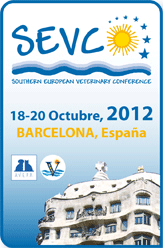
| | |
22nd European Congress of Veterinary Dentistry and 12th World Veterinary Dental Congress
23rdâ26th May 2013
Prague - Czech Republic
Contnuing Educaton with bite!
www.ecvd.info
| | 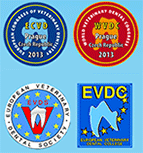
| | |
| | | | |
FECAVA Congress 2014
Munich/ Germany
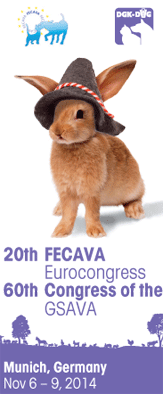
| | | | |
WVEPAH Courses
World Veterinary Education in Production Animal Health :
Chicken,
Turkey,
Egg Layer,
Water Fowl.
Information about course programs and registration available at: www.wvepah.org
| | 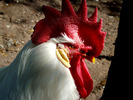
| | |
EVDS-EVDC European Veterinary Dental Congress 2014
The European Veterinary Dental Society (EVDS) and the European Veterinary Dental College (EVDC) are happy to invite you to a very special congress. Combine education with leisure, social life and excursions to special locations along the coast of the Mediterranean see. Take the chance of spending a few days with your family in combination with educating yourself
The Cruise Dates:
6-10 May 2014 from Marseille
| | 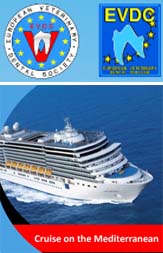
| | |
ESAVS Courses for the Veterinary Profession - 2013
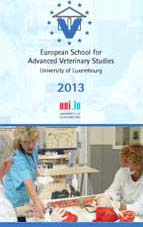
Order the ESAVS free information brochure 2013 and learn more about the veterinary intensive training programs in over 20 disciplines in Europe and Asia.
Small Animals,
Exotic Pets,
Equine Medicine
Course Overview: www.esavs.org
| | | | |
Check out what is happening at the frontier of fertility control for dogs and catsĂąâŹÂŠ
Did you miss the Alliance for Contraception in Cats and Dogs 5th International Symposium on Non-Surgical Contraceptive Methods for Pet Population Control in June? Attendees gave it 4.7 out of 5 stars! Hereâs another chance. Nearly all sessions are available on videotape or as Powerpoint presentations with speakersâ narration, recorded live! Those, plus conference & session summaries, abstracts, reports, photos, speaker bios, and more, available online free of charge. Be one of those in the know about this emerging field.
| | 
| | |
Long-Term Partners Pre-Congress Symposium - ESVD / ECVD 2013
Mittwoch, 18 September 2013
Hotel Las Arenas
Valencia (Spanien)
| | 
| | |
SEVC 2013
Southern European Veterinary Conference
17-19 October 2013
Barcelona, Spain
Where vets meet in Europe!
Again in 2013, more than 200 lectures by more than 100 world-wide experts will cover every aspect of companion animal veterinary care.
Spanish and English are the SEVCâs official languages and simultaneous translation will be provided at all lectures. At some lectures, simultaneous translation into French, Russian, Portuguese and Polish will also be provided.
| | 
| | |
ESAVS Courses for the Veterinary Profession - 2015
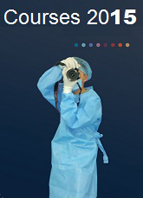
Order the ESAVS free information brochure 2015 and learn more about the veterinary intensive training programs in over 20 disciplines in Europe and Asia.
Small Animals,
Exotic Pets,
Equine Medicine
Course Overview: www.esavs.org
| | | | |
ACVIM 2014
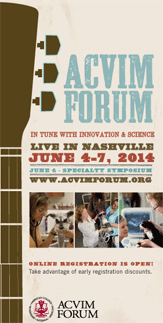
| | | | |
Vetmadrid 2014 - Veterinary Congress in Spain
13-15 March 2014
Madrid, Spain
North Convention Centre
Parque Ferial Juan Carlos I
| | 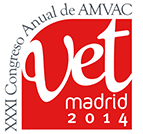
| | |
European Veterinary Conference Voorjaarsdagen 2014
April 17-19, 2014
Amsterdam
The Netherlands
| | 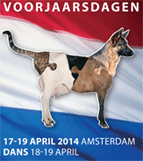
| | |
CongressMed 2014
| | 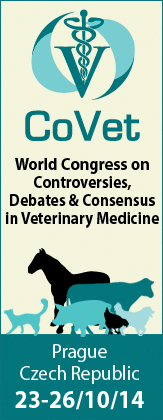
| | |
ESAVS - Neuropathology & MRI
| | 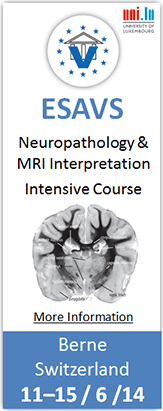
| | |
VetContact
| | | | |
VetAgenda
| | | | |
SEVC 2014
Southern European Veterinarian Conference
Southern European Veterinarian Conference
| | 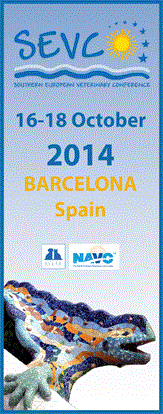
| | |
Lab in Practice - Clinical Pathology
| | | | |
Study for an academic degree in your chosen discipline: go for the European Master Program!
The following Master degrees are currently offered:
Internal Medicine
Surgery
Dermatology
Ophthalmology
Dentistry
Cardiology
Neurology
Oncology
Diagnostic Imaging
Feline Medicine And Surgery

| | 
| | |
| | 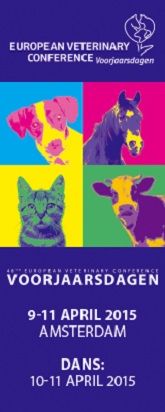
| | |
| | 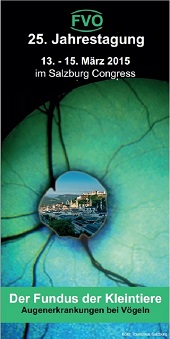
| | |
| | 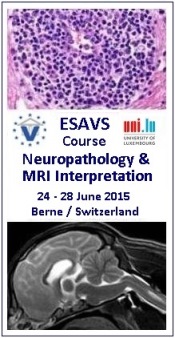
| | |
RoVECCS Emergency and Critical Care Congress, 20 - 21 March 2015, Bucharest / Romania
| | 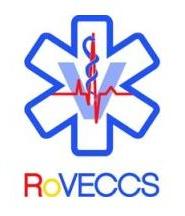
| | |
SEVC / FECAVA 2015
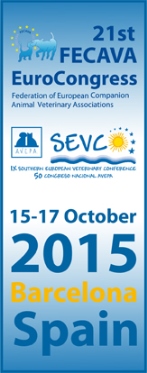
| | | | |
25th European Congress of Veterinary Dentistry
19-22 May 2016
Dublin / Ireland
| | 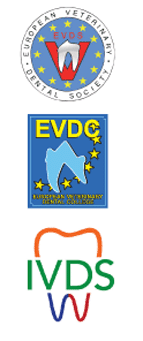
| | |
NOW OPEN: SCHOLARSHIP APPLICATIONS WCVD8
The World Association for Veterinary Dermatology (WAVD) is proud to announce that it has increased the number of scholarships available for financial support to encourage veterinarians with limited access to continuing education in veterinary dermatology to attend WCVD8. 30 scholarships will be funded for 2016.
There are no geographic restrictions placed on potential applicants, however a particular emphasis will be placed on providing veterinarians with genuine financial need the opportunity to participate in the Congress. The WAVD aims to promote the global development of veterinary dermatology and expects that selected applicants will use knowledge and skills acquired at the Congress to advance veterinary dermatology in their geographic region.
The scholarship consists of free full registration to WCVD8 and an allowance towards travel and accommodation of US $1000 dollars.
See the website www.WAVD.org for selection criteria.
SUBMIT YOUR APPLICATION ON-LINE WWW.WAVD.ORG
APPLICATION DEADLINE: DECEMBER 1, 2015
APPLICANTS INFORMED: DECEMBER 31, 2015
ENQUIRIES: EMAIL: info@wavd.org
| | 
| | |
EEVC - 1st Eastern European Veterinary Conference 2016
Advancing the veterinary profession in Eastern Europe
Belgrade, Serbia
October 6th â 8th, 2016
| | 
| | |
8th World Congress of Veterinary Dermatology
| | 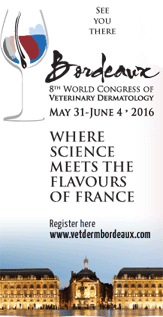
| | |
12th Conference of the European Wildlife Disease Association (EWDA)
27 - 31 August 2016
Berlin, Germany
This biannual conference aims to foster the exchange of knowledge and ideas between wildlife scientists from different disciplines, to present the latest advances and to stimulate future research. To this aim, the selected plenary talks and workshops will cover a diverse range of fascinating topics.
| | 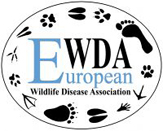
| | |
SEVC 2016
AVEPA (Spanish Association for Small Animal Veterinarians), in collaboration with the NAVC (North American Veterinary Community), will again host the Southern European Veterinarian Conference - SEVC. And for the first time the conference will take place in Granada, Spain, 20 to 22 October 2016.
| | 
| | |
ESAVS Courses for the Veterinary Profession - 2017
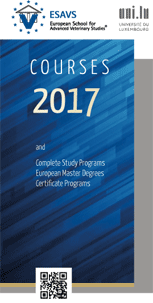
Order the ESAVS free information brochure 2017 and learn more about the veterinary intensive training programs in over 20 disciplines in Europe and Asia.
Small Animals,
Exotic Pets,
Equine Medicine
Course Overview: www.esavs.org
| | | | |
ACVIM Forum 2017 - Innovation, Science and Beyond
| | 
| | |
EUROPEAN VETERINARY DENTAL FORUM
18th to 21st May 2017
Malaga / Spain
Education with bite!
| | 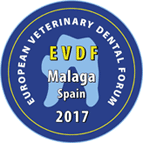
| | |
WSAVA and FECAVA 2017 Congress
| | 
| | |
Join the 11th Eurasia Veterinary Conference at the island Zanzibar, Tansania 2018
| | 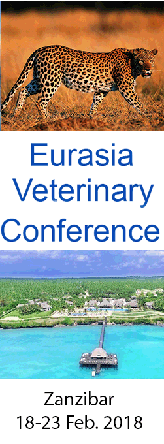
| | |
Surgical Conference Purinapartners, Moscow, Russia, September 8-9, 2017
| | 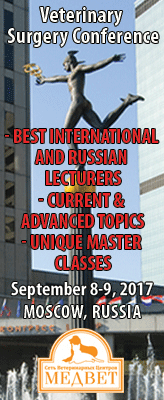
| | |
ESVN-ECVN Symposium 2018
We welcome you to wonderful Copenhagen where we will entertain you with stimulating scientific sessions, neuronal networking and out-of-this world experiences.
The theme is: Evidence-based Neurology: Neuro signs to Neuroscience - and back
| | 
| | |
25th FECAVA EuroCongress 4-9 September 2019, St. Petersburg / Russia
the best veterinary practices, the world-known lecturers, the unique place...

| | | | |
ESAVS
| | 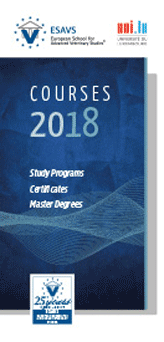
| | |
WSAVA 2019

| | | | |
European Master of Small Animal Veterinary Medicine
| | 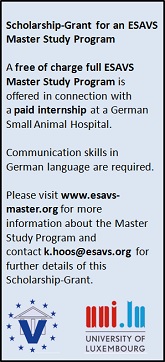
| | |

|
|













